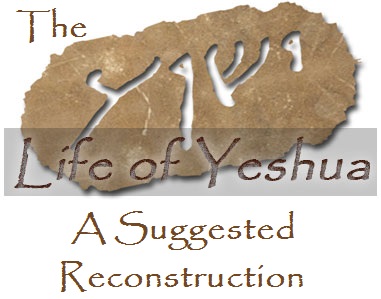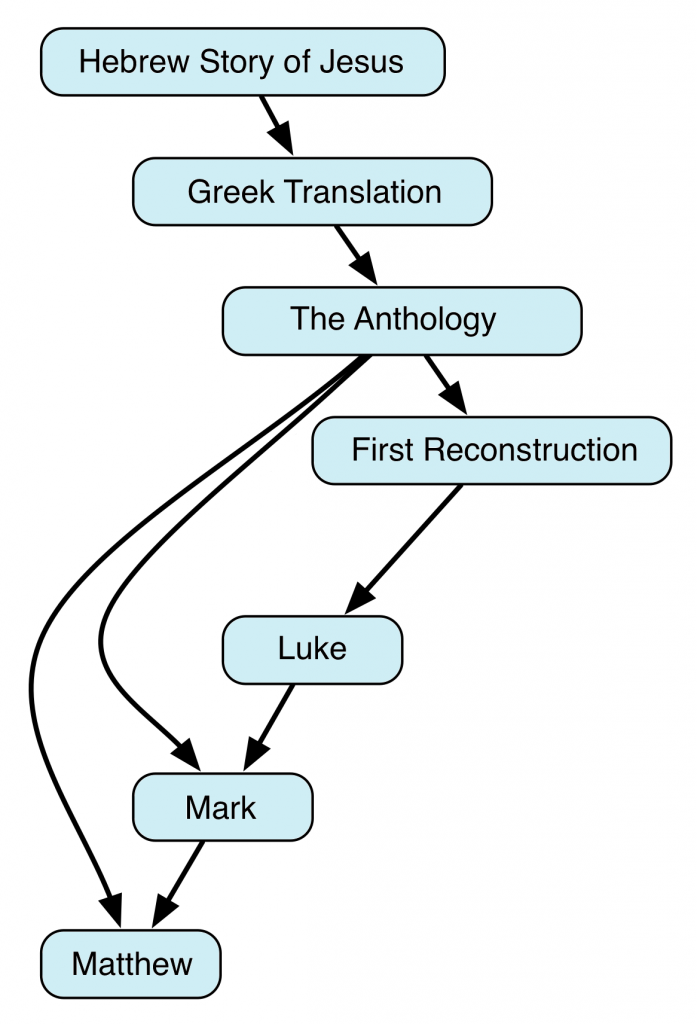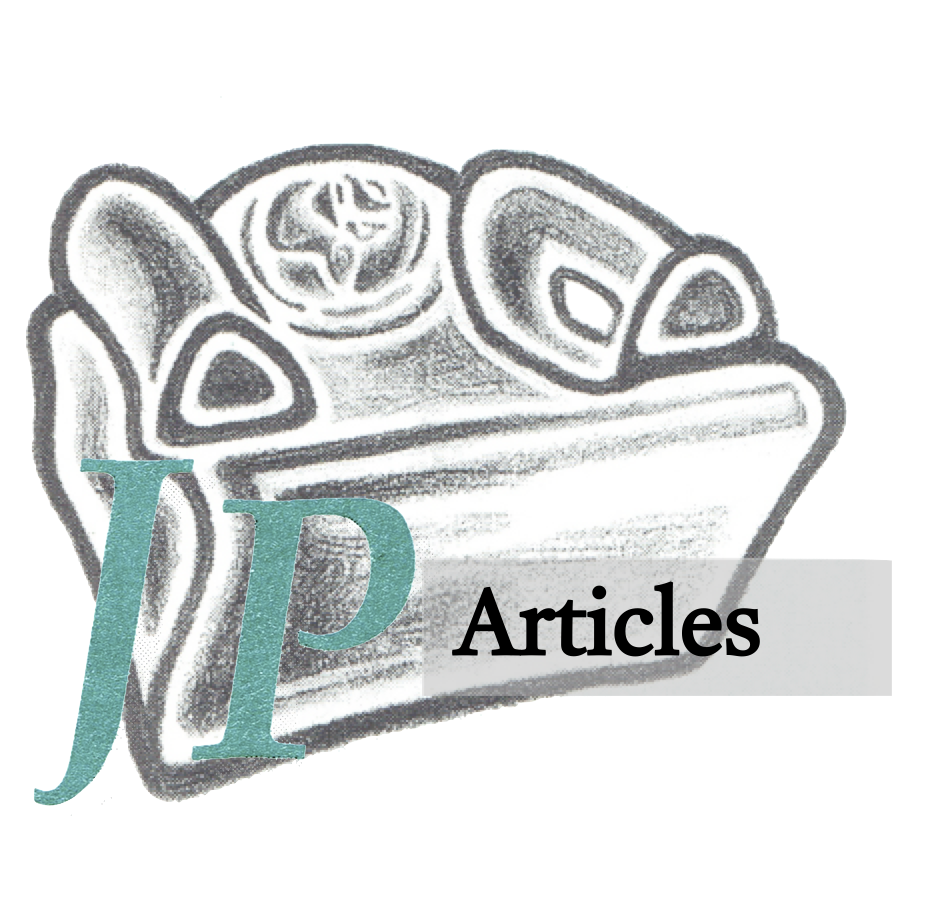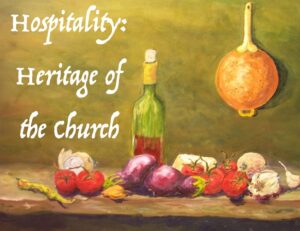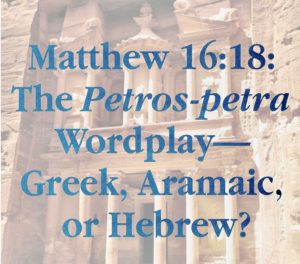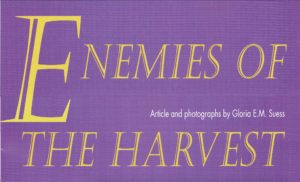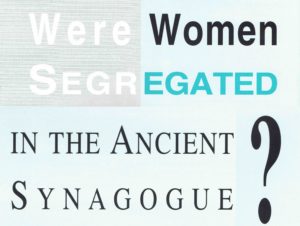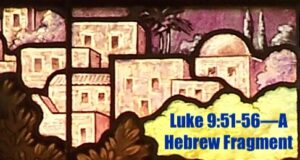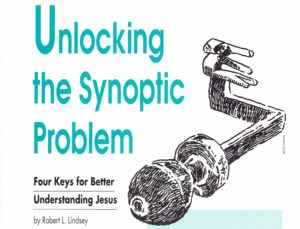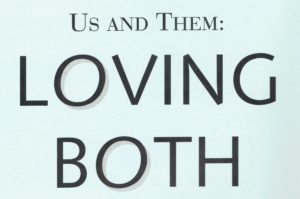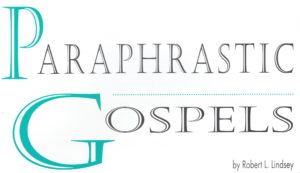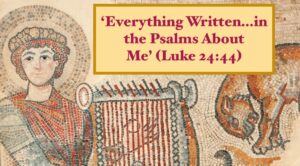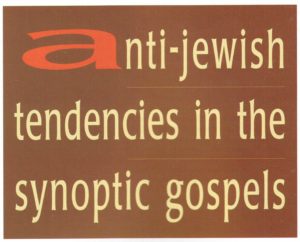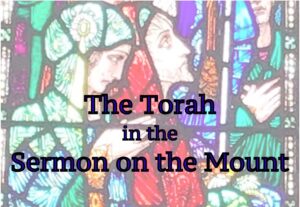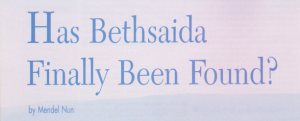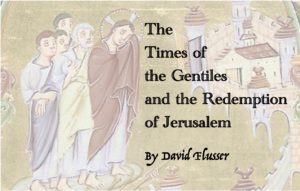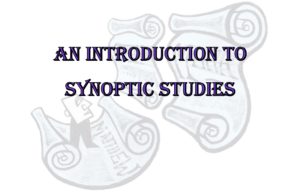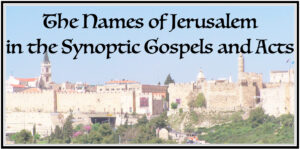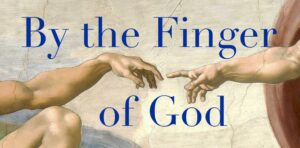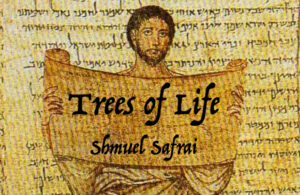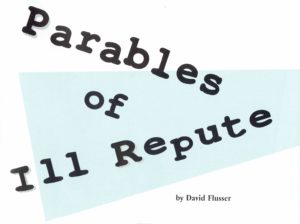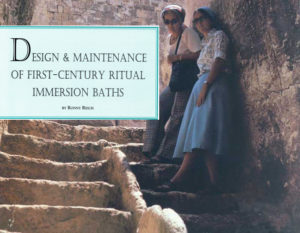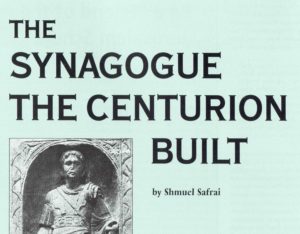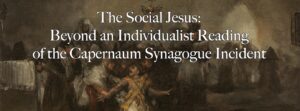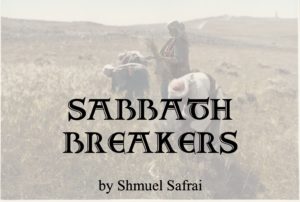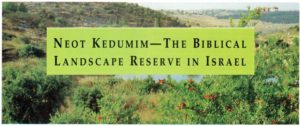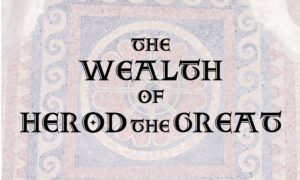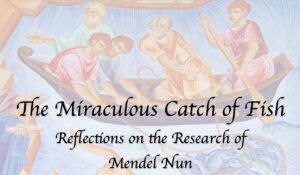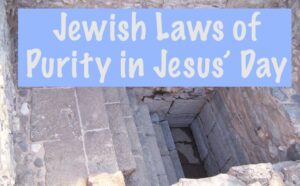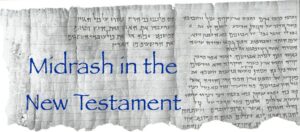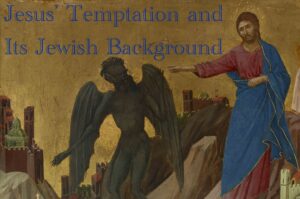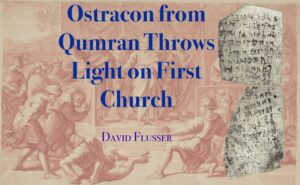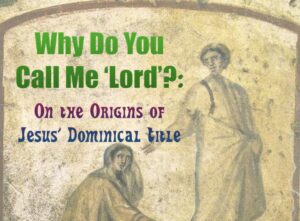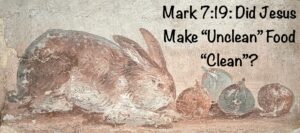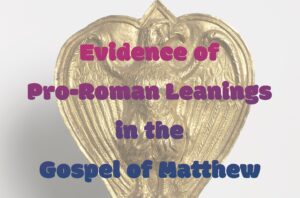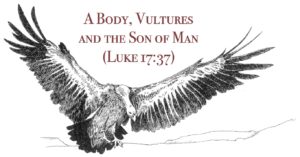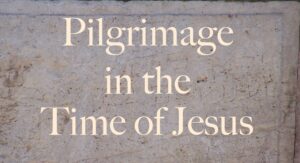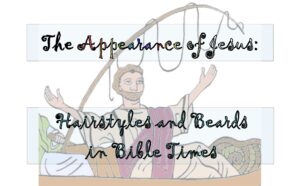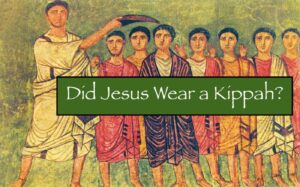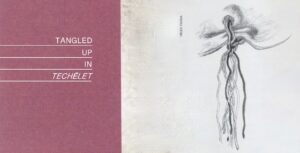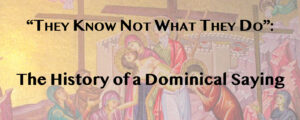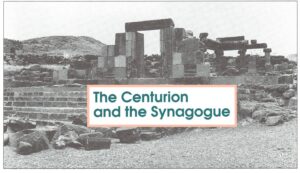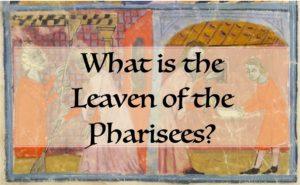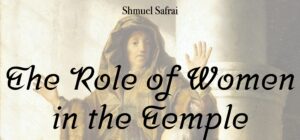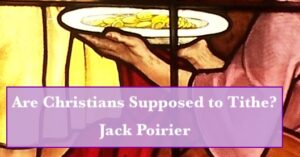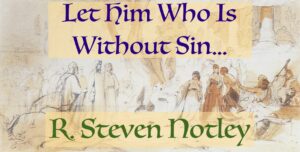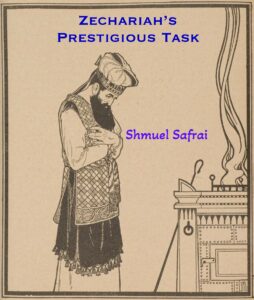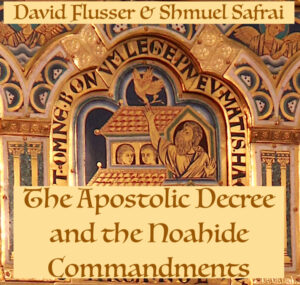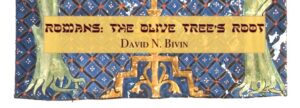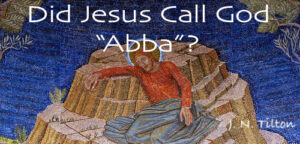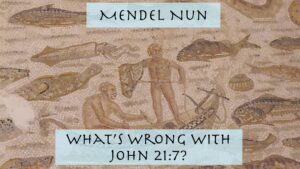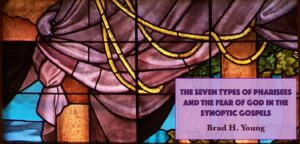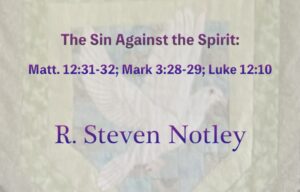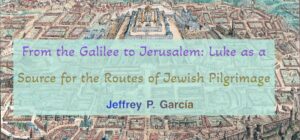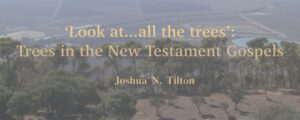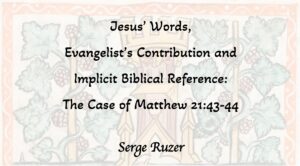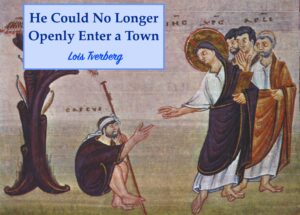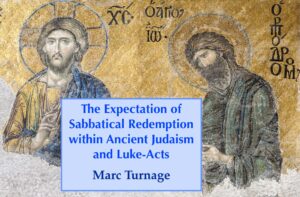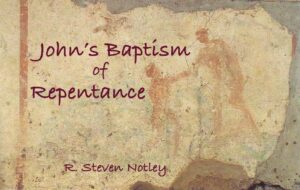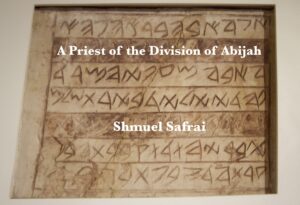Matt. 24:15-16, 19-22; Mark 13:14, 17-20; Luke 21:20-24
(Huck 216; Aland 290; Crook 328)[1]
Updated: 5 December 2024
וּבִזְמָן שֶׁאַתֶּם רוֹאִים אֶת יְרוּשָׁלַיִם מוּקֶּפֶת הַגּוֹיִם דְּעוּ שֶׁהִגִּיעַ חָרְבָּנָהּ וּמִי שֶׁבְּתוֹכָהּ יִבְרַח וּמִי שֶׁבַּשָּׂדֶה אַל יִכָּנֵס לָהּ שֶׁיְּמֵי נָקָם אֵלּוּ כְּדֵי לְקַיֵּים אֶת כָּל הַכְּתוּבִים אִי לָעוּבָּרוֹת וְלַמֵּנִיקוֹת בְּאוֹתָם הַיָּמִים שֶׁתִּהְיֶה צָרָה גְדוֹלָה עַל הָאָרֶץ וְכַעַס לָעָם הַזֶּה וְיִפְּלוּ לְפִי חֶרֶב וְיִשָּׁבוּ אֶל הַגּוֹיִם וִירוּשָׁלַיִם תִּהְיֶה רְמוּסָה בְּיַד הַגּוֹיִם עַד שֶׁיִּשְׁלְמוּ קִצֵּי הַגּוֹיִם
“But when you see Yerushalayim besieged by Gentiles, rest assured that the hour of her destruction has come at last. Whoever is inside Yerushalayim at that time should flee. And no one outside the walls when the siege closes in should enter the city. For these are days of vengeance, in order to fulfill all the Scripture passages concerning it.
“Alas for the pregnant women and the nursing mothers when all this takes place! For there will be great distress in the land of Israel as God’s wrath is poured out on our people. Some will be killed, and some will go into captivity to foreign places. And the Gentiles will trample Yerushalayim until their times are complete.[2]
| Table of Contents |
|
3. Conjectured Stages of Transmission 5. Comment 8. Conclusion |
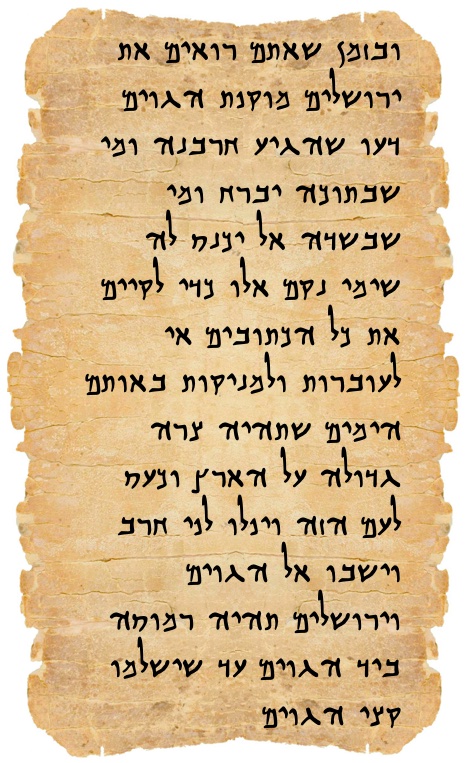
Reconstruction
To view the reconstructed text of Yerushalayim Besieged click on the link below:
| “Destruction and Redemption” complex |
| Temple’s Destruction Foretold ・ Tumultuous Times ・ Yerushalayim Besieged ・ Son of Man’s Coming ・ Fig Tree parable |
Story Placement
In the Gospel of Luke, between Tumultuous Times (Luke 21:10-11) and Yerushalayim Besieged (Luke 21:20-24), there appears a series of sayings dealing with the hostility Jesus expected his followers would encounter as they bore witness to him (Luke 21:12-19). There are three reasons for supposing that the sayings in Luke 21:12-19 are extraneous to Jesus’ original prophecy of destruction and redemption. First, in Luke 21:12-19 the audience is clearly limited to the followers of Jesus, whereas the rest of the prophecy of destruction and redemption is addressed to and concerns the general public of Jerusalem (see Luke 21:5-7). Second, Luke 21:12-19 is out of chronological sequence, for according to Luke 21:12 the hostilities Jesus’ followers will endure will happen before the things described in Tumultuous Times. Thus, the flashback in Luke 21:12-19 interrupts the progression of events, which is not resumed until Yerushalayim Besieged (Luke 21:20-24).[3] Third, each of the sayings in Luke 21:12-19 either has a doublet elsewhere in Luke or has a parallel in parts of Matthew outside Matthew’s eschatological discourse (Matt. 24).[4] The parallels to Luke 21:12-19 in other parts of Luke and/or Matthew strongly suggest that these sayings were originally unrelated to Jesus’ prophecy of destruction and redemption. The combined evidence leads us to the conclusion that the sayings in Luke 21:12-19 were secondarily inserted between Tumultuous Times and Yerushalayim Besieged by a redactor of the synoptic materials. We have accordingly omitted Luke 21:12-19 (and the Markan and Matthean parallels) from our reconstruction of the “Destruction and Redemption” complex.
In the Gospels of Mark and Matthew the placement of Yerushalayim Besieged is the same as in Luke, but since their versions of this pericope have been so heavily redacted (mostly by the author of Mark), Yerushalayim Besieged is no longer an apt title for the Markan and Matthean parallels to Luke 21:20-24. A better name for the pericope consisting of Mark 13:14-20 ∥ Matt. 24:15-22 might be Abomination of Desolation, since it is the appearance of this mysterious object (or person?)—not the siege of Jerusalem as in Luke—that sets in motion the events described in the Markan and Matthean versions of this pericope.
For an overview of the “Destruction and Redemption” complex, click here.
.
.
Click here to view the Map of the Conjectured Hebrew Life of Yeshua.
.
.
Typically, our Story Placement discussions focus on where a given pericope is placed in relation to other pericopae in a particular Gospel or in the pre-synoptic sources. Here, however, it will also be useful to discuss a different kind of story placement, namely where each of the Gospel writers and the authors of the pre-synoptic sources saw themselves chronologically placed in relation to the events described in Yerushalayim Besieged (or Abomination of Desolation in Mark and Matthew). In other words, it is necessary to assess whether a given writer placed the events described in Yerushalayim Besieged/Abomination of Desolation in the past, the present or the future.
If, as we suppose, the core prophecy of destruction and redemption, which was still preserved in Anth., originated with Jesus,[5] then all the events described in the “Destruction and Redemption” complex were envisioned as taking place in the future. The First Reconstructor’s “updating” of Jesus’ prophecy by inserting sayings about the difficulties Jesus’ followers would face gives us an important clue regarding where the First Reconstructor saw himself within the timeline of Jesus’ prophecy. The First Reconstructor’s insertion of Like Lightning (Luke 21:8-9) into the prophecy suggests that he was living at a time when false prophets and messianic pretenders had gathered followings in Judea. Such events are known to have occurred by the mid-40s C.E.[6] The First Reconstructor’s insertion of the sayings in Luke 21:12-19 that describe hostility toward Jesus’ followers interrupts the chronological progression of the prophecy. It is a flashback to events that are to take place before the appearance of signs that the Temple’s destruction is at hand. The urgency of these sayings and the fact that the First Reconstructor took the trouble to insert them into Jesus’ prophecy suggest that the hostilities were recent and perhaps ongoing events for the First Reconstructor and his readers. Another change the First Reconstructor made to the prophecy is the addition of a directive to “those in Judea” to flee to the mountains (Luke 21:21) (see below, Comment to L11-12). This addition suggests that the First Reconstructor sought to make Jesus’ warnings to the people of Jerusalem relevant to a wider audience consisting of believing congregations scattered throughout Judea. Paul’s epistle to the Thessalonians attests to the presence of persecuted congregations in Judea ca. 50 C.E. (1 Thess. 2:14). It therefore seems likely that the First Reconstructor updated Jesus’ prophecy to reflect the conditions his community was experiencing in the early to mid-50s C.E. Thus, for the First Reconstructor the destruction of the Temple still loomed in the future.

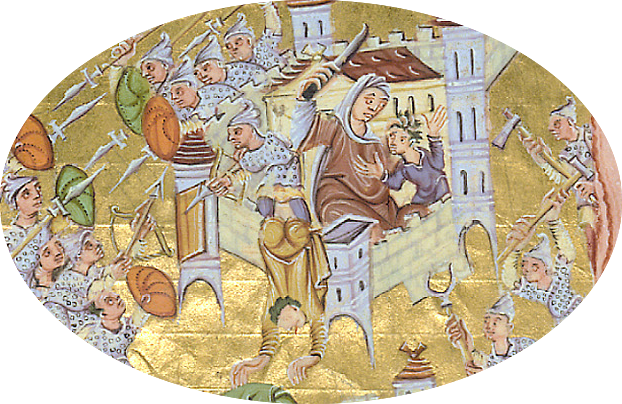
Our identification of the First Reconstructor’s present in the middle of the first century C.E. explains why FR’s version of Yerushalayim Besieged does not contain specific details about Jerusalem’s destruction as it actually happened in 70 C.E.[7] The description of Jerusalem’s fall in Luke 21:20-24 is so generic as to describe almost any Roman siege.[8] It does not contain an account of the terrible famine that killed so many of Jerusalem’s inhabitants. Neither does it describe how the Temple was burned. The prophecy does not even challenge the popular opinion that the Temple was the most secure part of the city. There were those in Jesus’ time who believed that even if Jerusalem fell, the Temple would remain inviolate.[9] But in 70 C.E. the Temple fell to the Romans first. And while the lower city was soon subdued, the upper city continued to resist for another month after the Temple was destroyed.[10] The reason such details are absent from FR’s prophecy is that the destruction had not yet taken place. The prophecy predicted what anyone might anticipate;[11] the unforeseeable particulars of 70 C.E. and surprises no one expected are understandably absent.
The author of Luke made changes to FR’s prophecy that indicate where he thought he belonged in the prophecy’s chronology. As we discussed in the commentary to Tumultuous Times, the author of Luke rearranged the order of catastrophes in order to show that some of the signs that the Temple’s destruction was approaching had already begun to manifest themselves (namely earthquakes and famine). Thus, for the author of Luke the Temple’s destruction was still in the future, but he believed that its downfall was imminent. Since the events recorded in Acts take us up to the years 62-64 C.E., and since the author of Luke probably completed his two-volume work shortly after the events he described, we may suppose that the author of Luke composed his Gospel before the outbreak of the Jewish revolt in 66 C.E.[12] A pre-70 C.E. date for Luke’s Gospel explains why the author of Luke was unable to add to the prophecy any historical details about the destruction of the Temple and the fall of Jerusalem.[13] When the author of Luke composed his Gospel, the destruction of the Temple was still in the future.

Just as the redactional activity of the First Reconstructor and the author of Luke offers clues to where each writer saw himself in the chronology of Jesus’ prophecy, so the author of Mark’s editorial interventions likely indicate where he saw himself in the prophecy’s chronological scheme. While Markan redaction is pervasive throughout the prophecy, the character of Mark’s redaction drastically changes in Mark 13:14-20. At this point the author of Mark’s redactional activity becomes so intense that, as we noted above, Yerushalayim Besieged is no longer a fitting title for his version of this pericope. The author of Mark replaced Luke’s wording with apocalyptic imagery (i.e., “the abomination of desolation”) and sectarian language (i.e., “the elect”). The author of Mark’s reworking of Yerushalayim Besieged also hints that his revisions offer a retrospective view of what happened in 70 C.E. The author of Mark was careful to have Jesus speak in the future tense, but when the author of Mark inserted a comment of his own (Mark 13:20), he described the time of intense suffering that happened in the wake of the appearance of the abomination of desolation in the past tense: the Lord cut those days off for the sake of the elect (see below, Comment to L55). The author of Mark’s insertion of a second version of Like Lightning at Mark 13:21-23 probably indicates that these verses describe current events for the author of Mark and his readers. These verses are given special emphasis, with Jesus stating that, having warned the disciples in advance about these things, they must be on their guard (Mark 13:23). Likewise, Mark 13:24 suggests that Mark’s readers were living in the time between the great tribulation and the beginning of the end. At any time the cosmic order would be upset and the Son of Man would send his angels to gather the elect. The author of Mark understood himself to be living in the eye of the storm. The intense suffering occasioned by the destruction of Jerusalem had passed; what remained of the universe might crumble at any moment.[14] It thus appears that Mark’s Gospel was composed in the wake of the Temple’s destruction, at a time when the recollection of those traumatic events still provoked a visceral response from his readers.

Matthew’s chronological standpoint is surprising. The author of Matthew’s most extensive redaction of Mark’s material occurs in the section describing the hostilities Jesus’ followers will encounter before the abomination of desolation appears (Matt. 24:9-14). While the author of Matthew acknowledges that Jesus’ followers will encounter hostilities from the outside, he was more concerned about betrayals, false teaching, lawlessness and defections within his community. Matthew’s description of internicene strife is similar to the eschatological forecast in the final chapter of the Didache (Did. 16:1-8), according to which the church will be riddled with lawlessness and betrayal. According to Matt. 24:14, the gospel must be preached to all nations, and then the end will come.[15] Thus, the author of Matthew saw himself living at a time before the end when the gospel was being proclaimed but the church was beset with inner conflicts.[16]
According to the author of Matthew, once the gospel has been proclaimed to all nations, the end will come about as a response to the appearance of the abomination of desolation. The abomination of desolation will spark a chain reaction of tribulation for the elect, the upset of the cosmic order, and the coming of the Son of Man to gather the elect and punish the wicked.[17] From this we learn that the author of Matthew envisioned the abomination of desolation as a future event.[18] But this does not mean that Matthew’s version of Jesus’ prophecy is pre-70 C.E. On the contrary, the author of Matthew reworked Mark’s post-70 C.E. version of the prophecy to suit his own purposes. Rather than being ignorant of the events of 70 C.E., it appears that for the Matthean community the events of 70 C.E. had little or no significance. Perhaps those events had taken place so long ago that Matthew’s readers had learned to adjust to the new circumstances and needed to recalibrate their eschatological timetable. Or perhaps the Matthean community was so utterly estranged from the Jewish people that it regarded the destruction of the Temple and the fall of Jerusalem as irrelevant. Or perhaps both factors were at play. In any case, Matthew’s eschatological timeline is remarkable in that the destruction of the Temple in 70 C.E. is regarded as an insignificant event of the past (it does not even merit a reference in Matthew’s version of Jesus’ prophecy), but the abomination of desolation is nevertheless regarded as a future event.[19] In any case, our conclusions regarding the author of Matthew’s view of his chronological placement of Jesus’ prophecy are consistent with our dating of Matthew’s Gospel to the late first or early second century C.E.[20]

Recognizing that different chronological schemes are represented in the various versions of Jesus’ prophecy is crucial for understanding each version of the prophecy on its own terms.
Conjectured Stages of Transmission
There are two prevailing opinions with respect to the transmission of Yerushalayim Besieged. Either Luke’s version is a thoroughgoing revision of Mark’s,[21] or in addition to Mark the author of Luke relied on some other source for his version of Yerushalayim Besieged.[22] These opinions reflect 1) the fact that there is a wide divergence between the Lukan and Markan (and Matthean) versions of Yerushalayim Besieged and 2) the assumption of Markan Priority. Lindsey’s hypothesis combines the insights of these two prevailing opinions but provides a new twist: Luke’s version of Yerushalayim Besieged is based on a non-Markan source, and radical revision does account for the divergence between the Lukan and Markan versions, but it was not the author of Luke who reworked Mark, it was the author of Mark who reworked Luke.
The reason the author of Mark so radically reworked Luke’s Yerushalayim Besieged, transforming it into Abomination of Desolation, is that he viewed Yerushalayim Besieged in light of his post-70 C.E. experience through an apocalyptic lens. The author of Matthew similarly adapted Mark’s version of Abomination of Desolation to conform to his worldview and experience.
Crucial Issues
- What (or who) was “the abomination of desolation”?
- Why does Matthew’s version mention fleeing on the Sabbath?
- Does Yerushalayim Besieged contain an authentic prophecy of Jesus, or were the events of 70 C.E. projected back onto Jesus by the authors of the Gospels and their sources?
Comment
L1 καὶ ὅταν ἴδητε (GR). All three Gospels are agreed on the words ὅταν (hotan, “when”) and ἴδητε (idēte, “you might see”) in L1. Where they differ is with regard to the conjunction between these two words. Whereas Luke and Mark have δέ (de, “but”), Matthew has οὖν (oun, “therefore”). Matthew’s conjunction looks like a Greek stylistic improvement that the author of Matthew introduced in order to make a tighter connection with the preceding verse. In Matt. 24:14 the author of Matthew has Jesus declare that once the Gospel has reached all the Gentiles the end will come. The οὖν in Matt. 24:15 implies that the appearance of the abomination of desolation is the beginning of the end,[23] which, for the author of Matthew and his readers, still lay in the future.
We think it is likely that δέ, too, is a Greek stylistic improvement introduced by the First Reconstructor into Yerushalayim Besieged. If so, the δέ was passed along from FR to Luke and from Luke to Mark. If δέ in L1 stems from FR, presumably Anth. had the conjunction καί (kai, “and”) before ὅταν, which is the reading we have adopted for GR.
וּבִזְמָן שֶׁאַתֶּם רוֹאִים (HR). In LXX ὅταν + subjunctive often occurs as the translation of -בְּ + infinitive construct.[24] In Mishnaic Hebrew, however, the use of -בְּ + infinitive construct was discontinued, being replaced by -כְּשֶׁ + verb.[25] However, the phrase -בִּזְמָן שֶׁ (bizmān she-, “in a/the time that”) was an even more common way of expressing “when” in Mishnaic Hebrew than -כְּשֶׁ (keshe-, “as that,” “when that”), with numerous examples of -בִּזְמָן שֶׁ appearing in the Mishnah in answer to the question אֵמָתַי (’ēmātai, “When?”).[26] Moreover, we find a precise grammatical parallel to our reconstruction (-בִּזְמָן שֶׁ + you see ___→imperative) in the following example:
בזמן שאתה רואה רשעים שרבו כמו עשב…צפה לימות המשיח
When you see wicked persons, that they have increased like grass…look for the days of the anointed one [i.e., the Messiah—DNB and JNT]. (Midrash Tehillim 92:10 [ed. Buber, 309])
On reconstructing ἰδεῖν (idein, “to see”) with רָאָה (rā’āh, “see”), see Widow’s Son in Nain, Comment to L10.
Hebrew has no exact equivalent to the subjunctive mood. The present context calls for either a future verb or a participle. In the rabbinic parallel quoted above a participle is used with reference to the future. Our reconstruction follows suit.
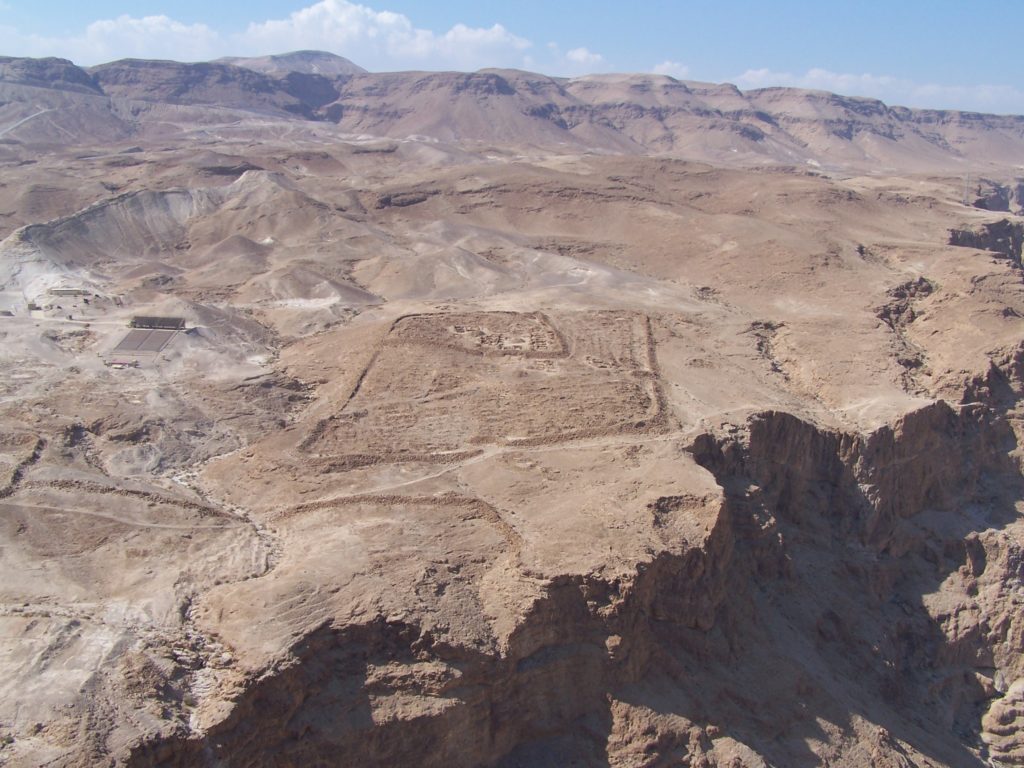
L2-4 κυκλουμένην ὑπὸ στρατοπέδων Ἰερουσαλήμ (Luke 21:20). As Dodd observed, “It will hardly be argued that the mere expression κυκλουμένην ὑπὸ στρατοπέδων [‘surrounded by camps’—DNB and JNT], describes Titus’s siege so precisely that it must necessarily be a ‘vaticinium ex eventu’ [i.e., a prophecy after the event—DNB and JNT]. If you want to say in Greek ‘Jerusalem will be besieged’, the choice of available expressions is strictly limited, and κυκλοῦσθαι ὑπο στρατοπέδων is about as colorless as any.”[27] Predicting a siege of Jerusalem should not have been difficult for Jesus, who was sensitive to (and critical of) the direction the political winds were blowing. There is no a priori reason why Jesus could not have made such a prediction, and the hesitation of some scholars to trace back to Jesus the prediction of Jerusalem’s siege in Luke 21:20 is mainly due to their assumption that Luke is dependent upon Mark. The assumption of Markan Priority leads many scholars to the further assumption that the author of Luke must have rewritten Jesus’ prophecy in light of the events of 70 C.E. We do not share these assumptions. Rather, it appears to us that the author of Luke transmitted an authentic prediction of Jesus that Jerusalem would fall in a Roman siege, and it was the author of Mark who dropped the description of the siege in order to replace it with the apocalyptic image of the abomination of desolation. The author of Matthew subsequently adopted Mark’s reworked version of Jesus’ prophecy.
L2 Ἰερουσαλὴμ κυκλουμένην (GR). Luke’s word order in L2-4 is un-Hebraic. We suspect this un-Hebraic word order is due to the First Reconstructor’s editorial activity. For GR we have relocated the noun Ἰερουσαλήμ (Ierousalēm, “Jerusalem”), which in Luke appears in L4, to a more Hebraic position in L2.
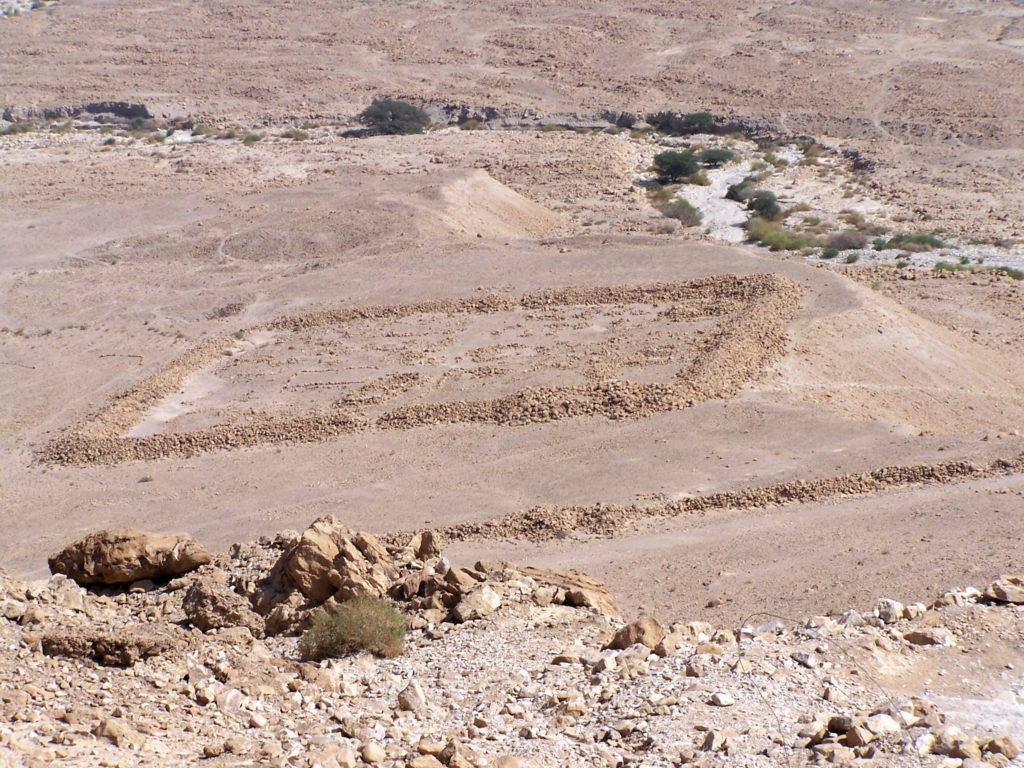
אֶת יְרוּשָׁלַיִם מוּקֶּפֶת (HR). On reconstructing Ἰερουσαλήμ (Ierousalēm, “Jerusalem”) as יְרוּשָׁלַיִם (yerūshālayim, “Jerusalem”), see Yeshua’s Testing, Comment to L65. Note that Ἰερουσαλήμ is the Hebraic form of the name Jerusalem. Greek authors often preferred the Hellenized form Ἱεροσόλυμα (Hierosolūma). While the use of the Hebraic form Ἰερουσαλήμ in no way proves that Luke 21:20 is ultimately derived from a Hebrew source, it does at least allow for this intriguing possibility.[28]
In LXX the verb κυκλοῦν (kūkloun, “to surround”) usually occurs as the translation of verbs formed from the ס-ב-ב root.[29] Likewise, the LXX translators more often rendered ס-ב-ב verbs as κυκλοῦν than as any other Greek equivalent.[30] Nevertheless, in the context of a siege, verbs from the root נ-ק-פ are more appropriate, as the following examples demonstrate:
והוא לכול מבצר ישחק ויצבור עפר וילכדהו פשרו על מושלי הכתיאים אשר יבזו על מבצרי העמים ובלעג ישח{ו}קו עליהם ובעם רב יקיפום לתפושם
And he laughs at every fortress, and he heaps up dust and captures it [Hab. 1:10]. Its interpretation concerns the rulers of the Kittim [i.e., the Romans—DNB and JNT],[31] who disdain the fortresses of the people and with scorn laugh at them and with a great people they besiege them [יקיפום] to capture them. (1QpHab IV, 3-7)
וְעַל אֵילּוּ מַתְרִיעִים בַּשַּׁבָּת עַל עִיר שֶׁהִיקִּיפוּהָא גוֹיִם
And on account of these they sound the warning on the Sabbath: on account of a city that Gentiles have besieged [שֶׁהִיקִּיפוּהָא]…. (m. Taan. 3:7)
עיר שהקיפוה גוים …וכן היחיד שהיה נרדף מפני גוים…הרי אילו מחללין את השבת ומצילין את עצמן
A city that the Gentiles besieged [שהקיפוה]…and also an individual who was pursued by Gentiles…. Behold! These profane the Sabbath and save themselves. (t. Eruv. 3:8; Vienna MS)
וכשבא אספסיאנוס והקיף את ירושלים….
When Vespasian came and besieged [והקיף] Jerusalem…. (Avot de-Rabbi Natan, Version B, §7 [ed. Schechter, 20])
Whereas in the examples above we find נ-ק-פ in the active hif‘il stem, for HR we have adopted a passive hof‘al participle. The feminine participle מוּקֶּפֶת (mūqefet, “besieged,” “surrounded”) is well attested in rabbinic sources. For instance, in the Mishnah we read of הַגַּנָּה…מוּקֶּפֶת גָּדֵר (haganāh…mūqefet gādēr, “a garden…surrounded by a fence”; m. Eruv. 2:5; cf. m. Edu. 2:4) and חָצֵר שֶׁהִיא מוּקֶּפֶּת אַכְסַדְרָא (ḥātzēr shehi’ mūqepet ’achsadrā’, “a courtyard that is surrounded by a peristyle”; m. Suk. 1:10; m. Ohol. 14:4). Likewise, in the Tosefta we encounter the question ′היכן מצינו לשושן הבירה שמוקפת חומ (“Where do we find concerning Shushan, the capital, that it was surrounded by a wall?”; t. Meg. 1:1; Vienna MS). In Yerushalayim Besieged, instead of being surrounded for its protection, as in the examples just cited, Jerusalem is surrounded by Roman encampments.
In LXX there are a few examples where κυκλοῦν (“to surround”) occurs as the translation of הִקִּיף (hiqif, “surround,” “besiege”):
וְהִקַּפְתֶּם עַל הַמֶּלֶךְ סָבִיב אִישׁ וְכֵלָיו בְּיָדוֹ
…and you must encircle the king all around, each man with his weapons in his hand…. (2 Kgs. 11:8)
καὶ κυκλώσατε ἐπὶ τὸν βασιλέα κύκλῳ, ἀνὴρ καὶ τὸ σκεῦος αὐτοῦ ἐν χειρὶ αὐτοῦ
…and you must encircle the king all around, each man with his weapon in his hand…. (4 Kgdms. 11:8)
וְהִקִּיפוּ הַלְוִיִּם אֶת הַמֶּלֶךְ סָבִיב אִישׁ וְכֵלָיו בְּיָדוֹ
And the Levites will encircle the king all around, each man with his weapons in his hand. (2 Chr. 23:7)
καὶ κυκλώσουσιν οἱ Λευῖται τὸν βασιλέα κύκλῳ, ἀνδρὸς σκεῦος ἐν χειρὶ αὐτοῦ
And the Levites will encircle the king all around, each man with a weapon in his hand. (2 Chr. 23:7)
בָּנָה עָלַי וַיַּקַּף רֹאשׁ
He built against me and encircled [my] head…. (Lam. 3:5)
ἀνῳκοδόμησεν κατ᾿ ἐμοῦ καὶ ἐκύκλωσεν κεφαλήν μου
He built up against me and encircled my head…. (Lam. 3:5)
There is also an example where περικυκλοῦν (perikūkloun, “to encompass,” “to surround”), a compound form of κυκλοῦν, occurs as the translation of הִקִּיף:
וַיִּשְׁלַח שָׁמָּה סוּסִים וְרֶכֶב וְחַיִל כָּבֵד וַיָּבֹאוּ לַיְלָה וַיַּקִּפוּ עַל הָעִיר
And he sent there horses and chariots and a great army, and they came by night and lay siege against the city. (2 Kgs. 6:14)
καὶ ἀπέστειλεν ἐκεῖ ἵππον καὶ ἅρμα καὶ δύναμιν βαρεῖαν, καὶ ἦλθον νυκτὸς καὶ περιεκύκλωσαν τὴν πόλιν
And he sent there horses and chariots and a mighty force, and they came by night and surrounded the city. (4 Kgdms. 6:14)
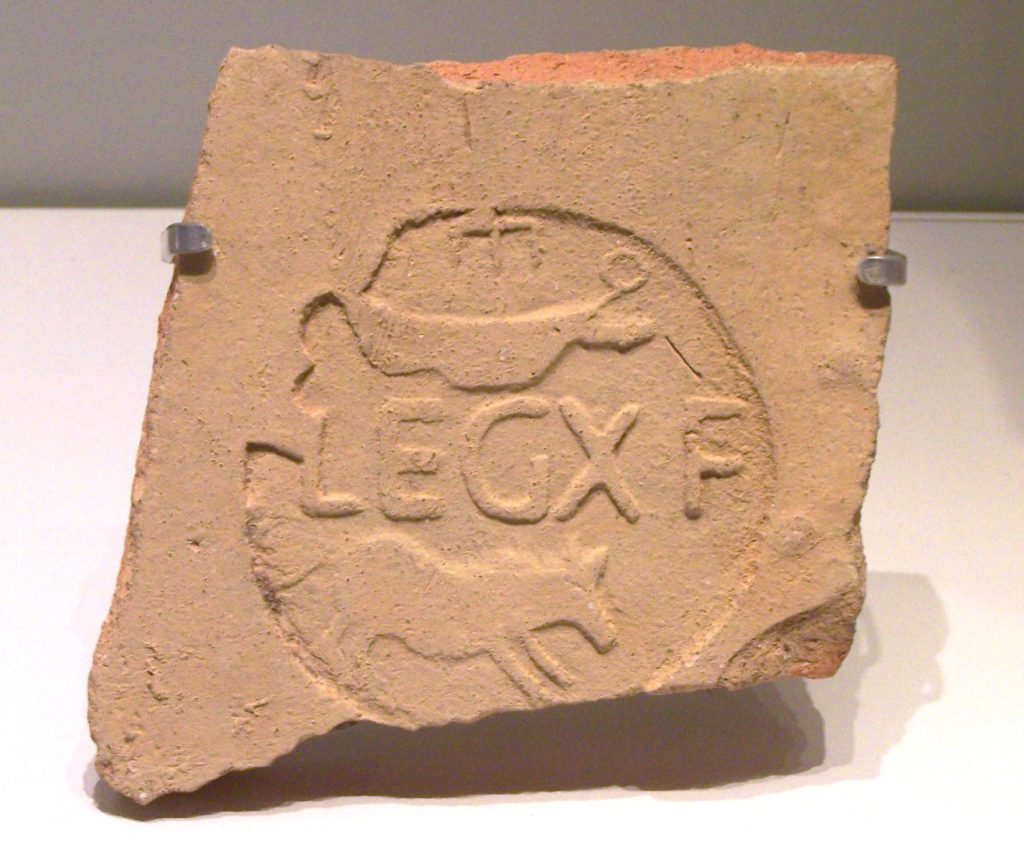
L3 ὑπὸ ἐθνῶν (GR). In LXX στρατόπεδον (stratopedon, “camp,” “encamped army”) is quite rare and only occurs twice where there is a Hebrew equivalent.[32] These two instances are both in Jeremiah, where στρατόπεδον once occurs as the translation of חַיִל (ḥayil, “army”; Jer. 41[34]:1) and once as the translation of אִישׁ (’ish, “man”; Jer. 48[41]:12). Delitzsch, quite understandably, rendered στρατόπεδον in Luke 21:20 with מַחֲנֶה (maḥaneh, “camp”), but we never read in rabbinic sources of a city surrounded by camps (neither עִיר מוּקֶּפֶת מַחֲנוֹת nor עִיר שֶׁהִקִּיפוּהָ מַחֲנוֹת). On the other hand, in the examples collected in Comment to L2 we do read of cities surrounded by Gentiles. This observation caused us to notice that in the rest of Yerushalayim Besieged the agents of Jerusalem’s destruction are identified as Gentiles (L44, L46, L49). Perhaps, therefore, the antagonists in L3 were originally identified as Gentiles, too. If Anth. had read ὑπὸ ἐθνῶν (hūpo ethnōn, “by Gentiles”) in L3, the author of Luke or, more likely, the First Reconstructor may have considered “surrounded by Gentiles” too bland a description and replaced it with the more vivid ὑπὸ στρατοπέδων (hūpo stratopedōn, “by encampments”).
Another reason for supposing that Jesus’ prophecy originally referred to Jerusalem being surrounded by Gentiles is that such a description would be reminiscent of a prophecy in Zechariah:
וְאָסַפְתִּי אֶת כָּל הַגּוֹיִם אֶל יְרוּשָׁלִַם לַמִּלְחָמָה וְנִלְכְּדָה הָעִיר וְנָשַׁסּוּ הַבָּתִּים וְהַנָּשִׁים תשגלנה [תִּשָּׁכַבְנָה] וְיָצָא חֲצִי הָעִיר בַּגּוֹלָה וְיֶתֶר הָעָם לֹא יִכָּרֵת מִן הָעִיר
And I will gather all the Gentiles [LXX: τὰ ἔθνη] to Jerusalem for war, and the city will be captured, and the houses will be plundered, and the women raped, and half the city will go out in exile, but the rest of the people will not be cut off from the city. (Zech. 14:2)
That Zech. 14:2 influenced Jesus’ prophecy is likely given their similar structures, which become apparent when they are presented for side-by-side comparison:
| Zech. 14:2 | Luke 21:20-24 |
| And I will gather all the Gentiles to Jerusalem for war, and the city will be captured, | When you see Jerusalem surrounded by camps, know that its desolation is near. |
| Then let the ones in Judea flee to the hills, and the ones inside it [i.e., the city] depart, and the ones in the country not enter it. For these are days of vengeance, to fulfill all the things written. | |
| and the houses will be plundered, and the women raped, | Woe to those who are pregnant and to those who are nursing infants in those days! For there will be great distress in the land and wrath toward this people. |
| and half the city will go out in exile, but the rest of the people will not be cut off from the city. | And they will fall by the mouth of the sword and will be made captive to all the Gentiles, and Jerusalem will be trampled by the Gentiles until the times of the Gentiles are fulfilled. |
While the similarity of Luke 21:20-24 to Zech. 14:2 is not sufficient on its own to prove that Jesus’ prophecy originally referred to Gentiles instead of camps, it does provide further support for this suggestion, which we have made on linguistic and contextual grounds.
הַגּוֹיִם (HR). On reconstructing ἔθνος (ethnos, “people group,” “Gentile”) with גּוֹי (gōy, “people group,” “Gentile”), see Sending the Twelve: Conduct on the Road, Comment to L52.
In HR we have nothing equivalent to the Greek preposition ὑπό (hūpo, “by”), for as we saw in the examples of מוּקֶּפֶת (“besieged,” “surrounded”) cited in Comment to L2, מוּקֶּפֶת + noun means “surrounded/besieged by X.” Thus, מוּקֶּפֶת גּוֹיִם means “surrounded/besieged by Gentiles.”
L5 γνῶτε ὅτι ἤγγικεν (GR). While we cannot be certain, we suspect that τότε (tote, “then”) in L5 is an editorial addition from the First Reconstructor’s pen. We have accordingly omitted τότε from GR.
דְּעוּ שֶׁהִגִּיעַ (HR). On reconstructing γινώσκειν (ginōskein, “to know”) with יָדַע (yāda‘, “know”), see Mysteries of the Kingdom of Heaven, Comment to L6.
In LXX the verb ἐγγίζειν (engizein, “to approach”) occurs far more often as the translation of קָרַב (qārav, “approach”) than of הִגִּיעַ (higia‘, “arrive”),[33] but there are reasons for supposing that הִגִּיעַ is a better option for HR. First, we have found elsewhere in LOY that the Greek translator of the Hebrew Life of Yeshua likely rendered ἐγγίζειν as הִגִּיעַ.[34] Second, in Tumultuous Times Jesus had already given signs that the Temple’s destruction was approaching. The context in Yerushalayim Besieged calls for an upping of the stakes from “it’s close” to “it’s here.” Third, having been encompassed by its enemies, Jerusalem’s destroyer really had arrived. The destruction may not have been accomplished, but the fate of the city had been sealed. Finally, reconstructing with הִגִּיעַ lends the prophecy sufficient urgency to justify the command to abandon the city that Jesus is about to issue.[35]
L6 ἡ ἐρήμωσις αὐτῆς (GR). From the perspective of Lindsey’s hypothesis it is clear that the words “her [i.e., Jerusalem’s] desolation” in Luke 21:20 afforded the author of Mark an opportunity to reinterpret Jesus’ prophecy in light of the “abomination of desolation” mentioned in the book of Daniel (Dan. 9:27; 12:11).[36] This change is only one example of the author of Mark’s Danielic revision of Jesus’ prophecy. The author of Mark introduced additional allusions to Daniel in Mark 13:4 (cf. Dan. 12:6-7)[37] and Mark 13:19 (cf. Dan. 12:1) (see below, Comment to L38). The impetus for these Danielic revisions in Mark was surely the reference to the Son of Man’s coming in a cloud in Luke 21:27 (cf. Dan. 7:13). This allusion to Daniel’s apocalyptic vision inspired the author of Mark to give Jesus’ prophecy of destruction and redemption an apocalyptic twist.[38] It is unlikely, however, that the Markan revisions were simply inspired by Luke’s wording. His revisions of the prophecy were probably also informed by his community’s lived experience of the destruction of the Temple and their recollections of the fall of Jerusalem. Otherwise, the Danielic revision of Jesus’ prophecy would not ring true to his audience. Only if Mark’s readers were able to say, “Yes! It was like that” would the Danielic revisions have their desired effect, which was surely to instill confidence in the readers of Mark that Jesus, the Son of Man, was swiftly coming to rescue them.
To what, then, did “the abomination of desolation” in Mark 13:14 refer? In Daniel the “abomination of desolation” (שִׁקּוּץ שֹׁמֵם [shiqūtz shomēm]; Dan. 12:11; cf. variants in Dan. 9:27; 11:31) is a cryptogram for Olympian Zeus (= Baal Shamayim),[39] in whose name Antiochus IV Epiphanes rededicated Jerusalem’s Temple (2 Macc. 6:2) and whose altar was erected in the place of the altar of burnt offerings in the Temple courts (1 Macc. 1:54). Evidently, the author of Mark believed that an analogous profanation of the Temple occurred during the Roman destruction of Jerusalem. We know of two events that occurred in 70 C.E. which might be construed as analogous to the profanation of the Temple in the days of Antiochus: 1) Titus’ entry into the Holy of Holies and 2) the sacrifice of the victorious Roman soldiers to their military standards on the Temple Mount.
Titus’ entry into the Holy of Holies is reported by Josephus, who apologetically downplayed the incident:
Caesar, finding himself unable to restrain the impetuosity of his frenzied soldiers and the fire gaining the mastery, passed with his generals within the building and beheld the holy place of the sanctuary and all that it contained…. (J.W. 6:260; Loeb)
Rabbinic tradition, on the other hand, greatly embellished Titus’ misdeeds in the Holy of Holies. A relatively restrained account of Titus’ profanation of the Holy of Holies is reported in a tannaic source:
רבי נחמיה אומר זה טיטוס הרשע בן אשת של אספסיינוס שנכנס לבית קדש הקדשים וגדר שתי פרכות בסייף ואמר אם אלוה הוא יבוא וימחה
[Where are their gods? ⟨Deut. 32:37⟩.] Rabbi Nehemyah says, “This is Titus the wicked, son of Vespasian’s wife, who entered the Holy of Holies and cut the two curtains with a sword and said, ‘If he is a god, let him come and destroy me!’” (Sifre Deut. §328 [ed. Finkelstein, 378-379]; cf. Avot de-Rabbi Natan, Version B, §7)
According to this version, Titus not only profaned the Temple by entering the Holy of Holies, which was forbidden to all but the high priest on the Day of Atonement, the Roman general also blasphemed Israel’s God, mocking him and denying his divinity. In other versions, however, Titus is said to have violated the Temple by committing lewd acts in the Holy of Holies (b. Git. 56b). The way Titus’ intrusion into the Holy of Holies captured the Jewish imagination, and Mark’s peculiar grammar in Mark 13:14, according to which “the abomination of desolation” (neuter) is said to stand where he (masculine) does not belong, make this incident a strong candidate for “the abomination of desolation” the author of Mark had in mind when he made his Danielic revision to Jesus’ prophecy.
On the other hand, the sacrifice of the Roman soldiers to their standards within the Temple courts bears a stronger resemblance to Antiochus’ rededication of the Temple to Zeus, since both incidents involve idolatrous sacrifice within the Temple’s precincts. Josephus described the incident in the following manner:
The Romans, now that the rebels had fled [the Temple Mount] to the [upper] city, and the sanctuary itself and all around it were in flames, carried their standards into the temple court and, setting them up opposite the eastern gate, there sacrificed to them, and with rousing acclamations hailed Tiberius as imperator [a title awarded to victorious Roman generals]. (J.W. 6:316; Loeb)
The sacrifice to the Roman standards impressed itself on the church’s memory. Ephrem the Syrian (ca. 306-373) mentioned it in his Commentary on the Diatessaron:
[Let us now explain] this saying, When you will see the sign of its terrible destruction [Matt. 24:15]. [Jerusalem] was destroyed many times and then rebuilt, but here it is a question of its [total] upheaval and destruction and the profanation of its sanctuary, after which it will remain in ruins and fall into oblivion. The Romans placed standards representing an eagle within this temple just as [the prophet] had said, On the wings of impurity and ruination [Dan. 9:27]. (Commentary on the Diatessaron 18:12)[40]
It is possible that John Chrysostom (ca. 349-407) reflects a distorted memory of the sacrifice to the Roman standards when he wrote:
Βδέλυγμα δὲ τὸν ἀνδριαντα τοῦ τότε τὴν πόλιν ἑλόντος φησὶν, ὃ ὁ ἐρημώσας τὴν πόλιν καὶ τὸν ναὸν ἔστησεν ἔνδον⋅ διὸ καὶ ἐρημώσεως αὐτὸ καλεῖ. Εἶτα ἵνα μάθωσιν, ὅτι καὶ ζώντων ἐνίων αὐτῶν ταῦτα ἔσται, διὰ τοῦτο ἔλεγεν⋅ “ὅταν ἴδετε τὸ βδέλυγμα τῆς ἐρημώσεως.”
And by “abomination” [Matt. 24:15] He meaneth the statue of him who then took the city, which he who desolated the city and the temple placed within the temple, wherefore Christ calleth it, “of desolation.” Moreover, in order that they might learn that these things will be while some of them are alive, therefore He said, “When ye see the abomination of desolation.” (Homilies on the Gospel of Saint Matthew 75:2)[41]
It is possible, of course, that the author of Mark conflated Titus’ profanation of the Holy of Holies with the sacrifice to the Roman standards (and perhaps other events as well) in his imagination. What may have been crucial for the author of Mark was the fact that the Temple was profaned; the precise details—and undoubtedly there were conflicting rumors of how this was accomplished—may have been of secondary importance to him.
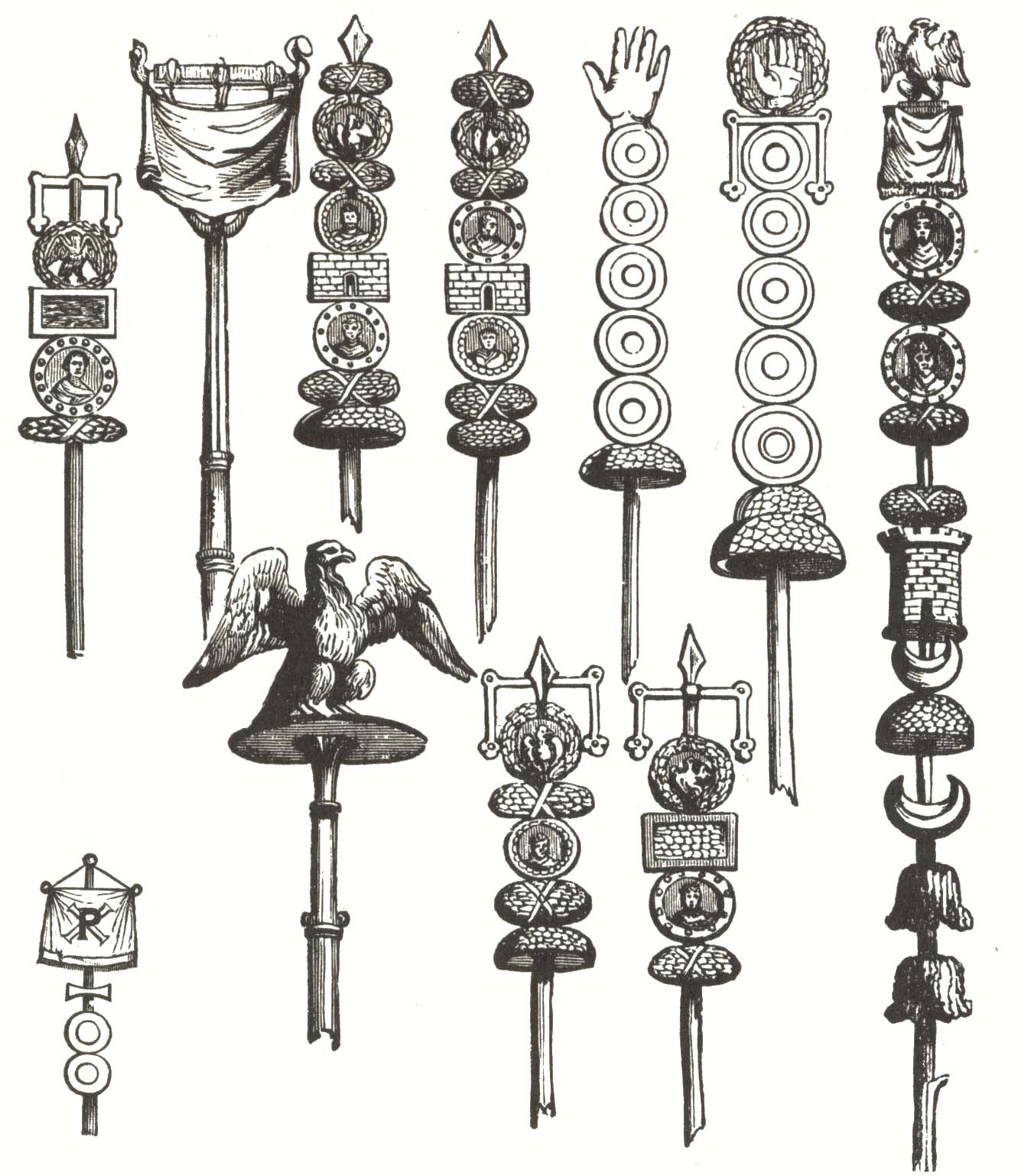
Numerous scholars raise an objection to identifying Mark’s “abomination of desolation” with either Titus’ profanation of the Holy of Holies or the sacrifice to the Roman standards on the Temple Mount, namely that by the time the Temple was profaned it would have been too late to flee the city.[42] But this objection is not as weighty as it appears. In the first place, it is simply untrue that it was too late to abandon the city by the time the Temple was destroyed. After the Temple Mount was captured the Romans still had to subdue the lower and upper cities, a feat that was not accomplished until a month after the Temple went up in flames. Josephus reports that desertions from the besieged city continued right through this period (see J.W. 6:318-322, 366-373).[43] In the second place, if, as we believe, the author of Mark revised Jesus’ prophecy after the destruction of the Temple, then it may not have mattered to the author of Mark whether or not flight from the city was possible or practical by the time the Temple had been destroyed. What concerned the author of Mark was not creating an accurate account of the destruction of Jerusalem as it actually happened. His aim was to give his community’s experience of the destruction an apocalyptic interpretation in the light of Daniel’s visions. If that goal required fudging the historical details, it was unlikely to have bothered the author of Mark, whose greatest talent was embellishing the Gospel narratives he inherited from Luke with “fresh” details.
חָרְבָּנָהּ (HR). In LXX most instances of ἐρήμωσις (erēmōsis, “desolation,” “state of lying waste”)[44] occur as the translation of words formed from the שׁ-מ-מ root.[45] However, references to the destruction of Jerusalem and the Temple in Mishnaic Hebrew sources typically use the noun חָרְבָּן (ḥorbān, “destruction”; cf., e.g., m. Git. 8:5). While חָרְבָּן is not attested in MT, it does occur in DSS (CD A V, 20; 4QpsMosese [4Q390] 1 I, 8), which proves that it was current in the late Second Temple period. Since we prefer to reconstruct direct speech, including Jesus’ prophetic utterances, in a style resembling Mishnaic Hebrew, we have adopted חָרְבָּן for HR. Below is an example of חָרְבָּן with a feminine pronominal suffix:
מלמד שכיפר לה חורבנה
It teaches that her [i.e., Jerusalem’s—DNB and JNT] destruction [חוֹרְבָּנָהּ] atoned for her. (t. Ber. 1:15; Vienna MS)

L7-8 τὸ ῥηθὲν διὰ Δανιὴλ τοῦ προφήτου (Matt. 24:15). The author of Matthew clarified for his readers Mark’s cryptic reference to “the abomination of desolation” by adding “the one spoken of by Daniel the prophet.” The redactional character of this addition is evident from its similarity to the uniquely Matthean Scripture fulfillment formulae τότε ἐπληρώθη τὸ ῥηθὲν διὰ + personal name + τοῦ προφήτου λέγοντος (“Then was fulfilled the thing spoken through + personal name + the prophet, saying…”; Matt. 2:17; 27:9) and ἵνα/ὅπως πληρωθῇ τὸ ῥηθὲν διὰ + personal name + τοῦ προφήτου λέγοντος (“So that might be fulfilled the thing spoken through + personal name + the prophet, saying…”; Matt. 4:14; 8:17; 12:17; cf. Matt. 2:23; 13:35; 21:4).[46] While it is not certain whether the author of Mark thought that the abomination of desolation mentioned in Daniel referred to the events of 70 C.E. or merely prefigured them, it is clear that the author of Matthew thought that the prophecies of both Daniel and Jesus referred to eschatological events that were yet to be fulfilled and were therefore unrelated to the events of 70 C.E.[47]
Whereas the book of Daniel refrains from identifying Daniel as a prophet, Daniel is so identified not only in Matthew but also in ancient Jewish sources (cf. 4QFlorilegium [4Q174] 1 II, 3; Jos., Ant. 10:249, 268; cf. Seder Olam §20).[48]

L9 ἑστηκότα ὅπου οὐ δεῖ (Mark 13:14). Mark’s grammar in L9 is unusual. Whereas the gender of “the abomination of desolation” is neuter, the participle ἑστηκότα (hestēkota, “standing”), which modifies it, is masculine. While it is possible that this discrepancy is simply a grammatical mistake, it is, perhaps, more likely that the discrepancy is intentional. The author of Mark may have wished to signify by this gender discrepancy that the abomination of desolation was an individual (Titus?) or the image of an individual (the emperor? a tropaeum?).[49] Indeed, it may be that when the author of Mark summoned his readers to understand (L10) he was asking them to pay attention to the grammatical anomaly and to discern its significance. If so, the author of Matthew failed to discern it, since he removed Mark’s grammatical anomaly by replacing ἑστηκότα with the neuter form ἑστός (hestos, “standing”).[50]
The author of Matthew’s replacement of Mark’s ὅπου οὐ δεῖ (hopou ou dei, “where he must not”) with ἐν τόπῳ ἁγίῳ (en topō hagiō, “in a holy place”) is more specific, but not so specific as to leave us without questions.[51] Did the author of Matthew imagine that a pagan or Jewish temple would someday be reconstructed on the Temple Mount? Or does the lack of the definite article indicate that the author of Matthew was not thinking about the site of the Second Temple? Might the holy place he was thinking of be the site of Jesus’ crucifixion and/or burial?[52] Or was he afraid that some outside influence would impose itself upon the meeting place(s) of the Matthean community?[53]
L10 ὁ ἀναγινώσκων νοείτω (Mark 13:14). With the imperative “Let the reader understand!” the author of Mark interrupted Jesus’ speech in order to directly address his readers.[54] As we noted in the previous comment, it may be that the author of Mark wished his readers to take careful note of the grammatical awkwardness of his sentence in order that they might realize that by “the abomination of desolation” he referred to a particular individual (Titus?) or a particular individual’s image (the emperor’s?).[55] The author of Mark’s interruption may be an inadvertent admission of his editorial reworking of Jesus’ prophecy in light of Daniel’s visions, or it may simply be a clumsy attempt to retain a parallel to Luke’s imperative to know (L5) that Jerusalem’s desolation has come near.
The author of Matthew took over the appeal for understanding from Mark, but his editorial insertions in L7-8 altered its effect. Unlike Mark 13:14, where “Let the reader understand!” is a direct appeal from the author of Mark to the readers of his Gospel, in Matthew it is possible to construe the appeal as coming from Jesus: “Therefore, when you see the abomination of desolation, the one spoken of by Daniel the prophet, standing in a holy place—let the reader [i.e., of Daniel] understand….”[56] Thus it appears the author of Matthew, whether subconsciously or with full awareness,[57] assimilated Mark’s intrusive authorial remark into Jesus’ speech.
L11-12 τότε οἱ ἐν τῇ Ἰουδαίᾳ φευγέτωσαν εἰς τὰ ὄρη (Luke 21:21). If, as so many scholars suppose, the antecedent of αὐτῆς (avtēs, “of her”) in L13 is Jerusalem rather than Judea,[58] then the command “Then let the ones in Judea flee to the mountains” fits awkwardly in its Lukan context, intruding between “When you see Jerusalem surrounded” and “Let those inside her [i.e., Jerusalem] depart.”[59] Some scholars have cited this intrusive command in L11-12 as proof of Luke’s partial (if not total) dependence on Mark as a source for the prophecy of destruction and redemption in Luke 21.[60] For adherents to Lindsey’s hypothesis, however, Lukan dependence on Mark is not a satisfactory explanation. But neither can we ignore the apparent intrusiveness of L11-12 in their Lukan context.
We suspect it was the First Reconstructor who interpolated the command for Judeans to flee to the mountains. In so doing the First Reconstructor may have sought to make Jesus’ prophecy more widely applicable at a time prior to the Temple’s destruction when there were congregations of believers scattered throughout Judea and beyond. Congregations in Judea would have required instructions regarding how they should behave when the Roman legions advanced through their land, as Jesus had warned they would. The injunction in L11-12 satisfies that need.
Since we regard the command for Judeans to flee to the mountains as a redactional insertion from FR, we have omitted an equivalent to these lines in GR and HR.
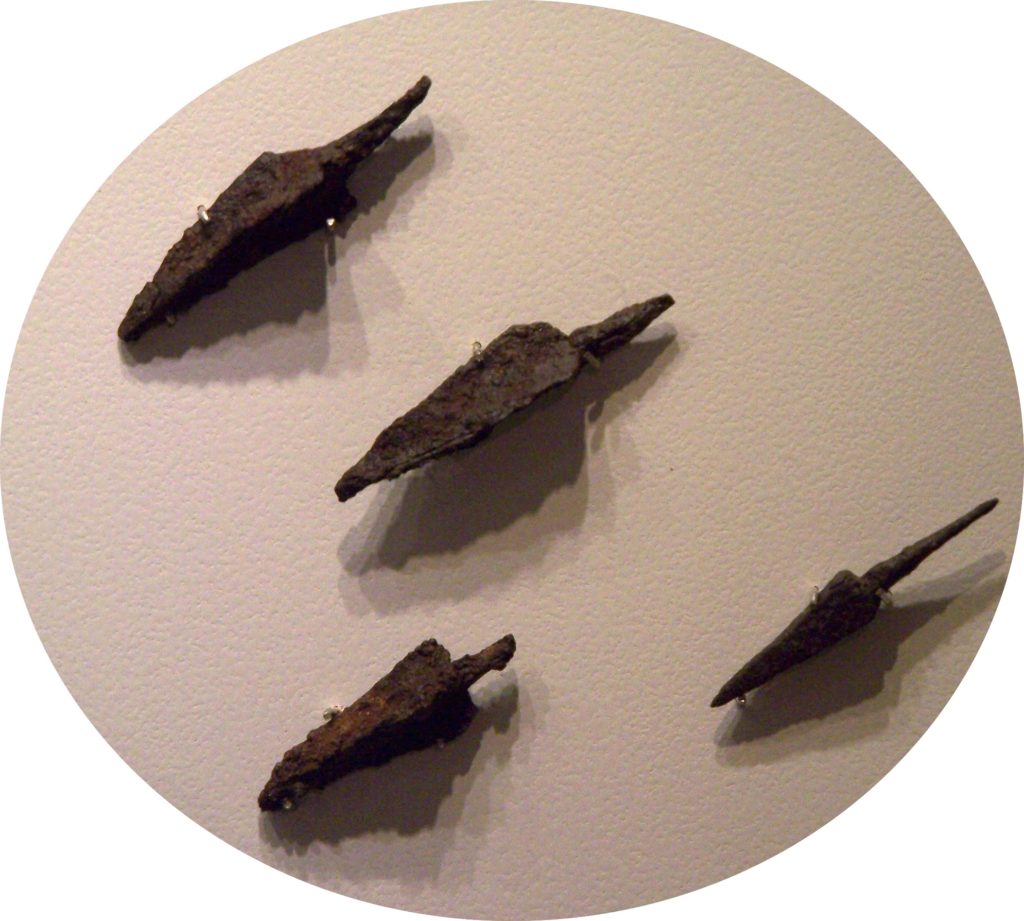
The author of Mark picked up FR’s interpolated command to the Judeans from Luke, but he dispensed with the instructions for those caught up in the siege of Jerusalem retained in Luke 21:21 (L13-16). His reason for making this omission was his desire to insert his version of Lesson of Lot’s Wife (Mark 13:15-16) immediately following the command to the Judeans to flee to the mountains, which reminded him of the story of Lot’s escape from Sodom, where an angel commands Lot, εἰς τὸ ὄρος σῴζου (eis to oros sōzou, “Get safely to the mountain!”; Gen. 19:17).[61] Since the instructions to Jerusalem’s residents would have impinged upon the connection the author of Mark saw between the command to the Judeans and Lesson of Lot’s Wife, the author of Mark had no alternative but to dispense with the instructions to those caught up in Jerusalem’s siege.
Some scholars detect in Mark’s scenario, in which seeing the abomination of desolation leads to taking flight to the hills, a pattern established in the days of the Hasmonean revolt against the Seleucid Empire, when Antiochus IV set up the abomination of desolation in the Temple (1 Macc. 1:54) and the Hasmoneans and their followers took to the hills (1 Macc. 2:28).[62] However, in 1 Maccabees there is no direct connection between the abomination of desolation’s erection in the Temple and the flight of the rebel Jews. The flight of Mattathias and his followers was a reaction not to the abomination of desolation but to the murder of the king’s messengers, an action that made Mattathias and his men wanted criminals in the eyes of the Seleucid state. Since 1 Maccabees does not establish a cause and effect relationship between the abomination of desolation and the Hasmoneans’ flight to the hills, 1 Maccabees can hardly be the source of the pattern in Mark of seeing the abomination of desolation and taking flight to the hills.
L13 καὶ οἱ ἐν μέσῳ αὐτῆς (GR). We believe the original antecedent of αὐτῆς (avtēs, “of her”) in L13 was Ἰερουσαλήμ (Ierousalēm, “Jerusalem”) in Luke 21:20. When the First Reconstructor inserted the command to the Judeans to flee to the hills, however, the antecedent became Ἰουδαία (Ioudaia, “Judea”). By making Ἰουδαία the antecedent of αὐτῆς the First Reconstructor transformed Jesus’ instructions to the people caught up in the siege of Jerusalem into a universally applicable instruction to evacuate the entire province: “Let the ones inside her [i.e., Judea] depart. And let not the ones in the [other] countries enter her [i.e., Judea].”[63] In Anth. οἱ ἐν μέσῳ αὐτῆς (hoi en mesō avtēs, “the ones inside her”) referred to the people who might find themselves within the walls of Jerusalem—whether permanent residents, pilgrims or refugees—when the siege began.[64]
וּמִי שֶׁבְּתוֹכָהּ (HR). In Lesson of Lot’s Wife, L2 and L8, we similarly reconstructed the definite article with -מִי שֶׁ (mi she-, “who that,” “whoever”).
On reconstructing ἐν μέσῳ (en mesō, “in the middle of”) with בְּתוֹךְ (betōch, “in the middle of”), see “The Harvest Is Plentiful” and “A Flock Among Wolves,” Comment to L50.
L14 ἐκχωρείτωσαν (GR). The presence of the verb ἐκχωρεῖν (ekchōrein, “to emigrate,” “to leave a country”) in Anth. may have facilitated (and partly inspired) the First Reconstructor’s transformation of the Jerusalem-centric instructions into a set of universally applicable commands addressed to those within and without Judea.
יִבְרַח (HR). The verb ἐκχωρεῖν is quite rare in LXX,[65] but there is an example in Amos where ἐκχωρεῖν occurs as the translation of בָּרַח (bāraḥ, “flee”):
וַיֹּאמֶר אֲמַצְיָה אֶל עָמוֹס חֹזֶה לֵךְ בְּרַח לְךָ אֶל אֶרֶץ יְהוּדָה
And Amaziah said to Amos, “O seer, go! Take yourself off to the land of Judah!” (Amos 7:12)
καὶ εἶπεν Αμασιας πρὸς Αμως Ὁ ὁρῶν, βάδιζε ἐκχώρησον εἰς γῆν Ιουδα
And Amaziah said to Amos, “O seer, go! Emigrate to the land of Judah!” (Amos 7:12)
L15 καὶ οἱ ἐν τῷ ἀγρῷ (GR). We suspect that the words ταῖς χώραις (tais chōrais, “the countries,” “the regions”) were introduced by the First Reconstructor as a replacement for a different phrase in Anth. Our suspicion arises from the apparent wordplay between the verb ἐκχωρεῖν (“to leave a country”) in L14 and the noun χώρα (chōra, “country,” “region”) in L15 and from the difficulty of reconstructing ἐν ταῖς χώραις (en tais chōrais, “in the countries”) in the present context.[66] If the commands in L13-16 are to be understood as addressed to two groups—those inside the walls of Jerusalem at the onset of the siege (L13-14) and those near Jerusalem at the onset of the siege but beyond the city walls (L15-16)—then perhaps where Luke 21:21 now reads οἱ ἐν ταῖς χώραις (“the ones in the countries”) Anth. read οἱ ἐν τῷ ἀγρῷ (hoi en tō agrō, “the ones in the field”). In Hebrew sources “city” and “field” are a common pair of opposites,[67] and ἀγρός (agros, “field”) is the standard Greek equivalent of שָׂדֶה (sādeh, “field”).[68] Moreover, the semantic ranges of ἀγρός (“field”) and χώρα (“country”) overlap,[69] so replacing οἱ ἐν τῷ ἀγρῷ (“those in the field”) with οἱ ἐν ταῖς χώραις (“those in the countries”) would probably not have been too great a stretch for a Greek redactor like the First Reconstructor.
Supposing that Anth. read οἱ ἐν τῷ ἀγρῷ (“the ones in the field”) in L15 also provides one more reason why the author of Mark might have felt that Lesson of Lot’s Wife was a fitting substitute for the instructions in L13-16, since Lesson of Lot’s Wife instructs “the one in the field” not to turn back (Matt. 24:18 ∥ Mark 13:16 ∥ Luke 17:31).
For all these reasons we have adopted καὶ οἱ ἐν τῷ ἀγρῷ (“and the ones in the field”) in L15 for GR.
וּמִי שֶׁבַּשָּׂדֶה (HR). On reconstructing the definite article ὁ (ho, “the [one]”) with -מִי שֶׁ (mi she-, “whoever”), see above, Comment to L13.
On reconstructing ἀγρός (agros, “field”) with שָׂדֶה (sādeh, “field”), see Hidden Treasure and Priceless Pearl, Comment to L4.[70] In the present context, “whoever is in the field” would refer to anyone who was near Jerusalem but caught outside the city walls at the time when the siege commenced.
L16 μὴ εἰσερχέσθωσαν εἰς αὐτήν (GR). As was the case with αὐτῆς (“of her”) in L13, the antecedent of αὐτήν (avtēn, “her”) in Luke 21:21 is “Judea.” Accordingly, in Luke’s version of Yerushalayim Besieged the command in L15-16 means that no one outside Judea should enter the province once the siege of Jerusalem was under way. But as we discussed above (see Comment to L13), the original antecedent of the feminine pronouns in Luke 21:21 was probably “Jerusalem.” The change of the antecedent to “Judea” likely reflects the work of the First Reconstructor.
The First Reconstructor’s changes to Yerushalayim Besieged make sense for a time when there were close contacts between the believing communities located in Judea and around the Roman world. Under such conditions it would be necessary to warn the believing communities from beyond Judea not to send aid to their sister communities in Judea or to join the war effort against the Romans. Close contact between the Judean congregations and those outside the land of Israel existed during the career of the apostle Paul and are well documented in Acts. As we have argued elsewhere, the redactional changes the First Reconstructor made to Yerushalayim Besieged and other parts of Jesus’ prophecy of destruction and redemption provide important clues for the dating of FR, which we believe was completed prior to the destruction of the Temple.[71]
In Anth. the instructions in L15-16 meant that no one in the vicinity of Jerusalem caught outside the city walls at the onset of the siege should attempt to seek refuge within Jerusalem.
אַל יִכָּנֵס לָהּ (HR). On reconstructing εἰσέρχεσθαι (eiserchesthai, “to enter”) with נִכְנַס (nichnas, “enter”), see Sending the Twelve: Conduct in Town, Comment to L100. The verb נִכְנַס normally takes the preposition -לְ (le–, “to”), which is equivalent to the preposition εἰς (eis, “into”) in the Greek text of Luke 21:21 (L16). The following excerpt from the Mishnah illustrates how entering a city was expressed in Mishnaic Hebrew:
הַנִּכְנַס לָעִיר וְאֵינוּ מַכִּיר אָדָם שָׁם
The one who enters the city but is not acquainted with anyone there…. (m. Dem. 4:6)
For the people of his time Jesus’ advice in L13-16 would have sounded counterintuitive. Usually in the face of an advancing army the people would take refuge in fortified cities, and Jerusalem was protected (or so it was believed) not only by its walls and other defenses, but by the divine presence that dwelt within it.[72] However, Jesus—like the prophet Jeremiah before him—warned that the people should not place their confidence in Jerusalem’s fortifications or take divine protection for granted. Jerusalem was doomed on account of the people’s rejection of the Kingdom of Heaven. The redemption that had been so close was now withdrawn until the times of the Gentiles will have reached their completion.
L17-25 As we discussed above in Comment to L11-12, the author of Mark injected his version of Lesson of Lot’s Wife into Abomination of Desolation (his version of Yerushalayim Besieged) as a replacement for the instructions given in Luke 21:21 (L13-16). This he did because the command for the Judeans to flee to the hills reminded the author of Mark of the story of Lot, in which he too was commanded to seek refuge in the hills, and because the advice that those in the field should not enter the city resembled the command in Lesson of Lot’s Wife that a person in the field should not look back. The author of Matthew followed Mark’s reworked version of Jesus’ prophecy.
Since we have reconstructed the contents of L17-25 elsewhere, we refer readers to the LOY segment Lesson of Lot’s Wife for a detailed discussion of this pericope.
L26-29 There is no direct parallel to Luke 21:22 (L26-29) in Mark or Matthew, although Luke’s “these are days of vengeance” (L26-27) is roughly equivalent to “those days will be trouble” in Mark 13:19 (L37-39). Since we believe it is Luke’s version of Yerushalayim Besieged that most closely resembles the version in Anth., we have included reconstructions of L26-29 in GR and HR.
L26 שֶׁיְּמֵי (HR). On reconstructing ὅτι (hoti, “that,” “because”) with the relative pronoun -שֶׁ (she-, “who,” “that”), which could also be used with the sense “because,” see Lost Sheep and Lost Coin, Comment to L31.
On reconstructing ἡμέρα (hēmera, “day”) with יוֹם (yōm, “day”), see Choosing the Twelve, Comment to L1.
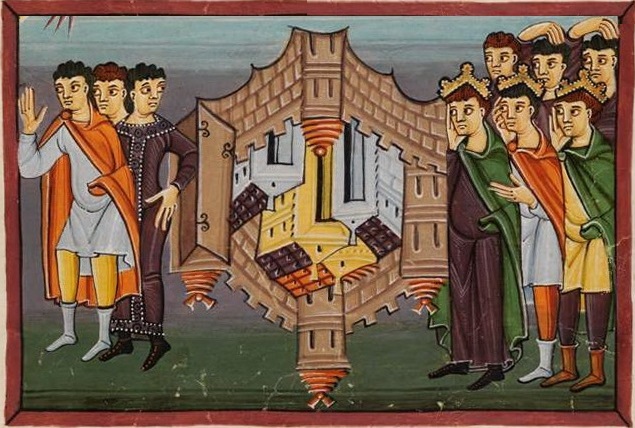
L27 נָקָם אֵלּוּ (HR). In LXX the phrase αἱ ἡμέραι τῆς ἐκδικήσεως (hai hēmerai tēs ekdikēseōs, “the days of vengeance”) occurs as the translation of יְמֵי הַפְּקֻדָּה (yemē hapequdāh, “the days of visitation”) in Hos. 9:7.[73] More often in LXX, however, the noun ἐκδίκησις (ekdikēsis, “vengeance”) occurs as the translation of נָקָם (nāqām, “vengeance”) or נְקָמָה (neqāmāh, “vengeance”).[74] The phrase ἡμέρα ἐκδικήσεως (hēmera ekdikēseōs, “day of vengeance”) occurs in Jer. 26[46]:10 as the translation of יוֹם נְקָמָה (yōm neqāmāh, “day of vengeance”) with respect to the defeat of Pharaoh Neco by Nebuchadnezzar in the battle of Carchemish. The phrase יוֹם נָקָם (yōm nāqām, “day of vengeance”) is more common, appearing in the Hebrew Scriptures (Isa. 34:8; 61:2; 63:4; Prov. 6:34) and DSS (1QS IX, 23; X, 19; 1QM VII, 5; XV, 3), often with reference to an eschatological day of judgment. Strangely enough, the LXX translators never rendered יוֹם נָקָם as ἡμέρα ἐκδικήσεως. All this leaves us with some uncertainty as to how ἡμέραι ἐκδικήσεως (“days of vengeance”) ought to be reconstructed in L26-27. We have settled on יְמֵי נָקָם (yemē nāqām, “days of vengeance”) because it is closest to the most common expression for “day of vengeance,” יוֹם נָקָם. Supposing that יְמֵי נָקָם is the correct reconstruction, we might imagine that Jesus used this phrase to hint that the destruction of Jerusalem and the Temple was not identical to the Day of Vengeance. A long time would pass between the vengeance meted out to Jerusalem and the final day of reckoning.
L28 כְּדֵי לְקַיֵּים (HR). In LXX the verb πιμπλάναι (pimplanai, “to fill”) usually occurs as the translation of the root מ-ל-א in its various stems.[75] The correspondence between πιμπλάναι in LXX and מ-ל-א explains why Delitzsch, in his Hebrew translation of the New Testament, rendered τοῦ πλησθῆναι πάντα τὰ γεγραμμένα (“to be fulfilled all the things written”) in Luke 21:22 as לְמַלֹּאת כָּל הַכָּתוּב (“to fulfill all the Scripture”).[76] Delitzsch’s translation, however, is unidiomatic. In rabbinic sources we never encounter verbs from the root מ-ל-א used in reference to the fulfillment of Scripture. Rabbinic sources use the verbs קִיֵּים (qiyēm, “carry out [a task],” “fulfill”) and נִתְקַיֵּים (nitqayēm, “be realized,” “be fulfilled”) for the fulfillment of Scripture.[77] Although Luke’s text has a passive infinitive, we have not adopted לְהִתְקַיֵּים (lehitqayēm, “to be fulfilled”) for HR. “In order that the Scriptures might be fulfilled” would have to be expressed as כְּדֵי שֶׁיִּתְקַיֵּימוּ כָּל הַכְּתוּבִים; reconstructing τοῦ πλησθῆναι πάντα τὰ γεγραμμένα as כְּדֵי לְהִתְקַיֵּם כָּל הַכְּתוּבִים strikes us as just as unidiomatic as Delitzsch’s translation. Supposing that Luke’s infinitive reflects an infinitive construct in the underlying Hebrew text, כְּדֵי לְקַיֵּים אֶת כָּל הַכְּתוּבִים (kedē leqayēm ’et kol haketūvim, “in order to fulfill all the Scriptures”) appears to be the best option for HR. In support of our reconstruction is the fact that passive forms of πιμπλάναι in LXX often occur as the translation of verbs in active stems.[78] For example:
וּכְבוֹד יי מָלֵא אֶת הַמִּשְׁכָּן
…and the glory of the Lord filled the tabernacle. (Exod. 40:34)
καὶ δόξης κυρίου ἐπλήσθη ἡ σκηνή
…and the tabernacle was filled with the glory of the Lord. (Exod. 40:34)
וּמֵעֶיךָ תְמַלֵּא אֵת הַמְּגִלָּה הַזֹּאת…and fill your stomach with this scroll…. (Ezek. 3:3)
καὶ ἡ κοιλία σου πλησθήσεται τῆς κεφαλίδος ταύτης
…and your stomach will be filled with this scroll…. (Ezek. 3:3)
וּמָלְאוּ אֶת הָאָרֶץ חָלָל
…and they will fill the land with the slain. (Ezek. 30:11)
καὶ πλησθήσεται ἡ γῆ τραυματιῶν
…and the land will be filled with the wounded. (Ezek. 30:11)
L29 אֶת כָּל הַכְּתוּבִים (HR). On reconstructing πᾶς (pas, “all,” “every”) with כָּל (kol, “all,” “every”), see Demands of Discipleship, Comment to L32.
The use of τὸ γεγραμμένον (to gegrammenon, “the [thing] written”) with reference to Scripture is unique to Luke among the Synoptic Gospels (Luke 18:31; 20:17; 21:22; 22:37; 24:44). Significantly, however, this use of τὸ γεγραμμένον is absent in Acts,[79] which suggests that in Luke’s Gospel this usage of τὸ γεγραμμένον is a reflection of Luke’s sources rather than of Lukan redaction.[80] As Buth and Kvasnica have noted, Luke’s use of τὸ γεγραμμένον—a substantival passive participle—is an exact grammatical parallel to the Hebrew passive participle הַכָּתוּב (hakātūv, “the [thing] written”).[81] In rabbinic sources הַכָּתוּב usually occurs with a meaning roughly parallel to “the Scripture verse” or “the Scripture passage.” Thus we frequently encounter the phrase הַכָּתוּב שֶׁבַּתּוֹרָה (hakātūv shebatōrāh, “the thing written that is in the Torah,” i.e., “the Torah verse”),[82] and we find statements such as the following:
ר′ יִשְׁמָעֵאל אוֹמֵ′ כָּתוּב אֶחָד אוֹ′ הַקְדֵּשׁ וְכָתוּב אַחֵד אוֹמֵ′ אַל תַּקְדֵּשׁ
Rabbi Yishmael says, “One written thing [i.e., verse—DNB and JNT] says, Sanctify! [Deut. 15:19], and another written thing [i.e., verse—DNB and JNT] says, You must not sanctify! [Lev. 27:26]….” (m. Arach. 8:7)
Accordingly, if τὰ γεγραμμένα (ta gegrammena, “the things written”) in Luke 21:22 reflects הַכְּתוּבִים (haketūvim, “the things written”) in the underlying Hebrew text, the meaning of הַכְּתוּבִים in Yerushalayim Besieged is probably closer to “the Scripture passages” or “the Scripture verses” than “the Scriptures.” We find a parallel usage of הַכְּתוּבִים in this sense in the following example:
ויהי בנסוע הארון ויאמר משה, מלמד שהיו נוסעין על פי משה: כת′ ויהי בנסוע הארון ויאמר משה ובנחה יאמר שובה י″י וכת′ על פי י″י יחנו ועל פי י″י יסעו (במד′ ט כג) וכי היאך אפשר לקיים כל הכתובים הללו הא כיצד—בזמן שהיו נוסעין היה עמוד הענן נעקר ממקומו על פי המקום ולא היה לו רשות להלוך עד שיאמר לו משה נמצאת מקיים על פי י″י ועל פי משה
And when the ark would set out Moses would say [Num. 10:35]. This teaches that they would set out at Moses’ command. It is written, And when the ark would set out Moses would say…and when it rested he would say, “Return, O Lord…” [Num. 10:35-36], but it is also written, At the Lord’s command they would camp, and at the Lord’s command they would set out [Num. 9:23]. So how is it possible to establish all these verses [לְקַיֵּים כָּל הַכְּתוּבִים הַלָּלוּ]? How? When they were setting out the pillar of cloud would be uprooted from its place at the command of the Omnipresent One, but it would not have authority to go until Moses would speak to it. The result is “at the Lord’s command” and “at Moses’ command” is established. (Sifre Num. Zuta, BeHa‘alotecha 10:35 [ed. Horovitz, 266-267])
As we discussed above in Comment to L3, one of the Scripture passages concerning the destruction of Jerusalem that Jesus almost certainly had in mind was Zech. 14:2.
Like Jesus, Josephus claimed to know of scriptural passages that prophesied the destruction of Jerusalem without citing specific verses (cf. J.W. 6:109).
L30 οὐαὶ (GR). The absence of the conjunction δέ (de, “but”) in Luke’s version of Yerushalayim Besieged looks authentic. The author of Mark probably added the δέ when he transitioned from Lesson of Lot’s Wife back to his sources for Yerushalayim Besieged (viz., Luke and Anth.). The author of Matthew copied the δέ in L30 from Mark.
אִי (HR). On reconstructing οὐαί (ouai, “Woe!”) with אִי (’i, “Woe!”), see Woes on Three Villages, Comment to L5.
L31-33 Since in L31-33 there is complete verbal agreement among all three Synoptic Gospels, and since the Greek in these lines reverts easily to Hebrew (see below), it is likely that the Synoptic Gospels have reproduced Anth.’s wording exactly. Therefore, no further discussion of GR in L31-33 is required.
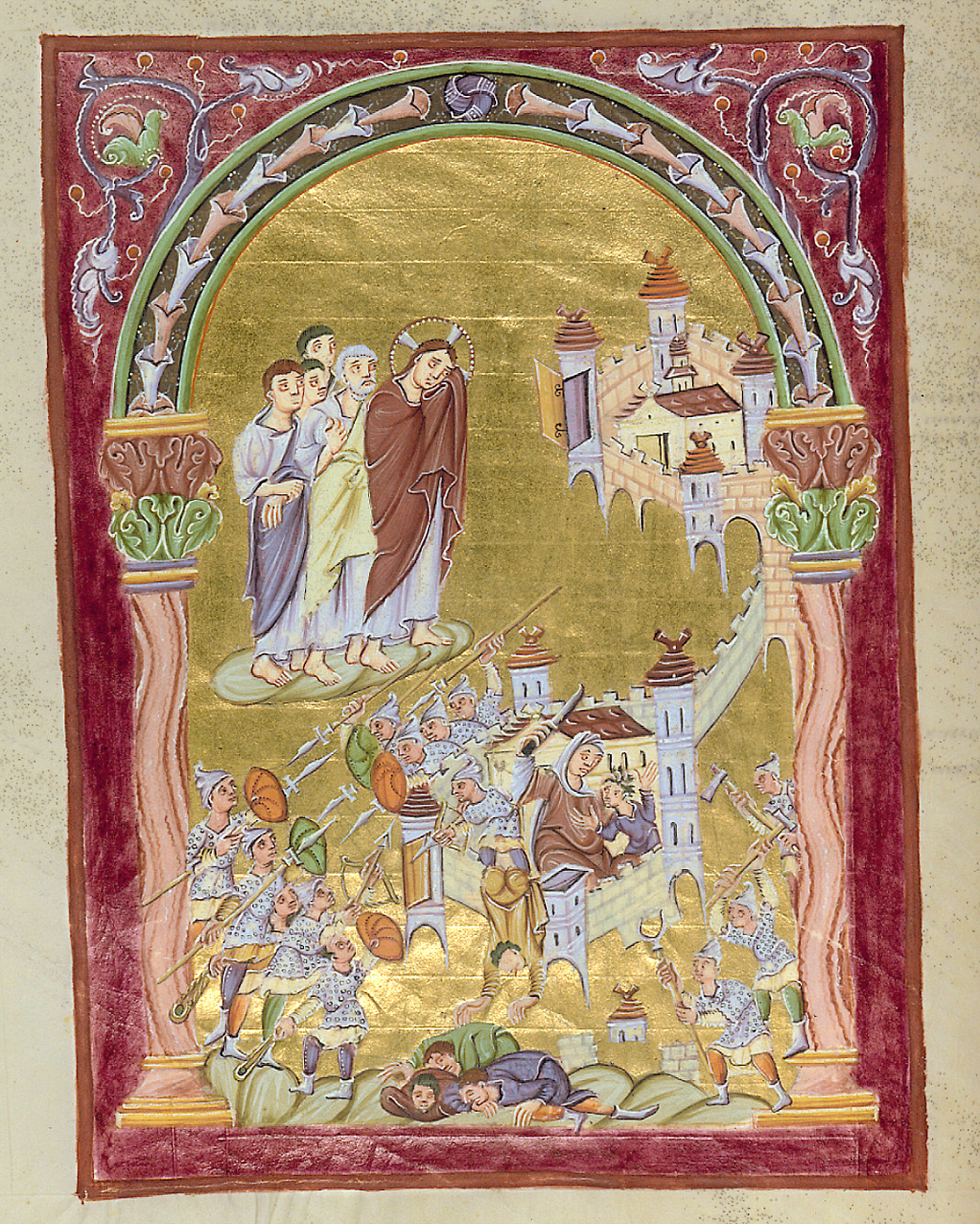
L31 לָעוּבָּרוֹת (HR). In LXX the phrase ἐν γαστρὶ ἔχειν (en gastri echein, “to have in the belly”)[83] typically occurs as the translation of the verb הָרָה (hārāh, “conceive”) or the adjective הָרָה (hārāh, “pregnant”), which was often used substantivally as “pregnant woman.”[84] Had we wished to reconstruct Jesus’ words in a biblicizing style of Hebrew, the substantival plural adjective הָרוֹת (hārōt, “pregnant women”) would have been the right choice.[85] However, in Mishnaic Hebrew “pregnant woman” was expressed either as מְעוּבֶּרֶת (me‘ūberet), a passive participle used substantivally, or עוּבָּרָה (‘ūbārāh, “pregnant woman”; var. עוֹבָרָה [‘ōvārāh]), a noun.
Examples of מְעוּבֶּרֶת include:
ר′ אֱלִיעֶזֶר אוֹמֵ′ אַרְבַּע נָשִׁים דַּיָּין שַׁעְתָן בְּתוּלָה וּמְעוּבֶּרֶת וּמֵנִיקָה וּזְקֵינָה
Rabbi Eliezer says, “There are four [classes of] women whose time [of experiencing a discharge] is sufficient for them [to be deemed impure]: a virgin, and a pregnant woman [וּמְעוּבֶּרֶת], and a nursing mother, and a postmenopausal woman.” (m. Nid. 1:3)
השוכר את החמור…להרכיב אשה מרכיב אשה עליה בין מעוברת ובין מניקה
The one who hires a donkey…to give a woman a ride, he gives the woman a ride on it whether she is a pregnant woman [מְעוּבֶּרֶת] or whether she is a nursing mother. (t. Bab. Metz. 7:10; Vienna MS)
שלש נשים משמשות במוך קטנה מעוברת ומניקה
Three [classes of] women have sexual relations with a contraceptive: a minor, a pregnant woman [מְעוּבֶּרֶת] and a nursing mother. (t. Nid. 2:6; Vienna MS)
Examples of עוּבָּרָה (var. עוֹבָרָה) include:
עֹבָרָה שֶׁהֵארִיחָה מַ
נאֲכִילִין אוֹתָם עַד שַׁתָּשׁוּב נַפְשָׁהּA pregnant woman [עֹבָרָה] who smells [food on the Day of Atonement and is overcome by it—DNB and JNT]: they feed them until her soul is refreshed. (m. Yom. 8:5)
העוברות והמניקות מתענות בתשעה באב וביום הכפורים ובשלש תעניות השניות של צבור ושאר תעניות לא היו מתענות
Pregnant women [הָעוּבָּרוֹת] and nursing mothers fast during the ninth of Av and on the Day of Atonement and during the three fasts of the second round of public fasting, but the rest of the fasts they would not fast. (t. Taan. 2:14)
Since we prefer to reconstruct Jesus’ words in a Mishnaic style of Hebrew, either מְעוּבֶּרֶת or עוּבָּרָה would be acceptable for HR. We have chosen the latter partly under the influence of the following woe pronounced in the time of Rabbi Yehudah ha-Nasi (ca. 200 C.E.):
אִי לָכֶם חַיּוֹת שֶׁבְּאֶרֶץ יִשְׂרָאֵל אִי לָכֶם עֻבָּרוֹת שֶׁבְּאֶרֶץ יִשְׂרָאֵל
Woe to you women in childbirth who are in the land of Israel. Woe to you pregnant women [עֻבָּרוֹת] who are in the land of Israel! (Gen. Rab. 96:5 [ed. Merkin, 4:176]; cf. Theodor-Albeck, 3:1199)
L32 וְלַמֵּנִיקוֹת (HR). The examples cited in the previous comment provide ample evidence for the use of מֵנִיקָה (mēniqāh, “nursing mother”) in rabbinic sources and for its pairing with both מְעוּבֶּרֶת and עוּבָּרָה.[86]
In LXX the participle θηλαζούσα (thēlazousa, “lactating”) occurs once as the translation of מֵנִיקָה (“lactating”):
וַיָּלֶן שָׁם בַּלַּיְלָה הַהוּא וַיִּקַּח מִן הַבָּא בְיָדוֹ מִנְחָה לְעֵשָׂו אָחִיו׃ עִזִּים מָאתַיִם וּתְיָשִׁים עֶשְׂרִים רְחֵלִים מָאתַיִם וְאֵילִים עֶשְׂרִים׃ גְּמַלִּים מֵינִיקוֹת וּבְנֵיהֶם שְׁלֹשִׁים
And he spent the night there that night. And he took from what he brought with him a gift for his brother Esau: two hundred nanny goats and twenty billy goats, two hundred ewes and twenty rams, thirty lactating camels [LXX: καμήλους θηλαζούσας] and their young…. (Gen. 32:14-16)
In addition, there are multiple examples of θηλάζειν (thēlazein, “to give suck,” “to suckle”) that occur as the translation of הֵנִיקָה (hēniqāh, “give suck,” “breastfeed”).[87]
L33 בְּאוֹתָם הַיָּמִים (HR). On reconstructing ἐκεῖνος (ekeinos, “that”) with אֵת + third-person pronominal suffix, see Calamities in Yerushalayim, Comment to L14.
On reconstructing ἡμέρα (hēmera, “day”) with יוֹם (yōm, “day”), see Comment to L26 above.
Josephus gave an account of the miseries women and children endured when attempting to flee a besieged town:[88]
At nightfall John [of Gishala], seeing no Roman guard about the town, seized his opportunity and, accompanied not only by his armed followers but by a multitude of non-combatants with their families, fled for Jerusalem. For the first twenty furlongs he succeeded in dragging with him this mob of women and children,…but after that point as he pushed on they were left behind, and dreadful were their lamentations when thus deserted…. Many strayed off the track, and on the highway many were crushed in the struggle to keep ahead. Piteous was the fate of the women and children, some making bold to call back their husbands or relatives and imploring them with shrieks to wait for them. But John’s orders prevailed: “Save yourselves,” he cried, “and flee where you can have your revenge on the Romans for any left behind, if they are caught.” So this crowd of fugitives struggled away, each putting out the best strength and speed he had. (J.W. 4:106-111; Loeb)
While we must be wary of Josephus’ tendentious villainization of John of Gishala and his flair for the dramatic, the inability of women and children to keep up with the men when fleeing from the enemy was probably no exaggeration.
Jesus’ compassionate lamentation for the fate of the pregnant women and nursing mothers caught up in the misfortunes of Jerusalem illustrates his enduring solidarity with the Jewish people despite his gloomy predictions of divine judgment and national catastrophe.
L34-36 The command to pray that the disaster coming upon Jerusalem not take place in the winter (Mark-Matt.) or on the Sabbath (Matt.) is absent in Luke’s version of Yerushalayim Besieged. There are scholars who view this command as having originated prior to the events of 70 C.E., arguing that 1) after the events had already taken place there was no longer any point in praying about when those events might unfold,[89] and that 2) if original, the concern about the Sabbath reflects a Jewish or Jewish-Christian viewpoint more likely to have been held prior to the Temple’s destruction.[90] Some scholars believe that the prophecy concerning the abomination of desolation preserved in Mark 13:14-20 was originally composed in response to the crisis in 40 C.E. when the emperor Gaius Caligula issued an order to have his statue erected in Jerusalem’s Temple. Fears that the emperor’s edict would be carried out in the winter of 40-41 C.E. were only quelled by the emperor’s assassination on 24 January 41 C.E. According to this view, the command to pray that the abomination of desolation not appear in the winter reflects the original prophecy’s composition sometime prior to Caligula’s assassination.[91] The incorporation of this command in Mark’s Gospel along with the rest of the abomination of desolation prophecy is then cited as evidence for a pre-70 C.E. date for the composition of Mark, since the author of Mark would surely have eliminated the command to pray that the crisis not happen in winter if he had known that the actual siege of Jerusalem and the destruction took place in the spring and summer of 70 C.E.
We, of course, look at the command in Mark 13:18 ∥ Matt. 24:20 differently. Far from betraying ignorance of the events of 70 C.E., we believe the author of Mark added the command to pray that the crisis might not happen in winter precisely because he knew the entire course of the siege took place in the spring and summer of 70 C.E.[92] By adding this command the author of Mark was able to bolster Jesus’ image as an accurate prognosticator of future events and to enhance Jesus’ status as a Lord who is able to grant the prayers of the elect (cf. Mark 13:20). In other words, the author of Mark wished to convince his readers that because Jesus possessed miraculous foreknowledge, Jesus was able to instruct his followers to pray that the disaster not strike in winter, and that because God has delegated to Jesus the authority to grant his followers’ requests, the disaster ended up taking place not in winter but in the spring and summer. By enhancing Jesus’ credentials as a prognosticator and by highlighting Jesus’ ability to grant prayers, the author of Mark sought to instill in his readers greater confidence that the parts of Jesus’ prophecy that had yet to be fulfilled would happen just as Jesus predicted, and that through it all Jesus could be relied upon to preserve them from danger.[93]
Matthew’s reference to the Sabbath we regard not as an original part of Jesus’ command the author of Mark had omitted,[94] but as a further embellishment, which the author of Matthew added to the command he copied from Mark. We will discuss further reasons for regarding the content of L34-36 as secondary in the Comments below.
L34-35 προσεύχεσθε δὲ ἵνα μὴ γένηται (Mark 13:18). There is no particular difficulty in reconstructing Mark’s imperative προσεύχεσθε (prosevchesthe, “Pray!”) as הִתְפַּלְּלוּ (hitpalelū, “Pray!”).[95] Clauses including ἵνα + subjunctive, on the other hand, are often the product of Markan redaction.[96] As we have discussed above, we regard the command to pray as a Markan addition.
ἵνα μὴ γένηται ἡ φυγὴ ὑμῶν (Matt. 24:20). By appending the words ἡ φυγὴ ὑμῶν (hē fūgē hūmōn, “your flight”) to the end of L35, the author of Matthew supplied the command to pray with greater specificity, but in so doing the author of Matthew also changed the meaning of the command in a way that creates logical inconsistencies in Matthew’s version of the pericope.
In Mark the unstated antecedent of “it” in the phrase “pray that it may not happen in winter” is either the appearance of the abomination of desolation or the totality of the crisis caused by its appearance.[97] This was an event over which the people addressed by the command to pray had no control. It therefore makes sense that the addressees should pray to God about the timing of these events, since God is ultimately in control of everything. Likewise, the relatively long period of time indicated in Mark, “the winter,” makes sense. The people’s hardships would be increased if the abomination of desolation appeared at any time during the winter. Winter would make flight more difficult because of the cold and muddy roads, and provisions would be scarce.
The addition of “your flight” in Matthew changes the equation, because unlike the appearance of the abomination of desolation, the addressees are able to control the timing of their flight. If the abomination of desolation made its appearance on the Sabbath, the addressees could make their escape as soon as the Sabbath had ended. True, Matthew’s version of Jesus’ prophecy emphasizes the need for urgent flight, but the decision to flee remains firmly in the power of the addressees. Therefore, there is strictly no need to pray that the flight may not happen on the Sabbath: they do not need to pray that God will control their decision making.[98] Nevertheless, the Sabbath reference in L36 appears to be inseparable from the addition of “your flight” in L35, for without the addition of “your flight” in L35 the Sabbath reference is meaningless. The abomination of desolation could hardly have been more abominable or more desolating if it appeared on the Sabbath as opposed to any other day, therefore it is unlikely that “on the Sabbath” was omitted by the author of Mark. Rather, it appears the author of Matthew added “on the Sabbath” because he (mistakenly) believed that for Jews flight on the Sabbath would be difficult or even impossible.
L36 χειμῶνος μηδὲ σαββάτῳ (Matt. 24:20). The author of Matthew’s additions of “your flight” in L35 and “or on the Sabbath” in L36 should probably change the way we understand the noun χειμών (cheimōn). In Mark 13:18 χειμών probably means “winter,”[99] but the same noun can also mean “storm.”[100] Since storms are of relatively short duration, this sense of χειμών makes a better pair with “the Sabbath” than “winter,” so “storm” may be the meaning the author of Matthew intended.[101]
We have already stated our opinion that “or on the Sabbath” is a Matthean addition. But why would the author of Matthew want to make this change? Some scholars propose that “or on the Sabbath” was added for the sake of Jewish believers in Matthew’s audience who would have been reluctant to violate the Sabbath for any reason.[102] This explanation is unsatisfactory, however, since Matthew’s Gospel clearly presents Jesus as willing to suspend the usual restrictions of the Sabbath in case of emergencies involving danger to human life. If, as we must presume, the Jewish members of the Matthean community accepted Jesus’ teachings as presented in Matthew’s Gospel, why should they have experienced difficulty applying Jesus’ teachings to their personal safety? It is especially difficult to suppose that, with Jesus as their teacher, the Jewish Christians in Matthew’s audience had come to adopt a more stringent attitude toward the Sabbath than the wider Jewish community.[103] We know from multiple sources that mainstream Jews of the first century were of the opinion that it was permissible to take up arms in self-defense on the Sabbath. This ruling was determined during the Jewish revolt against Antiochus IV (1 Macc. 2:39-41), it became the official line of the ruling Hasmoneans, Josephus portrayed it as the normative opinion during the first century (Ant. 14:63),[104] and this opinion is reiterated in rabbinic sources.[105] Indeed, we do not find a dissenting opinion in any ancient Jewish source after the Hasmoneans made their decision.[106] If by the first century a general consensus had been reached that fighting in self-defense was permissible on the Sabbath, then clearly that consensus also permitted avoiding a fight by fleeing from danger on the Sabbath.[107]
Rather than reflecting Jewish concerns, as so many scholars suppose,[108] we believe the author of Matthew’s addition of “or on the Sabbath” reflects general Gentile ignorance of Jewish customs and particular Matthean disdain for the Jewish people.[109] Whereas in Mark “Pray that it might not happen in winter” served to highlight Jesus’ ability as a prognosticator, in Matthew “Woe to the pregnant women and nursing mothers! Pray that your flight may not be in a storm or on the Sabbath!” became a callous taunt. Such a transformation is in keeping with the attitudes of the author of Matthew, who made the entire Jewish people culpable for Jesus’ death by their self-imprecation “His blood be upon us and upon our children!” (Matt. 27:25). Evidently the author of Matthew was under the same misapprehension about the Jewish people as were other Gentile authors who mocked the Jews for allowing Jerusalem to fall into enemy hands because of their “superstitious addiction” to the Sabbath. Thus Agatharchides of Cnidus blamed Jerusalem’s subjection to the Ptolemaic Empire in the days of Ptolemy I Soter on Sabbath observance.[110] Cassius Dio blamed Jewish Sabbath observance for Pompey’s conquest of Jerusalem in 63 B.C.E.[111] And likewise, Frontinus blamed Sabbath observance for the destruction of Jerusalem in 70 C.E.[112] Plutarch, too, ascribed the fall of Jerusalem into enemy hands to Jewish Sabbath observance, but he did not specify to which capture of the city he referred.[113] The author of Matthew’s addition of “Pray that your flight may not be…on the Sabbath” does not blame Jewish Sabbath observance for the fall of Jerusalem, but it does disparage the Jewish people for being so foolish as to allow the Sabbath to prevent them from saving themselves.
L37 ἔσται γὰρ (GR). The Lukan-Matthean agreement to write “for he/she/it will be,” as opposed to Mark’s “for they will be,” virtually assures that ἔσται γάρ (estai gar, “for he/she/it will be”) was the reading of Anth. The author of Mark changed the third person singular verb to a third person plural because he wished to change the subject from ἀνάγκη (anankē, “duress”; L39) to αἱ ἡμέραι ἐκεῖναι (hai hēmerai ekeinai, “those days”; L38) for reasons we will discuss below.
L38 αἱ ἡμέραι ἐκεῖναι (Mark 13:19). The author of Mark, in keeping with his Danielic revision of Jesus’ prophecy, decided to replace the description of the slaughter and mass deportation of Jerusalem’s population and the trampling of the holy city by Gentiles he read in Luke (L39-46) with an allusion to Dan. 12:1,[114] which states:
ἐκείνη ἡ ἡμέρα θλίψεως, οἵα οὐκ ἐγενήθη ἀφ᾿ οὗ ἐγενήθησαν ἕως τῆς ἡμέρας ἐκείνης
That is a day of trouble, such as has not happened from when they came to be until that day. (Dan. 12:1)
Instead of writing ἐκείνη ἡ ἡμέρα θλίψεως (ekeinē hē hēmera thlipseōs, “that [is] the day of trouble”), however, the author of Mark wrote ἔσονται γὰρ αἱ ἡμέραι ἐκεῖναι θλεῖψις (esontai gar hai hēmerai ekeinai thleipsis, “for those days will be trouble”) because he had already referred to “those days” (plural) in Mark 13:17 (L33).
τότε (Matt. 24:21). The author of Matthew was either unaware of the allusion to Dan. 12:1 in L37-54 or did not care to emphasize it. He therefore replaced αἱ ἡμέραι ἐκεῖναι (“those days”) with his characteristic τότε (tote, “then”).[115] Matthew’s τότε in L38 coordinates with the earlier τότε in L11 (Matt. 24:16). Thus, according to Matthew, the unprecedented trouble that comes upon the Jewish people in L37-54 is concurrent with the futile attempts to escape described in L11-36.
L39 θλῖψις μεγάλη ἐπὶ τῆς γῆς (GR). While it is impossible to be sure, we think it is likely that the presence of the noun θλῖψις (thlipsis, “trouble”) in Anth. at L39 was the inspiration behind the author of Mark’s decision to replace the description of Jerusalem’s defeat with the allusion to Dan. 12:1.[116] The presence of ἀνάγκη (anankē, “duress”) in Luke 21:23 we attribute to the redactional activity of the First Reconstructor. As Wolter noted, ἀνάγκη μεγάλη (anankē megalē, “great necessity”) was a familiar Greek phrase,[117] so the First Reconstructor may have regarded it as an improvement over θλῖψις μεγάλη.[118]
Supposing that Anth. read ἔσται γὰρ θλῖψις μεγάλη (“For there will be great trouble”) also helps us understand why the author of Matthew wrote ἔσται γὰρ τότε θλῖψις μεγάλη (“For then there will be great trouble”) in place of Mark’s more awkward ἔσονται γὰρ αἱ ἡμέραι ἐκεῖναι θλῖψις (“For those days will be trouble”).[119]
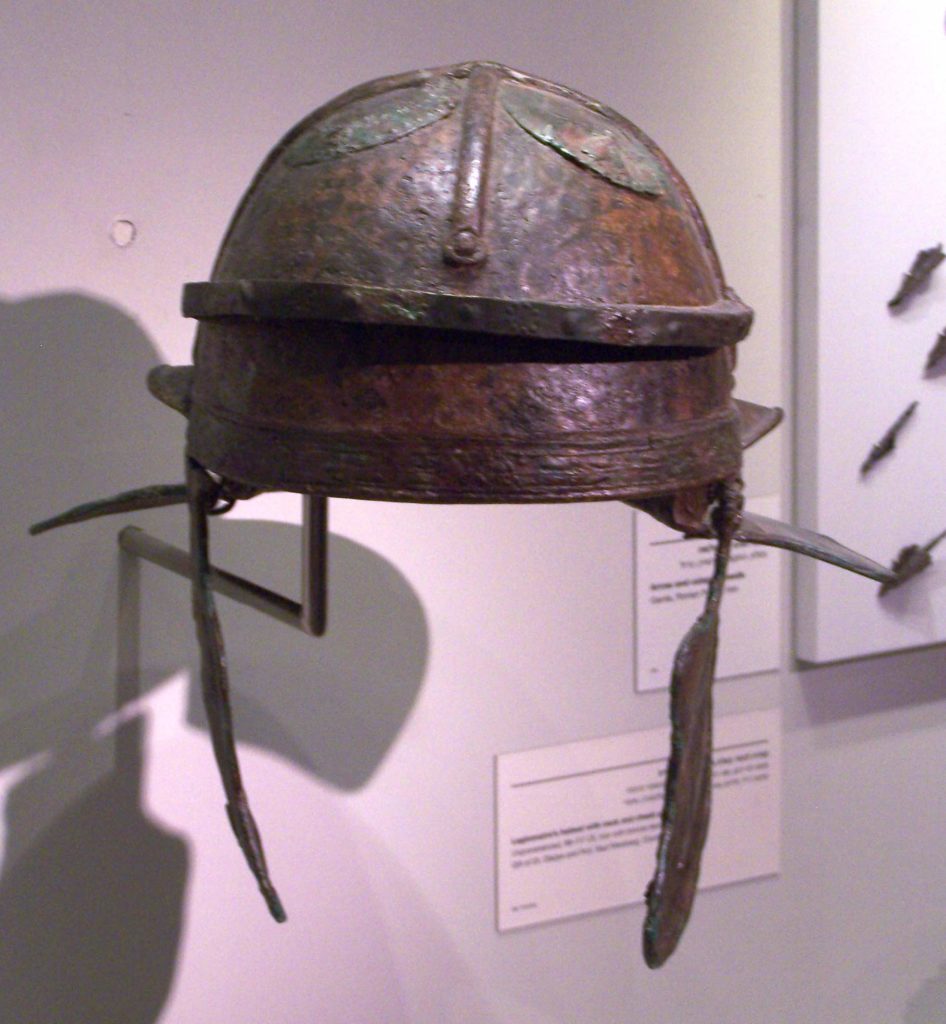
צָרָה גְדוֹלָה עַל הָאָרֶץ (HR). Whether we had adopted ἀνάγκη or θλῖψις for GR, our choice of צָרָה (tzārāh, “distress”) for HR would have remained the same. In LXX the noun ἀνάγκη (anankē, “duress”) usually occurs as the translation of either מְצוּקָה (metzūqāh, “distress”) or צָרָה,[120] but since only צָרָה survived into MH, we would have chosen צָרָה to reconstruct ἀνάγκη. The noun θλῖψις is rather more common than ἀνάγκη in LXX. There θλῖψις usually occurs as the translation of צָרָה.[121] We also find that the LXX translators rendered most instances of צָרָה with θλῖψις.[122]
The phrase θλῖψις μεγάλη (thlipsis megalē, “great trouble”) occurs once in LXX in a book with a counterpart in MT. There it occurs as the translation of the phrase צָרָה גְדוֹלָה:
וְעַל גְּוִיֹּתֵינוּ מֹשְׁלִים וּבִבְהֶמְתֵּנוּ כִּרְצוֹנָם וּבְצָרָה גְדוֹלָה אֲנָחְנוּ
…and over our bodies they rule, and with our animals [they do] as they wish, and we are in great distress [וּבְצָרָה גְדוֹלָה]! (Neh. 9:37)
καὶ ἐπὶ τὰ σώματα ἡμῶν ἐξουσιάζουσιν καὶ ἐν κτήνεσιν ἡμῶν ὡς ἀρεστὸν αὐτοῖς, καὶ ἐν θλίψει μεγάλῃ ἐσμέν
…and over our bodies they have authority, and with our animals [they do] as seems best to them, and we are in great trouble [ἐν θλίψει μεγάλῃ]! (2 Esd. 19:37)
We also encounter the phrase θλῖψις μεγάλη in 1 Macc. 9:27, where it presumably occurs as the translation of a Hebrew phrase, possibly צָרָה גְדוֹלָה (“great distress”).
Examples of the phrase צָרָה גְדוֹלָה also occur in rabbinic sources, for instance:
רבי זעירא בשם רבי ירמיה יחיד בתענית ציבור צריך להזכיר מעין המאורע איכן הוא אומרה בין גואל ישראל לרופא חולים ומה אומר ענינו ה′ ענינו בעת ובעונה הזאת כי בצרה גדולה אנחנו אל תסתיר פניך ממנו ואל תתעלם מתחינתינו כי אתה ה′ עונה בעת צרה
Rabbi Zeira said in the name of Rabbi Yirmiyah, “An individual during a public fast must mention the cause of disturbance [when he prays the Amidah].” Where does he say it? Between the blessing of the redeemer of Israel and the healer of the sick. And what does he say? “Answer us, O Lord, answer us! In this time and in this moment! For we are in great distress [בְּצָרָה גְדוֹלָה]! Do not turn your face away from us and do not ignore our supplications! For you, O Lord, answer in a time of distress.” (y. Ber. 4:3 [33b]; cf. y. Taan. 2:2 [9b])
עשיתם צרה גדולה לאותו שכת′ בו כונס כנד מי הים
You have caused great distress [צָרָה גְדוֹלָה] to him of whom it is written, he gathers the waters of the sea as a heap [Ps. 33:7]. (Lev. Rab. 17:7 [ed. Margulies, 1:388])
On reconstructing μέγας (megas, “big”) with גָּדוֹל (gādōl, “big”), see Widow’s Son in Nain, Comment to L22.
On reconstructing ἐπί (epi, “on,” “upon”) with עַל (‘al, “upon”), see Widow’s Son in Nain, Comment to L11.
On reconstructing γῆ (gē, “land,” “earth”) with אֶרֶץ (’eretz, “land,” “earth”), see Sending the Twelve: Conduct in Town, Comment to L118. As scholars have noted, “great distress upon the land” refers to the land of Israel, not to the entire earth.[123]
L40 καὶ ὀργὴ τῷ λαῷ τούτῳ (GR). Since Luke’s Greek in L40 reverts easily to Hebrew and forms a nice Hebraic parallelism with the wording in L39, there is no obstacle to prevent us from accepting Luke’s wording in L40 for GR.
וְכַעַס לָעָם הַזֶּה (HR). The noun ὀργή (orgē, “wrath”) occurs in LXX as the translation of many different phrases and terms,[124] but all are not equally suitable for HR. Two considerations place limits on our selection. First, some of the terms behind ὀργή in LXX had fallen into disuse in Mishnaic Hebrew. Second, the use of the dative in the phrase ὀργὴ τῷ λαῷ τούτῳ (orgē tō laō toutō, “wrath to this people”) suggests that we should look for a noun that can be accompanied by the preposition -לְ (le-, “to”). This second clue is especially significant, since most Hebrew nouns for “anger” are typically accompanied by the preposition עַל (‘al, “upon”).[125] There is one Hebrew noun that answers to these limitations, כַּעַס (ka‘as, “anger,” “grief”), as the following examples illustrate:
כַּעַס לְאָבִיו בֵּן כְּסִיל
A grief to his father is a foolish son…. (Prov. 17:25)
ὀργὴ πατρὶ υἱὸς ἄφρων
A [cause for] wrath to his father is a foolish son…. (Prov. 17:25)
שהיה לה כעס מבעלה
[A woman]…that had anger from her husband [directed] toward her…. (t. Yev. 6:5; Vienna MS)
ועכשו אתם כועסים אף אני אתן לכם כעס
And now you are angry? I, too, will give you anger. (Mechilta de-Rabbi Ishmael, Shirata §9 [ed. Lauterbach, 214])
Since no other Hebrew noun matches the Greek text so well as כַּעַס, we have adopted כַּעַס for HR. If our reconstruction is correct, then this might give a slightly different nuance to our understanding of Jesus’ words than the Greek text suggests. Instead of “[divine] wrath upon this people,” perhaps we are to think of a more impersonal “grief” that comes not from God but from the horrible circumstances surrounding the destruction of the Temple and the fall of Jerusalem.
On reconstructing λαός (laos, “people”) with עַם (‘am, “people”), see Widow’s Son in Nain, Comment to L23.
Notice the “insider” language implied by the phrase “this people.”[126] Jesus included himself and his audience among “this people.” An outsider perspective would have referred to “that people,” implying that the Jewish people were distinct from Jesus and his audience. Despite his conviction that the destruction of Jerusalem and the Temple was a consequence of Israel’s disobedience, Jesus’ solidarity with Israel in her sufferings was never shaken.

L41-42 וְיִפְּלוּ לְפִי חֶרֶב (HR). On reconstructing πίπτειν (piptein, “to fall”) with נָפַל (nāfal, “fall”), see Return of the Twelve, Comment to L17.
In LXX most instances of στόμα (stoma, “mouth”) occur as the translation of פֶּה (peh, “mouth”).[127] And likewise, we find that the LXX translators rendered פֶּה as στόμα in the vast majority of instances.[128]
So, too, we find that μάχαιρα (machaira, “[short] sword”) in LXX almost always occurs as the translation of חֶרֶב (ḥerev, “sword”)[129] and that the LXX translators typically rendered חֶרֶב either as ῥομφαία (hromfaia, “[long] sword”) or μάχαιρα.[130]
Marshall thought that for the phrase στόμα μαχαίρης (stoma machairēs, “mouth of a sword”) the author of Luke relied on LXX,[131] and Fitzmyer went so far as to claim that with the phrase καὶ πεσοῦνται στόματι μαχαίρης (kai pesountai stomati machairēs, “and they will fall by the mouth of the sword”) the author of Luke alluded to Sir. 28:18, which states:
πολλοὶ ἔπεσαν ἐν στόματι μαχαίρας, καὶ οὐχ ὡς οἱ πεπτωκότες διὰ γλῶσσαν
Many have fallen by the mouth of the sword, but not as many as have fallen because of the tongue. (Sir. 28:18)[132]
But positing reliance on LXX is unnecessary. The idiom “mouth of a sword” as a reference to a sword’s “blade” or “edge” existed in ordinary Greek. We find it, for instance, in the writings of Asclepiodotus, a first-century author who wrote about military tactics:
τοῦτο γὰρ τὸ ζυγὸν συνέχει τὴν φάλαγγα καὶ οἷον τής μαχαίρας ἐστὶ τὸ στόμα
…because this line of file-leaders binds the phalanx together and is like the cutting edge [τὸ στόμα—lit., ‘mouth’—DNB and JNT] of the sword [τής μαχαίρας]…. (Tactics 3:5)[133]
Likewise, we find a double-edged dagger referred to as δίστομος ξίφος (distomos xifos, lit., “two-mouthed dagger”) in the writings of Euripides (Helen 983),[134] and the author of Hebrews, who wrote in a more elevated Greek style than much of the rest of the New Testament,[135] referred to a double-edged sword as μάχαιρα δίστομος (machaira distomos, lit., “two-mouthed sword”; Heb. 4:12). Referring to a sword’s blade as its “mouth,” therefore, cannot be regarded as a Septuagintism. Nevertheless, the idiom “mouth of a sword” also existed in Hebrew as פִּי חֶרֶב (pi ḥerev) and so poses no obstacle for HR.
While we find the phrases “fall by the sword” (נָפַל לֶחָרֶב or נָפַל בַּחֶרֶב)[136] and “mouth of the sword” (פִּי חֶרֶב)[137] fairly often in the Hebrew Scriptures, the combination “fall by the mouth of the sword” (נָפַל לְפִי חֶרֶב) is surprisingly rare. It occurs only once, and even there it was not rendered into Greek by the LXX translators:
וַיִּפְּלוּ כֻלָּם לְפִי חֶרֶב
…and all of them fell by the mouth of the sword…. (Josh. 8:24)
Aside from this sole instance of נָפַל לְפִי חֶרֶב in the Hebrew Scriptures, we may reasonably presume that it also occurred in the Hebrew text underlying Sir. 28:18. Otherwise, we have been unable to locate instances of “fall by the mouth of the sword” in Hebrew sources. The scarcity of נָפַל לְפִי חֶרֶב notwithstanding, there is no reason why Jesus could not have used this phrase in his prophecy concerning the siege of Jerusalem and the destruction of the Temple.
L43 וְיִשָּׁבוּ (HR). In LXX the verb αἰχμαλωτίζειν (aichmalōtizein, “to take prisoner”) usually occurs as the translation of שָׁבָה (shāvāh, “take captive”),[138] and likewise we find that the LXX translators usually rendered שָׁבָה as αἰχμαλωτίζειν or the related verb αἰχμαλωτεύειν (aichmalōtevein, “to take prisoner”).[139] In Luke 21:24 the verb is passive, so the nif‘al נִשְׁבָּה (nishbāh, “be taken captive”) is called for.
L44 εἰς τὰ ἔθνη (GR). We have omitted the adjective πᾶς (pas, “all”) from GR because it appears out of Hebrew word order and because nowhere else in Yerushalayim Besieged is ἔθνος (“people group,” “Gentile”) modified by πᾶς (cf. L3, L46, L49). These observations suggest that πᾶς was added by the First Reconstructor or the author of Luke.[140]
אֶל הַגּוֹיִם (HR). We occasionally find the שׁ-ב-ה root used in conjunction with the preposition אֶל (’el, “to”), as we see in the following examples:
וְשָׁבוּם שֹׁבֵיהֶם אֶל אֶרֶץ הָאוֹיֵב
…and their captors will take them captive [שָׁבוּם] to [אֶל] the land of the enemy…. (1 Kgs. 8:46; cf. 2 Chr. 6:36)
καὶ αἰχμαλωτιοῦσιν αὐτοὺς οἱ αἰχμαλωτίζοντες εἰς γῆν
…and their captors will take them captive [αἰχμαλωτιοῦσιν] to [εἰς] a land…. (3 Kgdms. 8:46; cf. 2 Chr. 6:36)
ומה אמנו שרה על ידי שנשבית אל פרעה לילה אחת, לקה הוא וכל ביתו, שנאמר וינגע ה′ את פרעה
And what of our mother Sarah? Even though she was taken captive to [נִשְׁבֵּית אֶל] Pharaoh for a single night, he was punished and all his household [with him], as it is said, And the Lord struck Pharaoh [Gen. 12:17]. (Midrash Tehillim 22:16 [ed. Buber, 188])
On reconstructing ἔθνος (ethnos, “people group,” “Gentile”) with גּוֹי (gōy, “Gentile”), see above, Comment to L3.
L45 וִירוּשָׁלַיִם (HR). On reconstructing Ἰερουσαλήμ (Ierousalēm, “Jerusalem”) as יְרוּשָׁלַיִם (yerūshālayim, “Jerusalem”), see above, Comment to L2.
L46 תִּהְיֶה רְמוּסָה בְּיַד הַגּוֹיִם (HR). The profanation of Jerusalem’s sanctity by the trampling of the Gentiles is a widely attested motif in ancient Jewish sources. The origin of this motif may be traced back to Isaiah’s song of the vineyard, where we read:
וְעַתָּה אוֹדִיעָה נָּא אֶתְכֶם אֵת אֲשֶׁר־אֲנִי עֹשֶׂה לְכַרְמִי הָסֵר מְשׂוּכָּתוֹ וְהָיָה לְבָעֵר פָּרֹץ גְּדֵרוֹ וְהָיָה לְמִרְמָס
And now I will tell you what I am doing to my vineyard. I am removing its hedge, and it will be for devouring. I am breaking down its wall, and it will be for trampling [לְמִרְמָס; LXX: εἰς καταπάτημα]. (Isa. 5:5)
The author of Daniel applied this imagery of trampling to the havoc Antiochus wreaked upon Jerusalem:
עַד מָתַי הֶחָזוֹן הַתָּמִיד וְהַפֶּשַׁע שֹׁמֵם תֵּת וְקֹדֶשׁ וְצָבָא מִרְמָס
Until when is the vision of [the suspension of] the tamid sacrifice and the desolating transgression and the giving of both the sanctuary and the host [over to] trampling [מִרְמָס; LXX: εἰς καταπάτημα]? (Dan. 8:13)
The imagery of trampling also occurs in connection with Antiochus Epiphanes in 1 Maccabees:
καὶ Ιερουσαλημ ἦν ἀοίκητος ὡς ἔρημος, οὐκ ἦν ὁ εἰσπορευόμενος καὶ ἐκπορευόμενος ἐκ τῶν γενημάτων αὐτῆς, καὶ τὸ ἁγίασμα καταπατούμενον, καὶ υἱοὶ ἀλλογενῶν ἐν τῇ ἄκρᾳ, κατάλυμα τοῖς ἔθνεσιν·
And Jerusalem was uninhabited like a desert. There was no one entering or exiting from her offspring, and the sanctuary was trampled down [καταπατούμενον], and the sons of foreigners were in the citadel, a hostel for Gentiles. (1 Macc. 3:45)
καὶ τὰ ἅγιά σου καταπεπάτηνται καὶ βεβήλωνται καὶ οἱ ἱερεῖς σου ἐν πένθει καὶ ταπεινώσει
And your holy things have been trampled down [καταπεπάτηνται] and desecrated, and your priests are in grief and humiliation. (1 Macc. 3:51)
The trampling motif was renewed in the wake of Pompey’s conquest of Jerusalem in 63 B.C.E. The author of the Psalms of Solomon wrote:
Ἰδέ, κύριε, καὶ ἀνάστησον αὐτοῖς τὸν βασιλέα αὐτῶν υἱὸν Δαυιδ εἰς τὸν καιρόν, ὃν εἵλου σύ, ὁ θεός, τοῦ βασιλεῦσαι ἐπὶ Ισραηλ παῖδά σου· καὶ ὑπόζωσον αὐτὸν ἰσχὺν τοῦ θραῦσαι ἄρχοντας ἀδίκους, καθαρίσαι Ιερουσαλημ ἀπὸ ἐθνῶν καταπατούντων ἐν ἀπωλείᾳ
See, O Lord, and raise up for them their king, the son of David, for the time, whom you have chosen, O God, to reign over Israel, your servant. And gird him with strength to destroy wicked rulers, to purify Jerusalem from Gentiles trampling [καταπατούντων] [her] down in ruin…. (Pss. Sol. 17:21-22)[141]
One of the Dead Sea Scrolls also relates the trampling motif to Pompey’s conquest of Jerusalem:
[פשרו על דמי]טרוס מלך יון אשר בקש לבוא ירושלים בעצת דורשי החלקות [ולוא בוא כי לוא נתן אל את ירושלים ]ביד מלכי יון מאנתיכוס עד עמוד מושלי כתיים ואחר תרמס
[Its interpretation concerns Deme]trius, king of Yavan, who wanted to enter Jerusalem on the advice of those looking for easy interpretations, [but he did not enter, for God had not given Jerusalem] into the hand of the kings of Yavan from Antiochus up to the appearance of the chiefs of the Kittim. But later, it will be trampled [תֵּרָמֵס]…. (4QpNah [4Q169] 3-4 I, 2-3; DSS Study Edition)
The Kittim in Pesher Nahum are the Romans. The author of the pesher knew that from the time of Antiochus until the time of Pompey Jerusalem would be free from the yoke of the Gentiles.[142] But with Pompey’s conquest the Gentiles would once again trample Jerusalem.
During the first century C.E. apocalyptic writers began to speculate that Jerusalem would once more be overwhelmed by Gentile invaders. The author of Revelation voiced this view by making use of the trampling motif:
Καὶ ἐδόθη μοι κάλαμος ὅμοιος ῥάβδῳ, λέγων· ἔγειρε καὶ μέτρησον τὸν ναὸν τοῦ θεοῦ καὶ τὸ θυσιαστήριον καὶ τοὺς προσκυνοῦντας ἐν αὐτῷ καὶ τὴν αὐλὴν τὴν ἔξωθεν τοῦ ναοῦ ἔκβαλε ἔξωθεν καὶ μὴ αὐτὴν μετρήσῃς, ὅτι ἐδόθη τοῖς ἔθνεσιν, καὶ τὴν πόλιν τὴν ἁγίαν πατήσουσιν μῆνας τεσσεράκοντα [καὶ] δύο.
And a measuring rod like a staff was given to me [with a message] saying, “Arise and measure the Temple of God and the altar and the worshippers in it. But as for the outer court of the Temple, leave it out and do not measure it, for it will be given to the Gentiles, and they will trample [πατήσουσιν] the holy city for forty-two months.” (Rev. 11:1-2)
Because this passage reflects the conviction that the Temple will not fall to the enemy, scholars have concluded that these verses in Revelation were borrowed from a Jewish source composed prior to the destruction of the Temple in 70 C.E.[143]
A prayer composed in the wake of the Temple’s destruction similarly makes use of the trampling motif:
א″ר אחא בר יצחק בשם רבי חייא דציפורין יחיד בט″ב צריך להזכיר מעין המאורע מהו אומר רחם ה′ אלהינו ברחמיך הרבים ובחסדיך הנאמנים עלינו ועל עמך ישראל ועל ירושלים עירך ועל ציון משכן כבודך ועל העיר האבילה והחריבה וההרוסה והשוממה הנתונה ביד זרים הרמוסה ביד עריצים ויירשוה לגיונות ויחללוה עובדי פסילים ולישראל עמך נתת נחלה ולזרע ישורון ירושה הורשתה כי באש היצתה ובאש אתה עתיד לבנותה כאמור ואני אהיה לה נאם ה′ חומת אש סביב ולכבוד אהיה בתוכה
Rabbi Aha bar Yitzhak said in the name of Rabbi Hiyya of Tzippori [Sepphoris], “An individual [praying the Amidah] on the Ninth of Av [i.e., the anniversary of the Temple’s destruction—DNB and JNT] must make reference to the occasion. What does he say? Have mercy, O Lord, our God, in your abundant mercies and in your enduring benevolence, upon us and upon your people Israel, and upon Jerusalem your city, and upon Zion, the dwelling place of your glory, even the city bereft and destroyed and ruined and desolate and given into the hand of strangers and trampled [הָרְמוּסָה] by [בְּיַד] oppressors and conquered by [Roman] legions and desecrated by worshippers of idols. But to Israel your people you gave it as an inheritance and to the seed of Yeshurun you bequeathed it as a possession. For with fire you destroyed it and with fire you are going to rebuild it, as it is said, And I will be to her, says the Lord, an encircling wall of fire, and I will be the glory within her [Zech. 2:9].” (y. Ber. 4:3 [34a])[144]
The widespread use of the trampling motif makes unnecessary Fitzmyer’s suggestion that the reference to Jerusalem’s being trampled by the Gentiles in Luke 21:24 alludes specifically to Zech. 12:3.[145] The numerous examples of the trampling motif also demonstrate the correlation between the ר-מ-ס root in Hebrew and cognates of the verb πατεῖν (patein, “to trample,” “to tread on”) in Greek. This correlation is also borne out by LXX overall. The LXX translators rendered most instances of verbs formed from the ר-מ-ס root as πατεῖν, καταπατεῖν (katapatein, “to trample down”) or συμπατεῖν (sūmpatein, “to trample together”).[146] Our reconstruction with the passive participle רְמוּסָה (remūsāh, “[she is] trampled”)[147] most closely resembles the rabbinic prayer for the Ninth of Av.
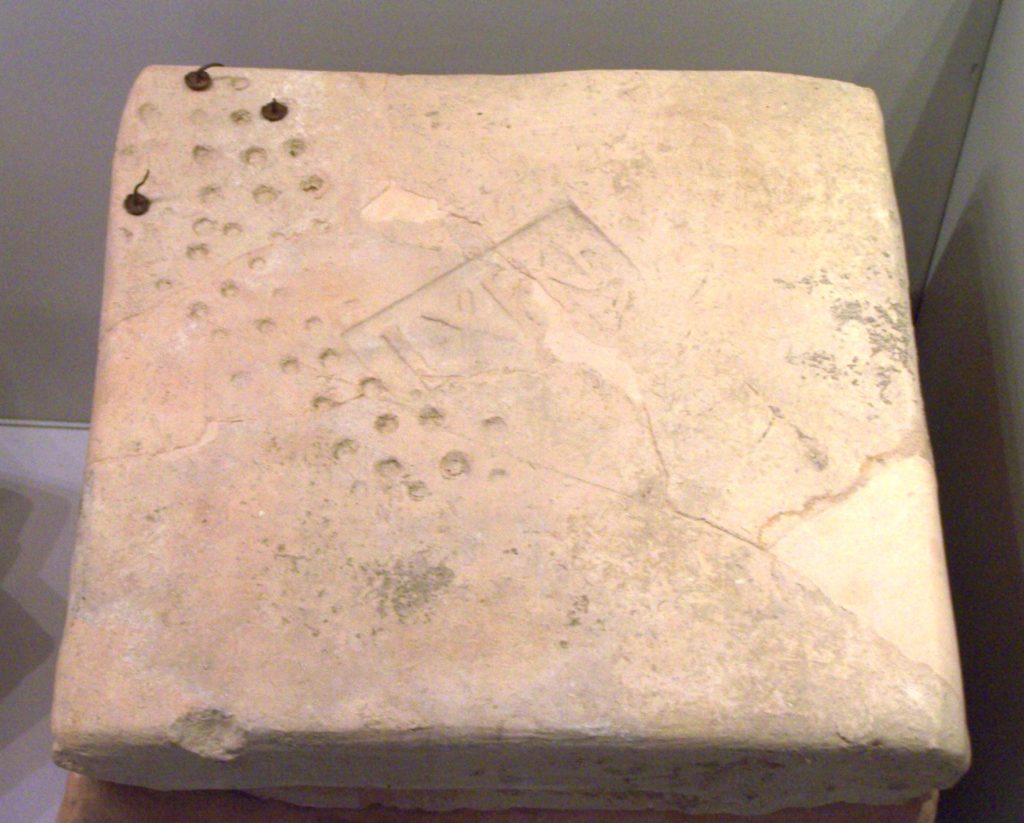
The prayer for the Ninth of Av also serves as our model for reconstructing ὑπό (hūpo, “by”) with בְּיַד (beyad, “by the hand of”).
On reconstructing ἔθνος (ethnos, “Gentile”) with גּוֹי (gōy, “Gentile”), see above, Comment to L3.
Jesus’ use of the trampling motif in Yerushalayim Besieged places the Gentiles in a distinctly negative light. It is one more expression of Jesus’ solidarity with Israel in this prophecy of Jerusalem’s destruction.
L47 עַד שֶׁיִּשְׁלְמוּ (HR). On reconstructing ἄχρι (achri, “until”) with עַד (‘ad, “until”), see Days of the Son of Man, Comment to L17.
Scholars have long noted the similarity between the phrase ἄχρι οὗ πληρωθῶσιν καιροὶ ἐθνῶν (“until the times of the Gentiles are fulfilled”) in Luke 21:24 and the phrase ἕως πληρωθῶσιν καιροὶ τοῦ αἰῶνος (“until the times of the age are fulfilled”) in Tobit 14:5.[148] The latter phrase belongs to the eschatological conclusion of the book of Tobit, which predicts that following the period of the Babylonian exile, during which Jerusalem will lie desolate, God will again have mercy on his people, bring them back to the land of Israel, and rebuild the Temple. This rebuilt Temple will not be as glorious as Solomon’s Temple, but when “the times of the age are fulfilled” the Temple will be beautified and the Gentiles, abandoning their idols, will learn to fear Israel’s God (Tob. 14:4-7). While the linguistic similarities between Yerushalayim Besieged and the eschatological conclusion of Tobit are undeniable, the tone of Jesus’ prophecy is much less sanguine than Tobit’s with respect to Jerusalem, the Temple and the Gentiles. Whereas the author of Tobit never foresaw a second destruction of the Temple, this is precisely what Jesus predicted. And whereas the Gentiles play a positive role in Tobit, in Jesus’ prophecy they are culpable agents of destruction who, by trampling on Jerusalem’s sanctity, kindle God’s ire against them.
Unfortunately, Tobit’s eschatological conclusion has not been preserved in its original language. While fragments of Tobit in Hebrew and Aramaic were discovered among the Dead Sea Scrolls, the eschatological portion is intact only in Greek translation. Nevertheless, the Qumran scrolls do provide clues as to how πληρωθῶσιν καιροί (“times are fulfilled”) should be reconstructed in Hebrew. The Damascus Document refers to:
כל הבאים אחריהם לעשות כפרוש התורה אשר התוסרו בו הראשנים עד שלים הקץ השנים האלה כברית אשר הקים אל לראשנים לכפר על עונותיהם כן יכפר אל בעדם ובשלום הקץ למספר השנים האלה אין עוד להשתפח לבית יהודה
…all those who enter [the covenant—DNB and JNT] after them to do according to the interpretation of the Torah in which the first ones were instructed until the completion of the time [עד שלים הקץ] of these years, according to the covenant that God established for the first ones to atone for their iniquities. Thus will God atone for them. And at the completion of the time [ובשלום הקץ] of the number of these years there will no longer be joining to the house of Judah…. (CD-A IV, 7-11)
Here the verb for “be complete” is שָׁלֵם (shālēm), and the noun for “time” is קֵץ (qētz). We find the same combination of terms in another Qumran text that appears to envision the time leading up to the eschatological judgment as a return to the primeval chaos:
[י]מים ותהמות פחדו ויתערערו כל רוח בשר ובני השמי[ם –] [הש]פטה וכל עולה תתם עוד ושלם קץ האמ[ת — ] בכל קצי עד כי אל אמת הוא
…[s]eas and deeps were afraid, and every spirit of flesh will be stirred up and the sons of the heaven[s — ] its [ju]dgment. And all wickedness will cease again, and the time [קץ] of tru[th] is complete [שלם] [ — ] in all the times of eternity, for he is a God of truth…. (4QInstructionb [4Q416] 1 I, 12-14)
Another Qumran text speaks as though the the final judgment has already taken place and the eternal age of blessedness has already commenced:
וימח [כו]ל פשע בעבור חס[ד]יו כיא שלם קץ הרשע וכול עולה ת[עבו]ר [כיא] באה עת הצדׄק…בא קץ השלום
And he will wipe out [ev]ery iniquity on account of his mer[ci]es, for the time of wickedness is complete [שלם קץ הרשע]. And every injustice will [pass aw]ay, [for] the time of righteousness has come…the time of peace has come…. (4Q215a 1 II, 3-6)
Citing examples such as these, Flusser suggested that the verb שָׁלֵם (shālēm, “be whole,” “be complete,” “end”) stood behind πληροῦν (plēroun, “to fill,” “to make full”) in both Luke 21:24 and Tob. 14:5.[149] Flusser also noted that “until the times of the Gentiles are complete” is reminiscent of the seminal prophecy of exile and redemption: God’s revelation to Abraham that Israel would be enslaved in Egypt for four hundred years, at the end of which Abraham’s descendants would return, “for the sin of the Amorites”—the inhabitants of the land of Canaan—“is not yet complete.”[150] In Hebrew and Greek this statement reads as follows:
כִּי לֹא שָׁלֵם עֲוֹן הָאֱמֹרִי עַד הֵנָּה
…for not is complete [שָׁלֵם] the sin of the Amorite until now. (Gen. 15:16)
οὔπω γὰρ ἀναπεπλήρωνται αἱ ἁμαρτίαι τῶν Αμορραίων ἕως τοῦ νῦν
…for not yet filled up [ἀναπεπλήρωνται] [are] the sins of the Amorites until now. (Gen. 15:16)
Here the LXX translators rendered שָׁלֵם (“complete”) with ἀναπληροῦν (anaplēroun, “to fill up”), a compound form of πληροῦν (“to fill”), the verb that appears in Luke 21:24 and Tob. 14:5.

It thus appears that by referring to “the times of the Gentiles” being “fulfilled” Jesus combined the eschatological concept of completing a foreordained period of time with the scriptural notion of the Gentiles amassing their sins until their measure is complete.[151] In other words, when the period of the Gentiles’ trampling of Jerusalem reaches its conclusion, the Gentiles’ sins will have attained their full measure and the time for God’s judgment will be ripe.[152] Of course, the corollary to the judgment meted out against the Gentiles is redemption for Israel. When the times of the Gentiles’ trampling of Jerusalem are over, the Gentiles will be expelled and Israel will be restored to its stewardship of the holy city.[153]
L48 καὶ ἔσονται (Luke 21:24). The words καὶ ἔσονται (kai esontai, “and they will be”) erroneously appear in the text of Codex Vaticanus, which serves as the base text for our reconstruction.[154] Because they certainly do not belong to the original text of Luke, we have omitted them from GR.
L49 קִצֵּי הַגּוֹיִם (HR). In Comment to L47 we cited examples in which the noun קֵץ (qētz) is used in the sense of “time,” “period” or “epoch.” In Biblical Hebrew קֵץ primarily means “end,” but a few examples of קֵץ in the sense of “time” do occur in late Biblical Hebrew (e.g., Ezek. 7:6).[155] This change in the meaning of קֵץ explains why there are so few instances in which the LXX translators rendered קֵץ as καιρός (kairos, “time”).[156] In Mishnaic Hebrew “time” became the dominant sense of קֵץ,[157] and this is one of the reasons we have adopted קֵץ as the equivalent of καιρός in HR.
Another reason for adopting קֵץ as the equivalent of καιρός in Yerushalayim Besieged is that in the Fig Tree parable, the final pericope of the “Destruction and Redemption” complex, there appears to have been a Hebrew wordplay based on the similarity between קַיִץ (qayitz, “summer,” “summer fruit”) and קֵץ (qētz, “time”).[158] If קֵץ occurred in the Fig Tree parable, then it is probable that this key term appeared in Yerushalayim Besieged too.
Finally, in Yerushalayim’s Destruction Foretold the phrase ὁ καιρός τῆς ἐπισκοπῆς σου (“the time of your visitation”; Luke 19:44) has a nearly exact parallel in the phrase קֵץ פְּקֻדָּה (“time of visitation”), which occurs in the Damascus Document (CD XIX, 11). Thus, there are strong reasons for supposing that the Greek translator of the Hebrew Life of Yeshua rendered קֵץ as καιρός in other LOY pericopae, which increases the likelihood that he also used καιρός to translate קֵץ in Yerushalayim Besieged.
Above in Comment to L47 we cited examples from DSS in which the verb שָׁלֵם (shālēm, “be whole,” “be complete,” “end”) was used with the noun קֵץ (“time”). Here we cite an example from a rabbinic source:
טָעוּ שִׁבְטוֹ שֶׁל אֶפְרִיִם וְיָצְאוּ מִמִּצְרַיִם עַד שֶׁלֹּא שָׁלֵם הַקֵּץ, וְנֶהֶרְגוּ מֵהֶם ל′ רִבּוֹא. וְלָמָּה נֶהֶרְגוּ, שֶׁחָשְׁבוּ מִיּוֹם שֶׁנִּדְבַּר אַבְרָהָם בֵּין הַבְּתָרִים וְטָעוּ ל′ שָׁנָה
The tribe of Ephraim made a mistake and departed from Egypt before the time [for Israel’s redemption—DNB and JNT] was complete [שָׁלֵם הַקֵּץ], and [as a result] thirty thousand of them were killed. And why were they killed? Because they thought [the four hundred years of the “time” of Egypt—DNB and JNT] was [counted] from the day that it was spoken of to Abraham between the pieces, and so they erred by thirty years. (Exod. Rab. 20:11 [ed. Merkin, 5:240])
On reconstructing ἔθνος (ethnos, “Gentile”) with גּוֹי (gōy, “Gentile”), see above, Comment to L3.

Why did Jesus refer to “times [plur.] of the Gentiles”? Perhaps it is because he viewed the trampling of Jerusalem by the Romans as belonging to a long series of “times” of Jerusalem’s trampling.[159] Among these might be included “the time of the Babylonians” and “the time of the Greeks.” Thus, Jesus does not envision the redemption of Jerusalem until all such “times” are completed. Does “times of the Gentiles” leave open the possibility that other kingdoms would trample Jerusalem, now that the Romans have exited the stage of history? Could “the time of the Ottomans” or “the time of the British” be accommodated to Jesus’ prophetic scheme?[160] Perhaps. But it is more likely that Jesus anticipated that “the time of the Romans” would culminate the series of Gentile empires that would trample Jerusalem.
L50 οἵα οὐ γέγονεν τοιαύτη (Mark 13:19). Mark’s wording in L50, οἵα οὐ γέγονεν τοιαύτη (hoia ou gegonen toiavtē, “such as has not been the like”) is a paraphrase of οἵα οὐκ ἐγενήθη (hoia ouk egenēthē, “such as has not happened”) in Dan. 12:1.
The demonstrative pronoun τοιοῦτος (toisoutos, “of such kind,” “such as this”) occurs with a higher frequency in Mark’s Gospel (6xx) compared to the Gospels of Luke (2xx) and Matthew (3xx).[161] Moreover, this term appears in Mark in two clearly redactional passages (Mark 4:33 [Speaking in Parables]; 7:13 [True Source of Impurity]), and since we regard Mark 13:19 also to be redactional it is not surprising to find the author of Mark expressing himself with typically Markan vocabulary.
The author of Matthew economized by dropping Mark’s superfluous τοιαύτη (toiavtē, “the like of this”).
L51 ἀπ᾿ ἀρχῆς κτίσεως (Mark 13:19). Mark’s ἀπ᾿ ἀρχῆς κτίσεως (ap archēs ktiseōs, “from the beginning of creation”) appears to be a paraphrase of the ambiguous ἀφ᾿ οὗ ἐγενήθησαν (af hou egenēthēsan, “from when they came to be”) in Dan. 12:1. It is possible, however, that Mark’s paraphrase was informed by an interpretive tradition that arose from the ambiguity of Daniel’s language. According to the Masoretic text, Dan. 12:1 reads as follows:
וְהָיְתָה עֵת צָרָה אֲשֶׁר לֹא נִהְיְתָה מִהְיוֹת גּוֹי עַד הָעֵת הַהִיא
And there will be a time of distress which has not been from being a nation [מִהְיוֹת גּוֹי] until that time. (Dan. 12:1)
What does מִהְיוֹת גּוֹי (mihyōt gōy, “from being a nation”) mean in this context? It could mean that there will be a time of distress that has not been since Israel became a nation. Or מִהְיוֹת גּוֹי could be interpreted “since a Gentile came into being,” meaning that this would be the worst time of distress since there were Gentile nations who oppressed Israel. Or מִהְיוֹת גּוֹי could mean “since any nation—Jew or Gentile—came into existence.” The LXX translators appear to have glossed over the difficulty, but a comparison of two Second Temple sources that allude to Dan. 12:1 suggests that there may have been a pre-Masoretic textual variant in this verse. The first source is 1 Maccabees:
καὶ ἐγένετο θλῖψις μεγάλη ἐν τῷ Ισραηλ, ἥτις οὐκ ἐγένετο ἀφ᾿ ἧς ἡμέρας οὐκ ὤφθη προφήτης αὐτοῖς
And there was great trouble in Israel, which had not been since the day a prophet was not seen among them. (1 Macc. 9:27)
The second source is the Assumption of Moses:
Et…veniet in eos ultio et ira, quae talis non fuit in illis a saeculo usque ad illud tempus
And…there will come upon them a visitation and wrath such as has not befallen them from the beginning[162] until that time…. (As. Mos. 8:1; trans. Charles)[163]
Could these two sources, with such disparate interpretations of Dan. 12:1, reflect a single textual variant? Perhaps. According to Charles, the Latin text of As. Mos. 8:1 could be reconstructed in Greek as οἵα οὐκ ἐγένετο ἐν αὐτοῖς ἀπὸ τοῦ αἰῶνος ἕως ἐκείνου τοῦ καιροῦ (“such as has not happened among them from the eternity until that time”).[164] A Hebrew reconstruction might be אֲשֶׁר לֹא נִהְיְתָה מִיְּמוֹת עַד עַד הָעֵת הַהִיא (“which has not been from the days of old until that time”).[165] In an unpointed text מימות עד might be understood either as “from days of old” (reading עד as עַד [‘ad, “eternity”]) or as “from the days of a witness” (reading עד as עֵד [‘ēd, “witness”]). Adopting this second reading, the author of 1 Maccabees might have concluded that “witness” meant prophet, since prophets sometimes functioned as witnesses (cf. Neh. 9:26, 30; 2 Chr. 24:19; Rev. 11:3). On the other hand, if the author of Mark was acquainted with a tradition that adopted the first reading, “from days of old,” he might well have equated “the days of old” with “the beginning of creation.”[166]
However the author of Mark came by his paraphrase of Dan. 12:1, we do not believe it had anything to do with either of his two primary sources, Luke and Anth. Matthew’s ἀπ᾿ ἀρχῆς κόσμου (ap archēs kosmou, “from the beginning of the world”) is a simplification of Mark’s redundant ἀπ᾿ ἀρχῆς κτίσεως ἣν ἔκτισεν ὁ θεός (ap archēs ktiseōs hēn ektisen ho theos, “from the beginning of creation which God created”; L51-52).[167]
L52 ἣν ἔκτισεν ὁ θεὸς (Mark 13:19). Redundant or reiterative descriptions, such as “creation which God created,” are consistent with Markan style. Another example occurs in L59-60 (“the elect whom he [i.e., the Lord] chose”; Mark 13:20).[168] Additional examples of Markan reiterations include ἡ παράδοσις ὑμῶν ἣ παρεδώκατε (hē paradosis hūmōn hē paredōkate, “your handed-down tradition which you handed down”; Mark 7:13), τό βάπτισμα ὃ ἐγὼ βαπτίζομαι (to baptisma ho egō baptizomai, “the immersion which I immerse”; Mark 10:38, 39) and οἱ στασιασταὶ…ἐν τῇ στάσει (hoi stasiastai…en tē stasei, “the rebels…in the rebellion”; Mark 15:7).
L53 ἕως τοῦ νῦν (Mark 13:19). Mark’s “until now” is roughly equivalent to ἕως τῆς ἡμέρας ἐκείνης (“until that day”) in Dan. 12:1. The author of Matthew copied this phrase from Mark.
L54 καὶ οὐ μὴ γένηται (Mark 13:19). The promise that no such trouble will ever happen again is unparalleled in Dan. 12:1.[169] For the author of Mark and his readers, who looked back on the events Jesus predicts in Mark 13:14-20, this promise must have been a true source of comfort; the worst was already over, nothing that lay ahead would equal the horrific experiences of the past. The author of Matthew accepted these words from Mark, but since his perspective was different, these words lost their consoling effect. For the author of Matthew, an unprecedented disaster was yet to come—upon the Jewish people.
L55 καὶ εἰ μὴ ἐκολόβωσεν (Mark 13:20). It seems best to read Mark 13:20 not as a continuation of Jesus’ speech but as an authorial aside in which the author of Mark adds his own remarks about the horrible days of trouble described in the previous verse.[170] Our reasons for regarding Mark 13:20 as an authorial aside are twofold. First, the tense has changed to the aorist in Mark 13:20,[171] whereas in the preceding verse Jesus had spoken in the future tense (L37). Second, Mark 13:20 refers to the “Lord” as the one who cut short the days of trouble, but there is no clear-cut case in the Synoptic Gospels where Jesus refers to God simply as “Lord” (see below, Comment to L56). This raises the possibility that the “Lord” in Mark 13:20 is not God, who was referred to in Mark 13:19 as ὁ θεός (ho theos, “the God”), but Jesus. In other words, Jesus is the one who cut short the days of trouble for the sake of the elect whom he chose. The suggestion that Mark 13:20 is an authorial aside becomes all the more credible when we recall that the author of Mark has already inserted comments of his own in this pericope. “Let the reader understand” in Mark 13:14 (L10) clearly was not spoken by Jesus. This exhortation to understanding came from the author of Mark, who spoke directly to his readers in the middle of Jesus’ speech. Having done so once, it should not surprise us that he did so again.
The author of Matthew made several changes to the wording of Mark 13:20 in order to absorb what was originally an authorial aside into Jesus’ speech. We will note these changes in the comments below. Here it will suffice to recall that the author of Matthew had similarly assimilated Mark’s authorial aside in Mark 13:14 into Jesus’ speech (see above, Comment to L10).
L55-57 καὶ εἰ μὴ ἐκολόβωσεν κύριος τὰς ἡμέρας (Mark 13:20). The cutting short of the days of trouble described in Mark 13:20 is similar to the hastening of the days until the final redemption prayed for by Ben Sira[172] and referred to in the War Scroll,[173] Pseudo-Philo’s Biblical Antiquities[174] and other sources.[175] The precise image of cutting off the days, however, appears only in a small cluster of sources. In addition to Matt. 24:22 ∥ Mark 13:20, we read of the cutting off of the days in a pseudepigraphon discovered at Qumran known as 4QpsEzekiela and in the epistle of Barnabas, a virulent anti-Jewish Christian document which nevertheless drew on Second Temple Jewish sources. In 4QpsEzekiela we read:
ויתבהלו הימים מהר עד אשר יאמרו האדם הלא ממהרים הימים למען יירשו בני ישראל ויאמר יהוה אלי לא אש[י]ב פניך יחזקאל הנ[נ]י גודד את הימים ואת השני[ם — ]ל[ — ]
Let the days hasten quickly until people will say, “Are not the days hastening so that the children of Israel may inherit?” And the Lord said to me, “I will not turn away your face, Ezekiel. Behold! I am cutting off the days and the year[s — ]….” (4QpsEzeka [4Q385] 3 I, 2-5)[176]
Similarly, in the epistle of Barnabas we find:
ὡς Ἐνὼχ λεγει Εἰς τοῦτο γὰρ ὁ δεσπότης συντέτμηκεν τούς καροὺς καὶ τὰς ἡμέρας, ἵνα ταχύνῃ ὁ ἠγαπημένος αὐτοῦ καὶ ἐπὶ τὴν κληρονομίαν ἥξῃ
As Enoch says, “For to this end the Lord cut off the times and the days, so that his beloved might hasten and come upon the inheritance.” (Barn. 4:3)[177]
It seems impossible to avoid the conclusion that all three sources—the Gospel of Mark, 4QpsEzekiela and the epistle of Barnabas—drew upon a common tradition.[178] In all three sources some variant for “the Lord” occurs, all three use a verb for cutting off or amputation, and in all three sources it is days that are cut off. Of the three sources, 4QpsEzekiela and the epistle of Barnabas are the most closely related, since they both mention an inheritance and in both sources “the Lord/Lord” is God. In Mark “the Lord” is probably to be identified as Jesus, no inheritance is mentioned, and the cutting off of days is related to a period of trouble that threatened to destroy all humankind. The parallels in 4QpsEzekiela and the epistle of Barnabas prove beyond any shadow of a doubt that when the author of Mark reworked Jesus’ prophecy of the destruction of Jerusalem he tapped into an apocalyptically oriented tradition with deep roots in Second Temple Judaism.
L56 κύριος (Mark 13:20). There are two reasons for supposing that the “Lord” spoken of in Mark 13:20 is Jesus.[179] First, except when quoting Scripture or employing a fixed liturgical formula, Jesus did not refer to God as “the Lord.”[180] The author of Mark, on the other hand, applied the title “Lord” to Jesus several times in his Gospel,[181] and since we believe Mark 13:20 is an authorial aside, it is natural to suppose that the author of Mark was referring to Jesus by his dominical title.[182] Second, the Lord who does the cutting off of the days in Mark 13:20 is the same Lord who elects the elect. Further in Mark’s eschatological discourse the author of Mark depicts Jesus in the guise of the Son of Man coming to gather his elect (Mark 13:27).[183] Since the elect belong to Jesus in Mark 13:27, it stands to reason that Jesus is the Lord who elected the elect in Mark 13:20.
Nevertheless, it is clear that the author of Mark chose to refer to Jesus by the title “Lord” because he was tapping into the tradition concerning the Lord’s cutting off of the days, which we discussed in the previous Comment. By the same token, Matthew’s omission of “Lord,” which he achieved by switching the verb κολοβοῦν (koloboun, “to cut off,” “to amputate”) to the passive voice (L55) and by making “the days” (L57) the subject of the verb, is shown to be redactional, since some equivalent of “Lord” appears in 4QpsEzekiela and the epistle of Barnabas and therefore clearly belongs to the received tradition.
L57 αἱ ἡμέραι ἐκεῖναι (Matt. 24:22). In L38 the author of Matthew replaced Mark’s αἱ ἡμέραι ἐκεῖναι (hai hēmerai ekeinai, “those days”) with τότε (tote, “then”). Here in L57 and again in L62 the author of Matthew compensated for this replacement by changing Mark’s “the days” to “those days.” In this way the author of Matthew has achieved a smoother text: whenever the period of crisis sparked by the appearance of the abomination of desolation is mentioned in Matthew, it is always referred to as “those days” (L33, L57, L62).
L58 οὐκ ἂν ἐσώθη πᾶσα σάρξ (Mark 13:20). Many scholars have remarked that Mark’s phrase οὐκ ἂν ἐσώθη πᾶσα σάρξ (ouk an esōthē pasa sarx, “all flesh would not have been saved”) has a Semitic ring.[184] While we do not deny this, we attribute the Semitic quality of Mark’s phrasing to the apocalyptic traditions upon which the author of Mark drew rather than supposing that Mark here echoes the words of Jesus.
The author of Matthew copied Mark’s wording in L58 exactly.
L59 ἀλλὰ διὰ τοὺς ἐκλεκτοὺς (Mark 13:20). Flusser once remarked that Mark 13:20 may be the best example of the author of Mark’s sectarian mindset.[185] While the tragedy of 70 C.E. affected the entire Jewish people, the author of Mark perceived only how those events were experienced by the “elect,” the author of Mark’s inward-looking community of believers. The author of Matthew’s outlook was sectarian, too, and he readily accepted Mark’s wording, but took it one step further by attributing these words to Jesus.
L60 οὓς ἐξελέξατο (Mark 13:20). Like the redundant “which God created” in L52, the qualifier “whom he chose” in L60 is superfluous but consistent with Markan style.[186] The author of Matthew dropped this redundant qualifier for the sake of brevity and enhanced Greek style.
L61 κολοβωθήσονται (Matt. 24:22). Whereas the author of Mark, looking back on the trauma his community endured in 70 C.E., spoke of the cutting off of those terrible days in the past tense, the author of Matthew changed the verb tense to the future.[187] From the author of Matthew’s perspective, the appearance of the abomination of desolation and the cosmic upheavals it occasions still lay in the future.[188]
L62 αἱ ἡμέραι ἐκεῖναι (Matt. 24:22). As in L57, the author of Matthew changed “the days” to “those days” in order to achieve greater uniformity of language.
Redaction Analysis
Two recensions of Jesus’ prophecy of the Temple’s destruction and Jerusalem’s conquest have been preserved in the Synoptic Gospels. Luke’s recension reflects the pre-synoptic tradition, while the Markan-Matthean recension is a post-70 C.E. apocalyptic reworking of Luke’s version of Jesus’ prophecy.
Luke’s Version[189]
| Yerushalayim Besieged | |||
| Luke | Anthology | ||
| Total Words: |
93 | Total Words: |
82 |
| Total Words Identical to Anth.: |
77 | Total Words Taken Over in Luke: |
77 |
| % Identical to Anth.: |
82.80 | % of Anth. in Luke: |
93.90 |
| Click here for details. | |||
The author of Luke depended on FR for his version of Yerushalayim Besieged. As a result, Luke’s version does not represent Anth.’s version in every respect. Nevertheless, Luke’s fidelity to FR and the First Reconstructor’s limited redactional activity mean that Anth.’s wording is not too difficult to reconstruct.[190] The main changes the First Reconstructor made to Anth. were stylistic in nature: adopting a more Greek word order in L2-4, changing the nondescript “Gentiles” to the more vivid “encampments” in L3, adding τότε (“then”) in L5 and L11 to provide a clearer sense of progression, writing ἀνάγκη (“duress”) in place of θλῖψις (“trouble”) in L39 in order to reproduce a common Greek phrase, and adding πάντα (“all”) in L44.
Of a different order are the changes the First Reconstructor made in L11-12, where he inserted a command to those in Judea to flee to the mountains, and in L15, where he changed “in the field” to “in the countries.” These two changes were motivated by the First Reconstructor’s desire to include within Jesus’ prophecy guidance for the congregations that had expanded beyond Jerusalem into Judea and the diaspora. When the Roman legions advanced on Jerusalem, the congregations in Judea should seek refuge in the hills, while members of diaspora congregations should not venture into the Judean province at all.
Despite these changes, Luke’s version of Yerushalayim Besieged provides us with a fairly accurate picture of Jesus’ prophecy.
Mark’s Version[191]
| Abomination of Desolation (Yerushalayim Beseiged) |
|||
| Mark | Anthology | ||
| Total Words: |
115 | Total Words: |
82 |
| Total Words Identical to Anth.: |
16 | Total Words Taken Over in Mark: |
16 |
| % Identical to Anth.: |
13.91 | % of Anth. in Mark: |
19.51 |
| Click here for details. | |||
Mark’s redaction of Luke 21:20-24 was so extensive that the title Yerushalayim Besieged is no longer an apt name for his version of this pericope. Jerusalem is never mentioned by name in Mark’s version, and Jesus’ deep solidarity with Israel evident in Luke’s version has given way to a sectarian perspective focused on the trauma experienced within the Markan community during the revolt against Rome. To make sense of what his community had endured, the author of Mark reinterpreted Jesus’ prophecy in apocalyptic terms, especially relying on Daniel’s visions. As a result of these pervasive changes, only a few points of verbal contact between the Lukan and Markan versions of Jesus’ prophecy remain (L1, L6, L11-12, L30-33, L37-39). The author of Mark’s most sustained agreement with his source is Jesus’ lament for pregnant women and nursing mothers (L30-33). Here the pathos of Jesus’ lamentation matched the Markan community’s vivid recollections of the destruction of Jerusalem and the Temple.
Matthew’s Version[192]
| Abomination of Desolation (Yerushalayim Beseiged) |
|||
| Matthew | Anthology | ||
| Total Words: |
115 | Total Words: |
82 |
| Total Words Identical to Anth.: |
18 | Total Words Taken Over in Matt.: |
18 |
| % Identical to Anth.: |
15.65 | % of Anth. in Matt.: |
21.95 |
| Click here for details. | |||
Matthew’s version of Jesus’ prophecy is a revision of Mark’s recension. Some of his changes are mere stylistic improvements, such as changing δέ (“but”) to οὖν (“therefore”) in L1, the omission of superfluous words or phrases (L21, L50, L52, L60), or the decision to consistently refer to the time of crisis occasioned by the abomination of desolation as “those days” (L57, L62). The author of Matthew also changed Mark’s wording in more significant ways. Mark’s two authorial asides (“Let the reader understand” in L10; “If the Lord had not cut off the days” etc. in L55-62) have been absorbed into Jesus’ speech in Matthew’s parallels. In the first instance, the author of Matthew achieved this absorption of Mark’s authorial aside into Jesus’ speech by adding “the one spoken of by Daniel the prophet” in L7-8, which had the effect of changing “Let the reader understand” into “Let the reader of the book of Daniel understand,” whereas in Mark “Let the reader understand” had meant “Let the reader of this Gospel understand.” The author of Matthew absorbed Mark’s second authorial aside into Jesus’ direct speech by changing active verbs in L55 and L61 to passives and removing “Lord” in L56.
Other Matthean changes were not motivated by literary concerns to make Jesus the sole speaker throughout the pericope, but by the author of Matthew’s ideological perspective. Whereas in Luke’s version of Jesus’ prophecy Jesus is in complete solidarity with Israel, and whereas Mark’s version of Jesus’ prophecy evinces a sectarian perspective in which the experiences of the insular Markan community drown out concern for the wider Jewish community, which was no less affected by the traumatic events of the Jewish revolt, the perspective of Matthew’s version of Jesus’ prophecy is (dis)colored by anti-Jewish sentiment. Jesus’ lament for Jewish mothers, which had already become in Mark a lament for mothers belonging to the Markan community, becomes in Matthew a taunt in which the author of Matthew gloats over the fate of Jewish mothers. The attempts of Jewish mothers to escape the outpouring of God’s wrath would be as futile as the attempts of Jewish men to flee Judea without their cloaks and belongings. Likewise, Matthew’s addition of “Pray that your flight may not be…on the Sabbath” (L34-36) reflects an anti-Jewish stereotype common among Gentiles, namely that Jews were so foolish and legalistic that they would not even lift a finger to save themselves if it happened to be the Sabbath.
Not only has the perspective shifted from sectarian in Mark to anti-Jewish in Matthew, the chronological perspective in Matthew’s version has also shifted when compared to Mark’s. The author of Mark looked back on the events of 70 C.E. and reinterpreted Jesus’ prophecy accordingly. The author of Matthew, by contrast, had no interest in the events of 70 C.E. and imagined that Jesus’ prophecy must concern events that still lay in the future. For this reason the author of Matthew changed Mark’s aorist verb in L61 to the future tense.
A final cause of the differences between the wording of the Markan and Matthean versions of Jesus’ prophecy is the author of Matthew’s occasional preference for Anth.’s wording over Mark’s. These instances can be detected because they are rare points at which Matthew’s version of Jesus’ prophecy agrees with Luke against Mark ([L22, L23,] L37, L39). Despite these occasional nods to Anth.’s wording, overall the author of Matthew clearly preferred Mark’s sectarian, apocalyptic reworking of Jesus’ prophecy.
Results of This Research
1. What (or who) was “the abomination of desolation”? The answer to this question depends on of whom it is asked. In the book of Daniel the abomination of desolation is a cipher for the desecrating sacrilege Antiochus IV Epiphanes erected in the Temple in the second century B.C.E.
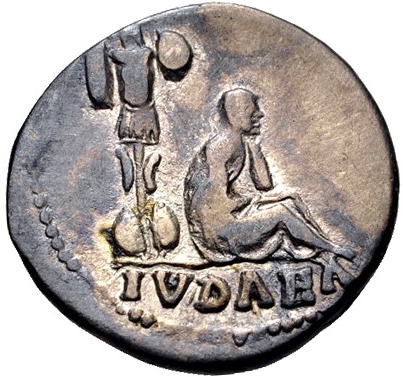
In Mark 13:14 Daniel’s apocalyptic cryptogram is redeployed to refer to the Roman desecration of the Temple in 70 C.E. The author of Mark may have had in mind a particular act of desecration, such as Titus’ trespass into the Holy of Holies or the sacrifice of the Roman legionaries to their idolatrous standards on the Temple Mount. It is also possible that the author of Mark used Daniel’s apocalyptic term as a shorthand for the entire process of Roman subjugation of the Temple Mount.
Because the author of Matthew understood Jesus’ prophecy as describing events that were still in the future at the time he composed his Gospel (ca. 100 C.E.), the abomination of desolation in Matt. 24:15 must refer to something other than the Roman desecration of the Temple in 70 C.E. It is possible that the author of Matthew believed that a Jewish Temple in Jerusalem would be rebuilt, and that this rebuilt Temple would itself be the abomination of desolation. Or perhaps the author of Matthew thought that the abomination of desolation would appear in a rebuilt Jewish Temple. However the author of Matthew conceived of the abomination of desolation, he believed it would be the spark that ignited the final outpouring of God’s wrath upon the Jewish people.
2. Why does Matthew’s version mention fleeing on the Sabbath? Whereas many scholars have assumed that the reference to fleeing on the Sabbath is a reflection of the author of Matthew’s (and his Gospel’s and his community’s) Jewishness, we believe the opposite to be true. The reference to the Sabbath in Matt. 24:20 is an example of a Gentile anti-Jewish stereotype that erroneously caricatured the Jewish people as too foolish and legalistic to take action that would save their lives if it happened to be the Sabbath.
3. Does Yerushalayim Besieged contain an authentic prophecy of Jesus, or were the events of 70 C.E. projected back onto Jesus by the authors of the Gospels and their sources? The Markan and Matthean versions of Jesus’ prophecy are post-70 C.E. reworkings of Jesus’ prophecy. On the other hand, Jesus’ complete identification with the Jewish people, and the rootedness of Jesus’ prophecy in Israel’s prophetic tradition—with its pattern of destruction and exile as a punishment for Israel’s disobedience and eventual redemption from the Gentiles and vindication of God’s promises—testify to the basic authenticity of Luke’s version of Yerushalayim Besieged. No doubt some modifications to Yerushalayim Besieged took place in the pre-synoptic stages of transmission. Nevertheless, the core of Yerushalayim Besieged is so at home in Second Temple Judaism that there is no reason to deny that this prophecy could have originated with Jesus.
Conclusion
In Yerushalayim Besieged Jesus describes and laments the consequences that will befall Israel as a result of its rejection of the Kingdom of Heaven and its ways of peace. Having embraced a political and religious ideology of militant Jewish nationalism, the Jewish people were hurtling toward a catastrophic clash with the Roman Empire. In that clash the Temple would be destroyed and Jerusalem would be laid waste. Many in Israel would be killed, and many who survived would be taken captive among the Gentiles. But Israel was not without hope. When God’s anger passed, he would remember his covenant promises and bring the times of the Gentiles’ trampling of Jerusalem to an end. By that time the Gentiles will have filled up the full measure of their sins and it will be their turn to feel God’s fury. When this happened, the time for the redemption of Israel, the restoration of Jerusalem and the rebuilding of the Temple would be ripe.
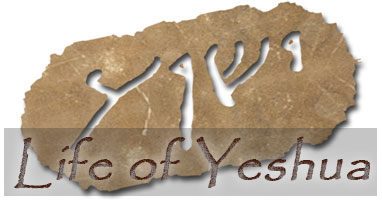 Click here to return to The Life of Yeshua: A Suggested Reconstruction main page.
_______________________________________________________
Click here to return to The Life of Yeshua: A Suggested Reconstruction main page.
_______________________________________________________
Paid Content
Premium Members and Friends of JP must be logged in to access this content: Login
If you do not have a paid subscription, please consider registering as a Premium Member starting at $10/month (paid monthly) or only $5/month (paid annually): Register
One Time Purchase Rather Than Membership
Rather than purchasing a membership subscription, you may purchase access to this single page for $1.99 USD. To purchase access we strongly encourage users to first register for a free account with JP (Register), which will make the process of accessing your purchase much simpler. Once you have registered you may login and purchase access to this page at this link:
- [1] For abbreviations and bibliographical references, see “Introduction to ‘The Life of Yeshua: A Suggested Reconstruction.’” ↩
- [2] This translation is a dynamic rendition of our reconstruction of the conjectured Hebrew source that stands behind the Greek of the Synoptic Gospels. It is not a translation of the Greek text of a canonical source. ↩
- [3] Cf. Nolland, Luke, 3:999. ↩
- [4] See the discussion in our introduction to the “Destruction and Redemption” complex. ↩
- [5] Fitzmyer (2:1342) could not believe that the prophecy in Mark 13:14-20 ∥ Luke 21:20-24 originated with Jesus, but his incredulity may be attributed in large part to his assumption of Markan Priority. By contrast, according to Flusser, “There is…no reason to deny the possibility that the prophecy of destruction in Luke 21:20-24 was delivered by Jesus himself.” See David Flusser, “The Times of the Gentiles and the Redemption of Jerusalem,” under the subheading “Prophecies of Redemption.” See also “Corrections and Emendations to Flusser’s Judaism of the Second Temple Period,” correction to “‘Jerusalem in Second Temple Literature’ (2:72-73).” Flusser’s conclusion was based on his acceptance of the Lukan version of Jesus’ prophecy as the more authentic version. ↩
- [6] See Josephus’ report on the would-be prophet Theudas (Ant. 20:97-98), whose uprising was put down during Fadus’ term as the Judean governor from 44-46 C.E. Josephus also reports that two revolutionary leaders, Jacob and Simon, sons of Judas the Galilean, were crucified during the term of Tiberius Julius Alexander (46-48 C.E.) (Ant. 20:102). It is possible that the family of Judas the Galilean entertained messianic ambitions. ↩
- [7] Cf. Nolland, Luke, 3:1000. ↩
- [8] Cf. Wolter, 2:427. ↩
- [9] Cf. Rev. 11:1-2, which is likely taken from a pre-70 C.E. source. On the belief that the Temple would not fall into enemy hands, see David Flusser, “Hystaspes and John of Patmos” (Flusser, JOC, 390-453, esp. 391-392, 438-439); idem, “Jerusalem in Second Temple Literature” (Flusser, JSTP2, 44-75, esp. 65-75). ↩
- [10] See Jonathan J. Price, Jerusalem Under Siege: The Collapse of the Jewish State 66-79 C.E. (Leiden: Brill, 1992), 171. ↩
- [11] The courses and outcomes of Roman sieges—the destruction of the besieged fortress, the killing of its armed defenders, the rape of the women, the massacre of the inhabitants, and the enslavement of the survivors—were so predictable that many Jews at Masada preferred mass suicide to waiting for the siege to end. See Shimon Applebaum, “The Zealots: The Case for Revaluation,” Journal of Roman Studies 61 (1971): 155-170, esp. 169. ↩
- [12] On a pre-70 C.E. date for Luke’s Gospel, cf. Charles Cutler Torrey, The Composition and Date of Acts (Cambridge, Mass.: Harvard University Press, 1916), 68-70; John A. T. Robinson, Redating the New Testament (Philadelphia: Westminster Press, 1976), 86-92 (these pages concern the date of Acts, but it is assumed that Luke’s Gospel was completed before Acts). ↩
- [13] Pace Bultmann, 123; Fitzmyer, 2:1343; Theissen, Gospels, 278-279; Bovon, 3:115. ↩
- [14] Cf. Fredriksen, From Jesus, 50-51, 184-185. ↩
- [15] The same chronological scheme is expressed at the end of Matthew’s Gospel, where the disciples are charged with making disciples of all nations with the assurance that Jesus will be with them until the end of the age (Matt. 28:19-20). ↩
- [16] Cf. Luz, 3:192-195, 200. According to Luz (194-195), however, the author of Matthew believed the proclamation of the Gospel to all nations had already been achieved. On this point we disagree. ↩
- [17] Note the εὐθέως (evtheōs, “immediately”) in Matt. 24:29. “Immediately” after the great tribulation caused by the abomination of desolation the cosmic order is upset and the Son of Man appears. ↩
- [18] Cf. Fred W. Burnett, The Testament of Jesus-Sophia: A Redaction-Critical Study of the Eschatological Discourse in Matthew (Washington, D.C.: University Press of America, 1979), 301-302.
If the author of Matthew regarded the appearance of the abomination of desolation as a future event, we wonder what sort of event he thought it would be. Was the author of Matthew afraid that a pagan temple would be built on the vacant site of the Jewish Temple? Or might he have feared that a Jewish Temple would be rebuilt in Jerusalem? Some church fathers believed the Antichrist would build a temple in Jerusalem and there proclaim himself to be God. See Irenaeus, Against Heresies 5:25 §2; Hippolytus, Treatise on Christ and Antichrist 2:6. Or did the author of Matthew divorce the appearance of the abomination of desolation from the site of the Second Temple? For further discussion, see Comment to L9. ↩ - [19] Cf. Fredriksen, From Jesus, 51. Meier thought that in Matthew “the abomination of desolation” has a double reference: both the destruction in 70 C.E. and a future catastrophe are simultaneously meant. See John P. Meier, Matthew (New Testament Message 3; Wilmington, Del.: Michael Glazier, 1980), 283-284. ↩
- [20] On the dates of the Synoptic Gospels and their sources, see LOY Excursus: The Dates of the Synoptic Gospels. ↩
- [21] Cf., e.g., Torrey, The Composition and Date of Acts, 69-70; Bultmann, 123; Conzelmann, 134-135; Fitzmyer, 2:1342. ↩
- [22] Cf., e.g., Taylor, 511; Paul Winter, “The Treatment of His Sources by the Third Evangelist in Luke XXI-XXIV,” Studia Theologica 8.1 (1954): 138-172; Lloyd Gaston, No Stone On Another: Studies in the Significance of the Fall of Jerusalem in the Synoptic Gospels (Leiden: Brill, 1970), 355-357. See also Bovon, 3:114. ↩
- [23] Cf. Gundry, Matt., 481. ↩
- [24] In LXX ὅταν + subjunctive occurs as the translation of -בְּ + infinitive construct (+ pronominal suffix) in Exod. 30:8; Lev. 12:6; 23:22; Num. 9:19; 10:7; Prov. 1:27; Isa. 30:25; Ezek. 46:9; Dan. 11:34. ↩
- [25] See Segal, 165 §344; Kutscher, 126 §210. ↩
- [26] Cf., e.g., m. Peah 3:5; 5:5; m. Dem. 5:5; 6:1; m. Kil. 5:5; m. Hal. 2:2; m. Shab. 18:2; m. Eruv. 5:9; 6:7; m. Ned. 6:6; m. Git. 5:6; 8:9; m. Bab. Metz. 7:9. ↩
- [27] C. H. Dodd, “The Fall of Jerusalem and the ‘Abomination of Desolation,’” Journal of Roman Studies 37 (1947): 47-54, esp. 48. ↩
- [28] Bovon (3:114 n. 65) suggested that the author of Luke chose the form Ἰερουσαλήμ to underscore Jerusalem’s holiness. But if that had been his aim, the author of Luke would have been better served by adopting the Hellenized form Ἱεροσόλυμα, which was meant to sound to Greek ears like “Holy Soluma.” See Cadbury, Making, 227. For a critique of the view that the author of Luke used the Hebraic form Ἰερουσαλήμ to evoke Jerusalem’s holiness, see Dennis D. Sylva, “Ierousalēm and Hierosoluma in Luke-Acts,” Zeitschrift für die neutestamentliche Wissenschaft und die Kunde der älteren Kirche 74.3-4 (1983): 207-221. ↩
- [29] See Hatch-Redpath, 2:789. ↩
- [30] See Dos Santos, 139. ↩
- [31] See Hanan Eshel, “The Kittim in the War Scroll and in the Pesharim,” in Historical Perspectives: From the Hasmoneans to Bar Kokhba in Light of the Dead Sea Scrolls (ed. David Goodblatt, Avital Pinnick, and Daniel R. Schwartz; Leiden: Brill, 2001), 29-44, esp. 41-42. ↩
- [32] See Hatch-Redpath, 2:1296. ↩
- [33] See Hatch-Redpath, 1:362-363. ↩
- [34] See Sending the Twelve: Conduct in Town, Comment to L105. ↩
- [35] Scholars have noted that in DSS verbs formed from the ק-ר-ב and נ-ג-ע roots are nearly synonymous and interchangeable. See M. Kister and E. Qimron, “Observations on 4QSecond Ezekiel (4Q385 2-3),” Revue de Qumrân 15.4 (60) (1992): 595-602, esp. 597. ↩
- [36] See Robert L. Lindsey, “From Luke to Mark to Matthew: A Discussion of the Sources of Markan “Pick-ups” and the Use of a Basic Non-canonical Source by All the Synoptists,” under the subheading “An Examination of the Editorial Activity of the First Reconstructor,” Comment to L61; Flusser, “The Times of the Gentiles and the Redemption of Jerusalem,” under the subheading “Mark’s Sectarian Redaction.” Cf. Dodd, “The Fall of Jerusalem and the ‘Abomination of Desolation,’” 54. ↩
- [37] On the allusion to Dan. 12:6-7 in Mark 13:4, see Temple’s Destruction Foretold, Comment to L44-45. ↩
- [38] Cf. Gaston, No Stone on Another, 33. ↩
- [39] See Dodd, “The Fall of Jerusalem and the ‘Abomination of Desolation,’” 53; Gaston, No Stone on Another, 24; Beare, Matt., 467-468. ↩
- [40] Translation according to Carmel McCarthy, trans., Saint Ephrem’s Commentary on Tatian’s Diatessaron: An English Translation of Chester Beatty Syriac MS 709 with Introduction and Notes (Oxford: Oxford University Press, 1993), 276. ↩
- [41] Text according to Frederick Field, ed., Homiliae in Matthaeum (3 vols.; Cambridge, 1839), 2:376. Translation according to The Nicene and Post-Nicene Fathers: First Series (14 vols.; ed. Philip Schaff; repr. Grand Rapids: Eerdmans, 1983), 10:452. ↩
- [42] See Francis W. Beare, “The Synoptic Apocalypse: Matthean Version,” in Understanding the Sacred Text: Essays in honor of Morton S. Enslin on the Hebrew Bible and Christian Beginnings (ed. John Reumann; Valley Forge, Pa.: Judson Press, 1972), 117-133, esp. 127; Robinson, Redating the New Testament, 16; Keener, 577; Evans, 316; France, Mark, 525; France, Matt., 913; Collins, 608-609; Marcus, 2:890. ↩
- [43] On desertions from Jerusalem after the destruction of the Temple, see Price, Jerusalem Under Siege, 173, 258. ↩
- [44] See Muraoka, 291. ↩
- [45] See Hatch-Redpath, 1:547. ↩
- [46] On these Matthean Scripture fulfillment formulae and their redactional character, see A Voice Crying, Comment to L40. ↩
- [47] Cf. Burnett, The Testament of Jesus-Sophia, 306-308. ↩
- [48] See Ginzberg, 2:1096 n. 76; Davies-Allison, 3:345 n. 113; Vermes, Authentic, 297 n. 13. ↩
- [49] Cf. Allen, 256; Plummer, Mark, 298; Dodd, “The Fall of Jerusalem and the ‘Abomination of Desolation,’” 53; Knox, 1:108-109; Bundy, 463 §366; Theissen, Gospels, 160; Evans, 319-320. ↩
- [50] Cf. Plummer, Mark, 298; Jeremias, Theology, 128; Beare, Matt., 467. ↩
- [51] See Plummer, Mark, 298. Contrast Nolland (Matt., 970), who believed the author of Matthew made it “quite clear that somewhere in the sanctuary is intended.” ↩
- [52] If the author of Matthew was not referring to the site of the Temple, the site of Jesus’ crucifixion and/or burial might be the likeliest interpretation, since it would harmonize with the command that those who are in Judea at the time of the abomination’s appearance should flee to the hills. The traditional site of Jesus’ crucifixion and burial was converted into a pagan temple in the days of Hadrian. (See Dan Bahat, Carta’s Historical Atlas of Jerusalem [Jerusalem: Carta, 1983], 38.) Might the author of Matthew have been in dread of such an eventuality? ↩
- [53] Cf. Beare, “The Synoptic Apocalypse: Matthean Version,” 127-129. ↩
- [54] See Plummer, Mark, 299. ↩
- [55] See Gaston, No Stone on Another, 28. On the other hand, Vermes (Authentic, 297) thought that it was on account of the vagueness of the location (“where he must not”) that the author of Mark found it necessary to summon his readers to understand. ↩
- [56] Cf. Davies-Allison, 3:346. ↩
- [57] In Innocent Blood the author of Matthew subtly transferred a speech uttered by the Wisdom of God to Jesus. See Innocent Blood, Comment to L2. The assimilation of Mark’s intrusive authorial remark into Jesus’ speech would be somewhat analogous. ↩
- [58] See Plummer, Luke, 481; Nolland, Luke, 3:1001; Wolter, 2:426. Cf. Marshall, 772. Many modern translations conceal the ambiguity of Luke’s sentence by adding “the city” to Luke 21:21 (e.g., “let those who are in the city escape,” Moffatt; “let those in the city get out, and let those in the country not enter the city,” NIV; “those who are in the city itself must leave it,” NEB; “those inside the city must leave it,” New Jerusalem Bible; “and let those who are inside the city depart,” RSV; “and those inside the city must leave it,” NRSV). ↩
- [59] See Manson, Sayings, 330; Dodd, “The Fall of Jerusalem and the ‘Abomination of Desolation,’” 48. ↩
- [60] See Vincent Taylor, “A Cry from the Siege: A Suggestion Regarding a Non-Markan Oracle Embedded in Lk. XXI 20-36,” Journal of Theological Studies 26.102 (1925): 136-144; Manson, Sayings, 329; Dodd, “The Fall of Jerusalem and the ‘Abomination of Desolation,’” 48; Winter, “The Treatment of His Sources by the Third Evangelist in Luke XXI-XXIV,” 151, 154; Bundy, 464 §367; Marshall, 772; Fitzmyer, 2:1345; Nolland, Luke, 3:1000; Wolter, 2:426. ↩
- [61] Translation adapted from NETS. Gundry (Matt., 482) and Marcus (2:895) similarly detected an allusion to the instructions given to Lot and his family. ↩
- [62] See Dodd, “The Fall of Jerusalem and the ‘Abomination of Desolation,’” 53; Robinson, Redating the New Testament, 17; Wolter, 2:426. ↩
- [63] Cf. Dodd, “The Fall of Jerusalem and the ‘Abomination of Desolation,’” 48; Marshall, 772. ↩
- [64] Cf. Bovon, 3:115 n. 77. ↩
- [65] See Hatch-Redpath, 1:446. ↩
- [66] In his Hebrew translation of the New Testament Delitzsch rendered ἐν ταῖς χώραις in Luke 21:21 as בַּפְּרָזוֹת (baperāzōt, “in the villages”). Cf. Esth. 9:19 MT and LXX. But there are problems with this translation. First, the phrase בַּפְּרָזוֹת never occurs in MT, DSS or rabbinic literature. In LXX the phrase ἐν ταῖς χώραις usually occurs as the translation of בָּאֲרָצוֹת (bā’arātzōt, “in the lands”; Gen. 10:20, 31; Ps. 105[106]:27; Ezek. 6:8; 11:16; 12:15; 20:23; 22:15). Second, the translation בַּפְּרָזוֹת suggests that the contrast in Luke 21:21 is between the walled city of Jerusalem and the unfortified towns of Judea, whereas the real contrast is between those who happen to be inside the city at the time the siege closes in and those who happen to be near the city but outside the city walls. Third, Delitzsch’s translation reflects a Biblical style of Hebrew, whereas in our reconstructions we prefer Mishnaic-style Hebrew. ↩
- [67] Examples of the pairing of “city” and “field” include:
אֶת־צֹאנָם וְאֶת־בְּקָרָם וְאֶת־חֲמֹרֵיהֶּם וְאֵת אֲשֶׁר־בָּעִיר וְאֶת־אֲשֶׁר בַּשָּׂדֶה לָקָחוּ
Their flocks and their cattle and their donkeys and what was in the city and what was in the field they took. (Gen. 34:28)
בָּרוּךְ אַתָּה בָּעִיר וּבָרוּךְ אַתָּה בַּשָּׂדֶה
Blessed are you in the city, and blessed are you in the field. (Deut. 28:3)
אָרוּר אַתָּה בָּעִיר וְאָרוּר אַתָּה בַּשָּׂדֶה
Cursed are you in the city, and cursed are you in the field. (Deut. 28:16)
אם בעיר אבד עירובו עירוב אם בשדה אבד אין עירובו עירוב
If it was lost in the city, his eruv is an eruv. If he lost it in the field, his eruv is not an eruv. (t. Eruv. 2:15; Vienna MS)
כי בשדה מצאה, יכול בעיר חייבת בשדה תהא פטורה תלמוד לומר צעקה הנערה המארשה ואין מושיע לה .הא אם יש לה מושיע בין בעיר בין בשדה חייבת ואם אין לה מושיע בין בעיר בין בשדה פטורה.
For he found her in the field [Deut. 22:27]. Is it possible that in the city she would be held responsible, but in the field she would be held guiltless? Therefore Scripture says, the betrothed maiden cried out, but there was no one to rescue her [Deut. 22:27]. Thus, if there is someone to rescue her, whether in the city or in the field, she is held responsible. But if there is no one to rescue her, whether in the city or in the field, she is held guiltless. (Sifre Deut. §243 [ed. Finkelstein, 273])
- [68] See Hatch-Redpath, 1:17-18; Dos Santos, 198. ↩
- [69] Cf. John 4:35, where English translations typically render χώρα as “field.” In LXX χώρα occurs as the translation of שָׂדֶה in Gen. 32:4. ↩
- [70] Resch (179) similarly reconstructed οἱ ἐν ταῖς χώραις in Luke 21:21 as אֲשֶׁר בַּשָּׂדוֹת (’asher basādōt, “whoever [is] in the fields”). ↩
- [71] See LOY Excursus: The Dates of the Synoptic Gospels. ↩
- [72] See Dodd, “The Fall of Jerusalem and the ‘Abomination of Desolation,’” 48; Nolland, Luke, 3:1001. ↩
- [73] Nolland (Luke, 3:1001) was mistaken when he thought that αἱ ἡμέραι τῆς ἐκδικήσεως in Hos. 9:7 was the translation of יְמֵי הַשִׁלֻּם (yemē hashilum, “the days of repayment”). Fitzmyer’s contention (2:1345) that “days of vengeance” in Luke 21:22 alludes to Hos. 9:7 rests on his assumption that the author of Luke made use of LXX while reworking Mark 13:14-20. ↩
- [74] See Hatch-Redpath, 1:423. ↩
- [75] See Hatch-Redpath, 2:1133-1134. ↩
- [76] Cf. the rendering of τοῦ πλησθῆναι πάντα τὰ γεγραμμένα in MHNT as לְמַלֵּא כָּל הַכָּתוּב. ↩
- [77] See Jastrow, 1330-1331. Compare the use of הֵקִים (hēqim, “establish”) in DSS for the “establishment” or “fulfillment” of (the terms of) the covenant (1QS V, 21-22; VIII, 10; 1QSb [1Q28b] V, 23). ↩
- [78] Passive forms of πιμπλάναι occur as the translation of active-stem verbs in Gen. 6:13; Exod. 8:17; 10:6; 40:34, 35; Lev. 19:29; 4 Kgdms. 4:6; Ps. 25[26]:10; 37[38]:8; 87[88]:4; 103[104]:28; 122[123]:3, 4; Prov. 1:31; 5:10; 12:14, 21; 14:14; 25:16, 17; 28:19; 30:9, 22; Eccl. 5:9; Joel 2:24; Isa. 15:9; 22:7; 40:2; Jer. 26[46]:12; 27[50]:19; 28[51]:5; Ezek. 3:3; 10:4; 30:11; 32:4; Dan. 12:4. ↩
- [79] Marshall (773) cited Acts 13:29 and Acts 24:14 as examples, but the usage in these verses is different from the substantival use of τὸ γεγραμμένον in Luke. See Randall Buth and Brian Kvasnica, “Critical Notes on the VTS” (JS1, 259-317, esp. 298). ↩
- [80] Pace Marshall, 773; Nolland, Luke, 3:1001. ↩
- [81] See Buth and Kvasnica, “Critical Notes on the VTS,” 298. ↩
- [82] In the Mishnah alone the phrase הַכָּתוּב שֶׁבַּתּוֹרָה occurs in m. Hal. 4:10; m. Bik. 1:3; m. Ned. 9:4; m. Bab. Bat. 8:5. ↩
- [83] Fitzmyer (2:1346) referred to ἐν γαστρὶ ἔχειν as a Septuagintism, but in this he was mistaken. See Taylor, 513; Wolter, 2:427. The phrase ἐν γαστρὶ ἔχειν, which is actually quite un-Hebraic in form, is simply a normal way of expressing “to be pregnant” in Greek. It occurs in LXX because the LXX translators had no better alternative. ↩
- [84] See Hatch-Redpath, 1:234 (γαστήρ). ↩
- [85] Cf. Delitzsch’s translation of Luke 21:23. ↩
- [86] Cf. Gill, 7:290. ↩
- [87] See Hatch-Redpath, 1:650. Fitzmyer (2:1346) referred to the use of θηλάζειν in Luke 21:23 as “another Septuagintism,” but once more he was mistaken. See Taylor, 513; Wolter, 2:427. ↩
- [88] See Buchanan, 2:906. ↩
- [89] See Davies-Allison, 3:349. Cf. Robinson, Redating the New Testament, 19. ↩
- [90] See Robinson, Redating the New Testament, 23. ↩
- [91] See Gaston, No Stone on Another, 25-26; Theissen, Gospels, 161. ↩
- [92] Other scholars (Manson, Sayings, 330; Fitzmyer, 2:1346) have argued the reverse, namely that the author of Luke omitted the command to pray that the disaster not strike in winter because he knew that in fact the siege occurred in the spring and summer. But see Nolland, Luke, 3:1002. ↩
- [93] Compare the discussion in Mary Ann Tolbert, Sowing the Gospel: Mark’s World in Literary-Historical Perspective (Minneapolis: Fortress, 1989), 257-259. ↩
- [94] Pace Flusser, “Jerusalem in Second Temple Literature,” 73 n. 60; idem, “The Times of the Gentiles and the Redemption of Jerusalem,” under the subheading “Lindsey’s Hypothesis and Jesus’ Prophecy” (footnote 12). Cf. Plummer, Mark, 300; Bundy, 465 §370; Robinson, Redating the New Testament, 23. ↩
- [95] On reconstructing προσεύχεσθαι with הִתְפַּלֵּל, see Lord’s Prayer, Comment to L2. ↩
- [96] On ἵνα + subjunctive clauses in Mark’s Gospel as a product of Markan redaction, see LOY Excursus: Mark’s Editorial Style, under the subheading “Mark’s Freedom and Creativity.” ↩
- [97] Taylor, 513. Cf. Flusser, “Jerusalem in Second Temple Literature,” 73 n. 60. ↩
- [98] There is an additional problem, which is that the author of Matthew implies that the flight can be completed in a single day. Gill (7:290) raised and rejected the possibility that σαββάτῳ (sabbatō) in Matt. 24:20 ought to be understood as “Sabbatical year” rather than “Sabbath day.” Understanding σαββάτῳ as “Sabbatical year” does resolve the logical difficulties we have discussed, in that if the appearance of the abomination of desolation occurred any time during a Sabbatical year, the timing of the flight would be beyond the addressees’ control, and a Sabbatical year is a sufficiently long period during which a flight might be accomplished. A Sabbatical year is also a time span of long duration, comparable to winter. The Sabbath day, on the other hand, is not of long enough duration to be comparable to winter. Nevertheless, it does not seem likely that σαββάτῳ in Matt. 24:20 referred to a Sabbatical year. The normal terms for “Sabbatical year” are הַשָּׁנָה) הַשְּׁבִיעִת) ([hashānāh] hashevi‘it, “the seventh [year]”) = (τὸ ἔτος) τὸ ἕβδομον ([to etos] to hebdomon, “the seventh [year]”) or שְׁנַת) הַשְּׁמִטָּה) ([shenat] hashemiṭāh, “the [year of] release”) = (ἐνιαυτὸς) ἀφέσεως ([eniavtos] afeseōs, “[year] of release”). ↩
- [99] Cf. John 10:22; 2 Tim. 4:21. In LXX χειμών is rare, but when it occurs as the translation of a Hebrew term, it does so as the equivalent either of גֶּשֶׁם (geshem, “rain,” “rainy season”; 2 Esd. 10:9; Job 37:6 [2xx]) or of סְתָיו (setāv, “winter”; Song 2:11). ↩
- [100] See Davies-Allison, 3:350. Cf. Acts 27:20; Josephus, J.W. 4:286; Philostratus, Life of Apollonius 4:13. Greek authors who referred to Jesus’ quieting of the storm (λαῖλαψ [lailaps] in Mark 4:37 and Luke 8:23; σεισμός in Matt. 8:24) sometimes used χειμών as a synonym. For instance, a fourth-century pagan critic of Christianity wrote:
οἱ γοῦν τὴν ἀλήθειαν τῶν τόπων ἀφηγούμενοί φασι θάλασσαν μὲν ἐκεῖ μὴ εἶναι, λίμνην δὲ μικρὰν ἐκ ποταμοῦ συνεστῶσαν ὑπὸ τὸ ὄρος κατὰ τὴν Γαλιλλαίαν χώραν παρὰ πόλιν Τιβεριάδα, ἣν καὶ μονοξύλοις μικροῖς διαπλεῦσαι ῥάδιον ἐν ὥραις οὐ πλεῖον δύο, μήτε δὲ κῦμα μήτε χειμῶνα χωρῆσαι δυναμήνη.
But those who relate the truth about that locality say that there is not a sea there, but a small lake coming from a river under the hill in the country of Galilee, beside the city of Tiberias; this is easy for small boats to sail across in not more than two hours, nor can it admit of either wave or storm [χειμῶνα]. (Macarius Magnes, Apocriticus 3:6)
Text according to Adolf Harnack, Kritik des Neuen Testaments von einem griechischen Philosophen des 3. Jahrhunderts (Leipzig: J. C. Hinrichs, 1911), 42. Translation according to T. W. Crafer, The Apocriticus of Macarius Magnes (London: Society for Promoting Christian Knowledge; New York: Macmillan, 1919), 73. ↩
- [101] Cf. Luz, 3:197. Note, too, that “storm” is the meaning intended by the author of Matthew in Matt. 16:3, the only other occurrence of χειμών in Matthew’s Gospel. ↩
- [102] See Swete, 307; Montefiore, 2:312; Schweizer, 452; Robinson, Redating the New Testament, 23; Hagner, 2:701-702; Davies-Allison, 3:350; Evans, 322. ↩
- [103] Cf. Tomson, If This Be, 287-288; Luz, 3:197. ↩
- [104] Regarding taking up arms for defensive purposes on the Sabbath, Josephus wrote:
…the Law permits us to defend ourselves against those who begin a battle and strike us, but it does not allow us to fight against an enemy that does anything else. (Ant. 14:63; Loeb)
On Sabbath halachah in Josephus’ works, see Peter J. Tomson, “The Halakhic Systems in Josephus: Antiquities and Life, and Against Apion,” in his Studies on Jews and Christians in the First and Second Centuries (Tübingen: Mohr Siebeck, 2019), 41-65, esp. 51-53. ↩
- [105] In the Tosefta we read:
גוים שבאו על עיירות ישראל יוצאין עליהן בזיין ומחללין עליהן את השבת אימתי בזמן שבאו על עסקי נפשות לא באו על עסקי נפשות אין יוצאין עליהן בזיין ואין מחללין עליהן את השבת
Gentiles who came against cities of Israel: They [i.e., Israelites—DNB and JNT] go out against them with weapons and profane the Sabbath on account of them. When? At a time when they [i.e., the Gentiles—DNB and JNT] came to take lives. If they did not come to take lives, they may not go out aganst them with weapons and they may not profane the Sabbath on account of them. (t. Eruv. 3:5; Vienna MS)
עיר שהקיפוה גוים …וכן היחיד שהיה נרדף מפני גוים…הרי אילו מחללין את השבת ומצילין את עצמן
A city that the Gentiles besieged…and also an individual who was pursued by Gentiles…. Behold! These profane the Sabbath and save themselves. (t. Eruv. 3:8; Vienna MS)
Similarly, a ruling in Numbers Rabbah states:
כָּךְ שָׁנוּ רַבּוֹתֵינוּ: מִי שֶׁהָיָה נִרְדָּף מִן הַגּוֹיִם אוֹ מִן הַלִסְטִים מְחַלֵּל אֶת הַשַּׁבָּת בִּשְׁבִיל לְמַלֵּט אֶת נַפְשׁוֹ
Thus our rabbis taught: The one who was pursued by Gentiles or bandits profanes the Sabbath in order to escape with his life. (Num. Rab. 23:1 [ed. Merkin, 10:307])
- [106] Davies and Allison cited Jub. 2:17-33; 50:12-13 as articulating a more stringent view of the Sabbath (Davies-Allison, 3:350 n. 147), but while Jubilees adopted a strict attitude toward the Sabbath, this work does not address the question of whether there might be extraordinary circumstances that override the prohibitions of the Sabbath. ↩
- [107] In response to a question from a subscriber to Jerusalem Perspective concerning the command to pray that the flight not happen on the Sabbath, Shmuel Safrai explained that “If one had to flee on the Sabbath one would be forced to leave behind nearly all of one’s possessions. One would not be permitted to take any money, would be allowed to carry only enough food for three meals and a maximum of eighteen different pieces of clothing” (see “Matthew 24:20: Why did Jesus advise people to pray that their flight not be on the Sabbath?”). But since in Matt. 24:17-18 the author of Matthew had advised those who fled against taking anything, the Sabbath restrictions Safrai mentions are actually more lenient than what the author of Matthew has Jesus command. Consequently, Safrai’s explanation does not satisfactorily account for the command to pray that the flight not happen on the Sabbath. Witherington (448) made the same error. ↩
- [108] Cf. Allen, 256; Plummer, Mark, 300; McNeile, 349; Bundy, 465 §370; Robinson, Redating the New Testament, 23; Hagner, 2:701-702; Davies-Allison, 3:350. ↩
- [109] On the identification of the author of Matthew as a Gentile, see Praying Like Gentiles, under the subheading “Conjectured Stages of Transmission.” On the author of Matthew’s paradoxical animosity toward the Jewish people while arrogating to himself and his community the status of “true Israel,” see Darnel Among the Wheat, Comment to L35-67. See also David Flusser, “Two Anti-Jewish Montages in Matthew” (Flusser, JOC, 522-560); idem, “Matthew’s ‘Verus Israel’” (Flusser, JOC, 561-574); idem, “The Synagogue and the Church in the Synoptic Gospels” (JS1, 17-40); R. Steven Notley, “Anti-Jewish Tendencies in the Synoptic Gospels.” ↩
- [110] Josephus quoted Agatharchides of Cnidus (second cent. B.C.E.) as claiming:
The people known as Jews, who inhabit the most strongly fortified of cities, called by the natives Jerusalem, have a custom of abstaining from work every seventh day; on these occasions they neither bear arms nor take any agricultural operations in hand, nor engage in any other form of public service, but pray with outstretched hands in the temples until the evening. Consequently, because the inhabitants, instead of protecting their city, persevered in their folly, Ptolemy, son of Lagus, was allowed to enter with his army; the country was thus given over to a cruel master, and the defect of a practice enjoined by law was exposed. That experience has taught the whole world, except that nation, the lesson not to resort to dreams and traditional fancies about the law, until the difficulties are such as to baffle human reason. (Ag. Apion 1:209-211; Loeb)
Cf. Ant. 12:5-6. On Agatharchides of Cnidus, see Stern, 1:104-109. ↩
- [111] Cassius Dio (mid-second to mid-third century C.E.) wrote:
Most of the city [i.e., Jerusalem—DNB and JNT], to be sure, he [i.e., Pompey—DNB and JNT] took without any trouble, as he was received by the party of Hyrcanus; but the temple itself, which the other party had occupied, he captured only with difficulty. For it was on high ground and was fortified by a wall of its own, and if they had continued defending it on all days alike, he could not have got possession of it. As it was, they made an exception of what are called the days of Saturn, and by doing no work at all on those days afforded the Romans an opportunity in this interval to batter down the wall. The latter, upon learning of this superstitious awe of theirs, made no serious attempts the rest of the time, but on those days, when they came around in succession, assaulted most vigorously. Thus the defenders were captured on the day of Saturn, without making any defense, and all the wealth was plundered. The kingdom was given to Hyrcanus and Aristobulus was carried away. (Roman History 37:16 §1-4)
Translation according to Earnest Cary, trans., Dio’s Roman History (Loeb; 9 vols.; Cambridge, Mass.: Harvard University Press, 1914-1927), 3:125-127. On Cassius Dio’s account of Pompey’s conquest of Jerusalem, see Stern, 2:352-353. ↩
- [112] Frontinus (40-104 C.E.) wrote:
The deified Augustus Vespasian attacked the Jews on the day of Saturn, a day on which it is sinful for them to do any business, and defeated them. (Strategemata 2:1 §17).
Translation according to Charles E. Bennett, trans., Frontinus: The Stratagems and the Aqueducts of Rome (Loeb; New York: G. P. Putnam’s Sons, 1925), 99. On Frontinus’ account of the fall of Jerusalem in 70 C.E., see Stern, 1:509-511. ↩
- [113] Plutarch (40s-120s C.E.) wrote:
…but the Jews, because it was the Sabbath day, sat in their places immovable, while the enemy were planting ladders against the walls and capturing the defenses, and they did not get up, but remained there, fast bound in the toils of superstition as in one great net. (Superstition §8 [Moralia 169C]; Loeb)
Translation according to Frank Cole Babbitt et al., trans., Plutarch’s Moralia (16 vols.; Loeb; Cambridge, Mass.: Harvard University Press, 1927-2004), 2:481. On Plutarch’s account, see Stern, 1:549-550. ↩
- [114] Flusser (“Hystaspes and John of Patmos,” 437 n. 160) noted that Dan. 12:1 exerted a strong influence on later Jewish sources. Cf. 1 Macc. 9:27; Assumption of Moses 8:1; 1QM I, 11-12; Rev. 14:18. Flusser also cited the Oracles of Hystaspes quoted in Lactantius, Divinae Institutiones 7:17 §6. On the War Scroll’s (1QM’s) dependence on Dan. 11:41-12:1, see David Flusser, “Jesus Weeps Over Jerusalem” (Flusser, Jesus, 235-250, esp. 246 n. 26); idem, “Apocalyptic Elements in the War Scroll” (Flusser, JSTP1, 140-158). ↩
- [115] On τότε as an indicator of Matthean redaction, see Jesus and a Canaanite Woman, Comment to L22. ↩
- [116] The author of Mark displayed a liking for the noun θλῖψις (see Four Soils interpretation, Comment to L46-48) and would therefore be expected to take it over if it had occurred in either of his sources (Luke and Anth.). ↩
- [117] See Wolter, 2:427. Cf. Cadbury, Style, 186. ↩
- [118] Conzelmann’s theory (98) that “for Luke, θλῖψις is the fate of believers, therefore he puts in its place ἀνάγκη” is belied by the actual usage of θλῖψις in the writings of Luke. The noun θλῖψις never occurs in Luke’s Gospel. In Acts it occurs 5xx. Thrice, indeed, θλῖψις refers to the experience of believers (Acts 11:19; 14:22; 20:23), but twice it refers to the experience of non-disciples. In Acts 7:10 θλῖψις describes the experience of the patriarch Joseph in Egypt, and in Acts 7:11 θλῖψις is said to have been endured by all the Egyptians and Canaanites. Unless Joseph, the Egyptians and the Canaanites can all be counted as believers, Conzelmann’s theory can hardly be sustained. ↩
- [119] Nolland (Matt., 975) regarded Matthew’s changes to Mark’s wording in L37-39 as stylistic improvements without appearing to notice the Lukan-Matthean agreements against Mark these changes create. ↩
- [120] See Hatch-Redpath, 1:76. ↩
- [121] See Hatch-Redpath, 1:652-653. ↩
- [122] See Dos Santos, 179. ↩
- [123] See Plummer, Luke, 428; Marshall, 773; Fitzmyer, 2:1346; Nolland, Luke, 3:1002; Wolter, 2:427. ↩
- [124] See Hatch-Redpath, 2:1008-1010. ↩
- [125] For instance, the noun קֶצֶף (qetzef, “anger,” “wrath”) is accompanied by עַל in Num. 1:53; 18:5; Josh. 9:20; 22:20; 2 Kgs. 3:27; Isa. 34:2; Zech. 1:2, 15; 1 Chr. 27:24; 2 Chr. 19:2, 10; 24:18; 29:8; 32:25, 26. ↩
- [126] Cf. Gaston, No Stone on Another, 363. ↩
- [127] See Hatch-Redpath, 2:1292-1295. ↩
- [128] See Dos Santos, 165. ↩
- [129] See Hatch-Redpath, 2:899-900. ↩
- [130] See W. Michaelis, “μάχαιρα,” TDNT, 4:524-527, esp. 524-525. Dos Santos (69) accidentally omitted μάχαιρα as an LXX equivalent to חֶרֶב. ↩
- [131] See Marshall, 773. ↩
- [132] See Fitzmyer, 2:1346. It is hard to understand what an allusion to this proverb is supposed to have accomplished. Cf. Nolland, Luke, 3:1002. In Luke 21:24 Jesus is not warning against the evils of slander or gossip but describing a massacre. Presumably Fitzmyer sought to find an allusion to Sir. 28:18 because this is the only LXX verse where the phrase πίπτειν [ἐν] στόματι μαχαίρας occurs. But this explanation entails assuming that Fitzmyer was unaware that the idiom στόμα μαχαίρης occurred in non-Septuagintal Greek. ↩
- [133] Text and translation according to Illinois Greek Club members, trans., Aeneas Tacitus, Asclepiodotus, Onasander (Loeb; New York: G. P. Putnam’s Sons, 1923), 264-267. ↩
- [134] For the text and translation of Euripides’ Helen, see the first volume of Arthur S. Way, trans., Euripides (Loeb; 4 vols.; New York: G. P. Putnam’s Sons, 1912). ↩
- [135] On the author of Hebrew’s elevated style, see Jan Joosten, “Varieties of Greek in the Septuagint and the New Testament,” in The New Cambridge History of the Bible (ed. James Carleton Paget, Joachim Schaper et al.; 4 vols.; Cambridge: Cambridge University Press, 2013-2015), 1:22-45, esp. 43. ↩
- [136] The phrase נָפַל לֶחָרֶב occurs in Lev. 26:7. The phrase נָפַל בַּחֶרֶב occurs in Num. 14:3, 43; 2 Sam. 1:12; 3:29; Isa. 3:25; 13:15; 31:8; Jer. 20:4; 39:18; 44:12; Ezek. 5:12; 6:12; 17:21; 23:25; 24:21; 25:13; 30:5, 6, 17; 32:22, 23, 24; 39:23; Hos. 7:16; 14:1; Amos 7:17; Ps. 78:64; Lam. 2:21; 2 Chr. 29:9. We also find הִפִּיל בַּחֶרֶב (“cause to fall by the sword”) in 2 Kgs. 19:7; Isa. 37:7; Jer. 19:7; Ezek. 32:12; 2 Chr. 32:21. ↩
- [137] We find the phrase פִּי חֶרֶב in Gen. 34:26; Exod. 17:13; Num. 21:24; Deut. 13:16 (2xx); 20:13; Josh. 6:21; 8:24 (2xx); 10:28, 30, 32, 35, 37, 39; 11:11, 12, 14; 19:47; Judg. 1:8, 25; 4:15, 16; 18:27; 20:37, 48; 21:10; 1 Sam. 15:8; 22:19 (2xx); 2 Sam. 15:14; 2 Kgs. 10:25; Jer. 21:7; Job 1:15, 17. ↩
- [138] See Hatch-Redpath, 1:39. ↩
- [139] See Dos Santos, 202. ↩
- [140] The addition of πᾶς in L44 may be regarded as an example of Lukan generalization, on which, see Yohanan the Immerser’s Execution, Comment to L11. ↩
- [141] On the Psalms of Solomon as a response to Pompey’s conquest of Jerusalem, see David Flusser, “Psalms, Hymns and Prayers,” in Jewish Writings of the Second Temple Period (CRINT II.2; ed. Michael E. Stone; Philadelphia: Fortress, 1984), 551-577, esp. 573-574. ↩
- [142] For a discussion of the actors mentioned in Pesher Nahum, see Hanan Eshel, The Dead Sea Scrolls and the Hasmonean State (Grand Rapids: Eerdmans, 2008), 117-131. ↩
- [143] Flusser suggested that the source behind Rev. 11:1-2 was the Oracles of Hystaspes. See Flusser, “Hystaspes and John of Patmos,” 391-392, 438-439. ↩
- [144] According to Shmuel Safrai, the language of this prayer indicates that it was composed soon after the Temple’s destruction in 70 C.E. See Shmuel Safrai, “The Heavenly Jerusalem,” Ariel 23 (1969): 11-16, esp. 16. See also Flusser, “Jerusalem in Second Temple Literature,” 69 n. 50. ↩
- [145] See Fitzmyer, 2:1346. In any case, the trampling motif is only present in the LXX translation of Zech. 12:3; it is not present in the Hebrew text. ↩
- [146] See Dos Santos, 194. ↩
- [147] Cf. Resch, 180. ↩
- [148] See Plummer, Luke, 483; Creed, 257; Marshall, 773; Fitzmyer, 2:1347; Wolter, 2:427-428. ↩
- [149] See Flusser, “The Times of the Gentiles and the Redemption of Jerusalem,” under the subheading “Prophecies of Redemption.” ↩
- [150] Ibid. See also R. Steven Notley, “Learn the Lesson of the Fig Tree” (JS1, 107-120, esp. 115). ↩
- [151] In Second Temple Judaism the scriptural notion of the Amorites’ filling up the measure of their sins had been generalized into a paradigm for how God treats all the Gentiles. God allows the Gentiles to fill up the full measure of their sins and so shows forbearance for the present, while God punishes Israel swiftly so that the full measure of their sins is never reached (2 Macc. 6:14-15). There is some evidence that the concept of the Gentiles’ completing their full measure of sin had also been extrapolated onto the eschatological stage. According to one reading of 1 Thess. 2:14-16, the apostle Paul explains that some Jews so longed for God’s wrath to be meted out to the Gentiles that they opposed Paul’s mission to the Gentiles. They did not want the Gentiles to repent and receive God’s mercy. They wanted the Gentiles to continue filling up the full measure of their sins so that God would finally wipe out the Gentiles completely. For this interpretation of 1 Thess. 2:14-16, see Serge Ruzer, “Nascent Christianity Between Sectarian and Broader Judaism: Lessons from the Dead Sea Scrolls,” in The Dead Sea Scrolls and Contemporary Culture (ed. Adolfo D. Roitman, Lawrence H. Schiffman, and Shani Tzoref; Leiden: Brill, 2011), 477-493, esp. 489. Such anti-Gentile sentiment is understandable in the context of the Roman imperialist system within which so many first-century Jews lived. ↩
- [152] Cf. Bovon, 3:115-116. The attempt of some scholars (A. B. Bruce, 621; Marshall, 773-774; J. Green, 739; Edwards, 605-606) to view “the times of the Gentiles” as the period in which salvation is opened up to the Gentiles goes entirely against the grain of Jesus’ prophecy. See Gaston, No Stone on Another, 361. Nevertheless, Flusser suggested that Paul’s concept of the full number of Gentiles being admitted into God’s kingdom (Rom. 11:25) was influenced by Jesus’ prophecy. See Flusser, “The Times of the Gentiles and the Redemption of Jerusalem,” under the subheading “The Full Number of Gentiles.” According to Flusser, Paul reworked the earlier tradition in order to accommodate his mission to the Gentiles within Jesus’ eschatological framework. ↩
- [153] See David Flusser, “Jesus Weeps Over Jerusalem” (Flusser, Jesus, 235-250, esp. 241). Cf. Knox, 1:110; Wolter, 2:428. Pace Manson, Sayings, 331. ↩
- [154] Flusser regarded the addition of καὶ ἔσονται in Codex Vaticanus as a scribal “correction” intended to neutralize the negative portrayal of the Gentiles in Luke 21:24. See Flusser, “The Times of the Gentiles and the Redemption of Jerusalem,” under the subheading “Solidarity with Israel.” ↩
- [155] See Kutscher, 103 §165. ↩
- [156] In LXX καιρός occurs as the translation of קֵץ in Gen. 6:13; Jer. 27[50]:26; Lam. 4:18 (2xx); Dan. 8:17; 9:26. See Hatch-Redpath, 2:706-708. Joosten cited the translation of קֵץ as καιρός in Gen. 6:13 and the translation of קֵץ as χρόνος (chronos, “time”) in Job 6:11 as examples of “Septuagint Renderings Based on Post-Classical Hebrew.” See Jan Joosten, “On the Septuagint Translators’ Knowledge of Hebrew,” in his Collected Studies on the Septuagint: From Language to Interpretation and Beyond (Tübingen: Mohr Siebeck, 2012), 25-36, esp. 36. ↩
- [157] See Jastrow, 1403-1404. ↩
- [158] See R. Steven Notley, “Learn the Lesson of the Fig Tree” (JS1, 107-120, esp. 110-112); idem, “The Season of Redemption.” See also Fig Tree parable, Comment to L23; LOY Excursus: The Kingdom of Heaven in the Life of Yeshua, under the subheading “FR’s Secondary Use of ‘Kingdom of God’ as a Substitute for ‘Coming of the Son of Man.’” ↩
- [159] Cf. Plummer, Luke, 483. ↩
- [160] Cf. Gill, 7:701. ↩
- [161] See Moulton-Geden, 954-955. ↩
- [162] The phrase Charles rendered as “from the beginning,” a saeculo, might also be translated as “from of old.” J. Priest’s translation, “from the creation” (Charlesworth, 930), is misleading and is probably unduly influenced by the parallel in Matt. 24:21 ∥ Mark 13:19. Thus, Evan’s suggestion (Evans, 322) that Mark’s ἀπ᾿ ἀρχῆς κτίσεως (“from the creation”) was influenced by As. Mos. 8:1 is unlikely. ↩
- [163] Text and translation according to R. H. Charles, ed. and trans., The Assumption of Moses (London: Adam and Charles Black, 1897), 28-29 (translation), 80 (text). ↩
- [164] See Charles, The Assumption of Moses, 80. ↩
- [165] Thus, instead of MT’s מִהְיוֹת גּוֹי (“from being a Gentile/nation”), the conjectured non-Masoretic reading was מִיְּמוֹת עַד (“from days of old”). “Day” or “days” occurs in Dan. 12:1 (LXX); 1 Macc. 9:27; Mark 3:19 (L38). ↩
- [166] Flusser (“Hystaspes and John of Patmos,” 437) quoted a passage from the Oracles of Hystaspes which states:
tunc eruere templum die conabitur et iustum populum persequetur et erit pressura et contritio qualis numquam fuit a principio mundi.
Then [the wicked ruler] will attempt to destroy the Temple of God and persecute the righteous people, and there will be distress and tribulation such as there has never been from the beginning of the world. (Lactantius, Inst. 7:17 §6)
Flusser believed that Lactantius, in whose works the Oracles of Hystaspes are preserved, adapted the wording of the Oracles of Hystaspes to agree with Matt. 24:21, so that a principio mundi reflect’s Matthew’s ἀπ᾿ ἀρχῆς κόσμου (“from the beginning of the world”), but the evidence for a variant in Dan. 12:1 that read “from days of old” gives us pause. ↩
- [167] See Taylor, 514; Davies-Allison, 3:350; Nolland, Matt., 975. ↩
- [168] Cf. Plummer, Mark, 301; Taylor, 514. ↩
- [169] Nolland (Matt., 975) nevertheless thought that the promise that no such trouble would ever happen again “is an easy and natural development” from Dan. 12:1-2. ↩
- [170] Cf. Taylor (514-515), who regarded Mark 13:19-20 as “a homiletical comment” on Jesus’ preceding sayings. For the reasons we discuss above we think Taylor was on the right track, but he began the authorial aside one verse too soon. ↩
- [171] Note the aorist verbs in L55, L60 and L61. ↩
- [172] In Ben Sira we read:
σπεῦσον καιρὸν καὶ μνήσθητι ὁρκισμοῦ, καὶ ἐκδιηγησάσθωσαν τὰ μεγαλεῖά σου
Hasten the time and remember the promise, and let them declare your mighty deeds! (Sir. 36:7)
A medieval Hebrew manuscript of Ben Sira (MS B) has קֵץ (“end,” “time”) opposite LXX’s καιρός (“time”). ↩
- [173] In the War Scroll we read:
והיאה עת צרה ע[ל כו]ל עם פדות אל ובכול צרותמה לוא נהיתה כמוה מחושה עד תומה לפדות עולמים
And it is a time of distress up[on al]l the people of God’s redemption. And of all their troubles there has not been one like it, hastening until the completion of the eternal redemption. (1QM I, 11-12)
- [174] In Pseudo-Philo’s Biblical Antiquities God declares to Moses:
But this heaven shall be in my sight as a fleeting cloud, and like yesterday when it is past, and it shall be when I draw near to visit the world, I will command the years and charge the times, and they shall be shortened, and the stars shall be hastened, and the light of the sun make speed to set, neither shall the light of the moon endure, because I will hasten to raise up you that sleep, that in the place of sanctification which I shewed thee, all they that can live may dwell therein. (L.A.B. 19:14)
Translation according to M. R. James, trans., The Biblical Antiquities of Philo (London: Society for Promoting Christian Knowledge, 1917), 130-131. ↩
- [175] Cf. Pss. Sol. 17:45; 1 Cor. 7:29; 4 Ezra 4:26; Barn. 4:3; b. Sanh. 98a; Song Rab. 8:14. See David Flusser, “The Times of the Gentiles and the Redemption of Jerusalem,” under the subheading “Mark’s Sectarian Redaction”; Flusser, Jesus, 246 n. 26; Kister and Qimron, “Observations on 4QSecond Ezekiel (4Q385 2-3),” 600; Vermes, Authentic, 298. ↩
- [176] On 4QpsEzekiel, see Kister and Qimron, “Observations on 4QSecond Ezekiel (4Q385 2-3),” 595-602. ↩
- [177] McNeile (350) noted the similarity of Barn. 4:3 to Matt. 24:22 ∥ Mark 13:20. ↩
- [178] See Menahem Kister, “Barnabas 12:1; 4:3 and 4Q Second Ezekiel,” Revue Biblique 97.1 (1990): 63-67, esp. 66-67. The author of the epistle of Barnabas identified his source as Enoch, but the quotation does not appear in any of the extant Enochic writings. In 4QpsEzekiela God addresses Ezekiel rather than Enoch. Was the author of the epistle of Barnabas mistaken about his source? Did the author of 4QpsEzekiela draw upon an unknown Enoch pseudepigraphon? For the time being these questions are impossible to answer. ↩
- [179] Pace Gundry, Matt., 484; France, Mark, 528. ↩
- [180] Cf. Dalman, 179; Knox, 1:39. In the table below are shown all the instances in the Synoptic Gospels where Jesus refers to God or addresses him as “Lord,” with parallels (if any):
Matt. 4:7 DT = Luke 4:12 κύριος ὁ θεός σου [Deut. 6:16]
Matt. 4:10 DT = Luke 4:8 κύριος ὁ θεός σου [Deut 6:13; 10:20]
Matt. 5:33 U κύριος [Deut. 23:22]
Matt. 11:25 DT = Luke 10:21 κύριος τοῦ οὐρανοῦ καὶ τῆς γῆς [liturgical formula; see Yeshua’s Thanksgiving Hymn, Comment to L5]
Matt. 21:42 TT = Mark 12:11 (cf. Luke 20:17) κύριος [Ps. 118:23]
Matt. 22:37 TT = Mark 12:30; Luke 10:27 κύριος ὁ θεός σου [Deut. 6:5]
Matt. 22:44 TT = Mark 12:36; Luke 20:42 κύριος [Ps. 110:1]
Matt. 22:45 TT = Mark 12:37; Luke 20:44 κύριος [Ps. 110:1]
Matt. 23:39 DT = Luke 13:35 κύριος [Ps. 118:26]
Mark 12:11 TT = Matt. 21:42 (cf. Luke 20:17) κύριος [Ps. 118:23]
Mark 12:29 TT (cf. Matt. 22:37; Luke 10:27) κύριος ὁ θεὸς ἡμῶν [Deut. 6:4]
Mark 12:30 TT = Matt. 22:37; Luke 10:27 κύριος ὁ θεός σου [Deut. 6:5]
Luke 4:8 DT = Matt. 4:10 κύριος ὁ θεός σου [Deut 6:13; 10:20]
Luke 4:12 DT = Matt. 4:7 κύριος ὁ θεός σου [Deut. 6:16]
Luke 4:18 U κύριος [Isa. 61:1]
Luke 4:19 U κύριος [Isa. 61:2]
Luke 20:37 TT (cf. Matt. 22:32; Mark 12:26) κύριος [Exod. 3:6]
Key: TT = pericope has parallels in all three Synoptic Gospels; DT = Lukan-Matthean pericope; U = verse unique to a particular GospelAs we can see, all of the examples cited above are direct quotations of Scripture, composite citations of Scripture, or, in the case of Yeshua’s Thanksgiving Hymn, the utilization of a set formula. The only possible exception case where Jesus might refer to God as “Lord” when not citing Scripture or using a formula is in Mark 5:19, where Jesus tells the liberated demoniac to tell his friends how much the “Lord” has done for him. The Lukan parallel has “God” where Mark has “Lord.” Nevertheless, the author of Mark may have intended his readers to understand that Jesus referred to himself as “Lord.” In other words, “Tell them how much the Lord has done for you” means “Tell them how much I have done for you.” The supposition that “Lord” in Mark 5:19 is self-referential is reinforced by the next verse, in which the liberated demoniac proclaims how much Jesus had done for him (Mark 5:20). ↩
- [181] In Mark 2:28 Jesus refers to himself as “Lord of the Sabbath.” We discussed the self-referential use of “Lord” by Jesus in Mark 5:19 in the previous footnote. Likewise, in Mark 11:3 Jesus refers to himself as “Lord” (Pace France, Mark, 528). In Mark 7:28 the Syro-Phoenician woman addresses Jesus as “Lord” (Jesus and a Canaanite Woman, L21). ↩
- [182] The author of Mark may have intended his readers to identify the Lord mentioned in the quotation of Isa. 40:3 with which he opens his Gospel as Jesus (Mark 1:3; A Voice Crying, L12). If so, this would provide another example of the author of Mark’s referring to Jesus as “Lord” in his authorial voice. ↩
- [183] Accepting the reading of Codex Vaticanus, καὶ ἐπισυνάξει τοὺς ἐκλεκτοὺς αὐτοῦ (“and he will gather his elect”; Mark 13:27). ↩
- [184] See Plummer, Mark, 301; Taylor, 515; Davies-Allison, 3:350; Evans, 322; Nolland, Matt., 976 n. 80; Marcus, 894. ↩
- [185] See David Flusser, “The Synagogue and the Church in the Synoptic Gospels” (JS1, 17-40, esp. 28-29). ↩
- [186] Cf. Plummer, Mark, 301. ↩
- [187] Cf. Fredriksen, From Jesus, 51. ↩
- [188] Theissen’s (Gospels, 133) and Marcus’ (894) inference from Matthew’s future verb that Mark’s aorist should also be understood in a future sense is invalid. How the author of Matthew chose to reinterpret Mark’s words must not be projected back onto the author of Mark, whose Gospel must be understood on its own terms, not in light of Matthew’s later redaction. ↩
- [189]
Yerushalayim Besieged Luke’s Version Anthology’s Wording (Reconstructed) ὅταν δὲ ἴδητε κυκλουμένην ὑπὸ στρατοπέδων Ἰερουσαλήμ τότε γνῶτε ὅτι ἤγγικεν ἡ ἐρήμωσις αὐτῆς τότε οἱ ἐν τῇ Ἰουδαίᾳ φευγέτωσαν εἰς τὰ ὄρη καὶ οἱ ἐν μέσῳ αὐτῆς ἐκχωρείτωσαν καὶ οἱ ἐν ταῖς χώραις μὴ εἰσερχέσθωσαν εἰς αὐτήν ὅτι ἡμέραι ἐκδικήσεως αὗταί εἰσιν τοῦ πλησθῆναι πάντα τὰ γεγραμμένα οὐαὶ ταῖς ἐν γαστρὶ ἐχούσαις καὶ ταῖς θηλαζούσαις ἐν ἐκείναις ταῖς ἡμέραις ἔσται γὰρ ἀνάγκη μεγάλη ἐπὶ τῆς γῆς καὶ ὀργὴ τῷ λαῷ τούτῳ καὶ πεσοῦνται στόματι μαχαίρης καὶ αἰχμαλωτισθήσονται εἰς τὰ ἔθνη πάντα καὶ Ἰερουσαλὴμ ἔσται πατουμένη ὑπὸ ἐθνῶν ἄχρι οὗ πληρωθῶσιν καιροὶ ἐθνῶν καὶ ὅταν ἴδητε Ἰερουσαλήμ κυκλουμένην ὑπὸ ἐθνῶν γνῶτε ὅτι ἤγγικεν ἡ ἐρήμωσις αὐτῆς καὶ οἱ ἐν μέσῳ αὐτῆς ἐκχωρείτωσαν καὶ οἱ ἐν τῷ ἀγρῷ μὴ εἰσερχέσθωσαν εἰς αὐτήν ὅτι ἡμέραι ἐκδικήσεως αὗταί εἰσιν τοῦ πλησθῆναι πάντα τὰ γεγραμμένα οὐαὶ ταῖς ἐν γαστρὶ ἐχούσαις καὶ ταῖς θηλαζούσαις ἐν ἐκείναις ταῖς ἡμέραις ἔσται γὰρ θλῖψις μεγάλη ἐπὶ τῆς γῆς καὶ ὀργὴ τῷ λαῷ τούτῳ καὶ πεσοῦνται στόματι μαχαίρης καὶ αἰχμαλωτισθήσονται εἰς τὰ ἔθνη καὶ Ἰερουσαλὴμ ἔσται πατουμένη ὑπὸ ἐθνῶν ἄχρι οὗ πληρωθῶσιν καιροὶ ἐθνῶν Total Words: 93 Total Words: 82 Total Words Identical to Anth.: 77 Total Words Taken Over in Luke: 77 Percentage Identical to Anth.: 82.80% Percentage of Anth. Represented in Luke: 93.90% ↩
- [190] Note that Martin (Syntax 2, 50) classified Luke’s version of Yerushalayim Besieged as “translation” Greek. ↩
- [191]
Abomination of Desolation
(Yerushalayim Besieged)Mark’s Version Anthology’s Wording (Reconstructed) ὅταν δὲ ἴδητε τὸ βδέλυγμα τῆς ἐρημώσεως ἑστηκότα ὅπου οὐ δεῖ ὁ ἀναγινώσκων νοείτω τότε οἱ ἐν τῇ Ἰουδαίᾳ φευγέτωσαν εἰς τὰ ὄρη ὁ ἐπὶ τοῦ δώματος μὴ καταβάτω μηδὲ εἰσελθέτω τι ἆραὶ ἐκ τῆς οἰκίας αὐτοῦ καὶ ὁ εἰς τὸν ἀγρὸν μὴ ἐπιστρεψάτω εἰς τὰ ὀπίσω ἆραι τὸ ἱμάτιον αὐτοῦ οὐαὶ δὲ ταῖς ἐν γαστρὶ ἐχούσαις καὶ ταῖς θηλαζούσαις ἐν ἐκείναις ταῖς ἡμέραις προσεύχεσθε δὲ ἵνα μὴ γένηται χειμῶνος ἔσονται γὰρ αἱ ἡμέραι ἐκεῖναι θλεῖψις οἵα οὐ γέγονεν τοιαύτη ἀπ᾿ ἀρχῆς κτίσεως ἣν ἔκτισεν ὁ θεὸς ἕως τοῦ νῦν καὶ οὐ μὴ γένηται καὶ εἰ μὴ ἐκολόβωσεν κύριος τὰς ἡμέρας οὐκ ἂν ἐσώθη πᾶσα σάρξ ἀλλὰ διὰ τοὺς ἐκλεκτοὺς οὓς ἐξελέξατο ἐκολόβωσεν τὰς ἡμέρας καὶ ὅταν ἴδητε Ἰερουσαλήμ κυκλουμένην ὑπὸ ἐθνῶν γνῶτε ὅτι ἤγγικεν ἡ ἐρήμωσις αὐτῆς καὶ οἱ ἐν μέσῳ αὐτῆς ἐκχωρείτωσαν καὶ οἱ ἐν τῷ ἀγρῷ μὴ εἰσερχέσθωσαν εἰς αὐτήν ὅτι ἡμέραι ἐκδικήσεως αὗταί εἰσιν τοῦ πλησθῆναι πάντα τὰ γεγραμμένα οὐαὶ ταῖς ἐν γαστρὶ ἐχούσαις καὶ ταῖς θηλαζούσαις ἐν ἐκείναις ταῖς ἡμέραις ἔσται γὰρ θλῖψις μεγάλη ἐπὶ τῆς γῆς καὶ ὀργὴ τῷ λαῷ τούτῳ καὶ πεσοῦνται στόματι μαχαίρης καὶ αἰχμαλωτισθήσονται εἰς τὰ ἔθνη καὶ Ἰερουσαλὴμ ἔσται πατουμένη ὑπὸ ἐθνῶν ἄχρι οὗ πληρωθῶσιν καιροὶ ἐθνῶν Total Words: 115 Total Words: 82 Total Words Identical to Anth.: 16 Total Words Taken Over in Mark: 16 Percentage Identical to Anth.: 13.91% Percentage of Anth. Represented in Mark: 19.51% ↩
- [192]
Abomination of Desolation
(Yerushalayim Besieged)Matthew’s Version Anthology’s Wording (Reconstructed) ὅταν οὖν ἴδητε τὸ βδέλυγμα τῆς ἐρημώσεως τὸ ῥηθὲν διὰ Δανιὴλ τοῦ προφήτου ἑστὸς ἐν τόπῳ ἁγίῳ ὁ ἀναγινώσκων νοείτω τότε οἱ ἐν τῇ Ἰουδαίᾳ φευγέτωσαν εἰς τὰ ὄρη ὁ ἐπὶ τοῦ δώματος μὴ καταβάτω ἆραι τὰ ἐκ τῆς οἰκίας αὐτοῦ καὶ ὁ ἐν τῷ ἀγρῷ μὴ ἐπιστρεψάτω ὀπίσω ἆραι τὸ ἱμάτιον αὐτοῦ οὐαὶ δὲ ταῖς ἐν γαστρὶ ἐχούσαις καὶ ταῖς θηλαζούσαις ἐν ἐκείναις ταῖς ἡμέραις προσεύχεσθε δὲ ἵνα μὴ γένηται ἡ φυγὴ ὑμῶν χειμῶνος μηδὲ σαββάτῳ ἔσται γὰρ τότε θλεῖψις μεγάλη οἵα οὐ γέγονεν ἀπ᾿ ἀρχῆς κόσμου ἕως τοῦ νῦν οὐδ᾿ οὐ μὴ γένηται καὶ εἰ μὴ ἐκολοβώθησαν αἱ ἡμέραι ἐκεῖναι οὐκ ἂν ἐσώθη πᾶσα σάρξ διὰ δὲ τοὺς ἐκλεκτοὺς κολοβωθήσονται αἱ ἡμέραι ἐκεῖναι καὶ ὅταν ἴδητε Ἰερουσαλήμ κυκλουμένην ὑπὸ ἐθνῶν γνῶτε ὅτι ἤγγικεν ἡ ἐρήμωσις αὐτῆς καὶ οἱ ἐν μέσῳ αὐτῆς ἐκχωρείτωσαν καὶ οἱ ἐν τῷ ἀγρῷ μὴ εἰσερχέσθωσαν εἰς αὐτήν ὅτι ἡμέραι ἐκδικήσεως αὗταί εἰσιν τοῦ πλησθῆναι πάντα τὰ γεγραμμένα οὐαὶ ταῖς ἐν γαστρὶ ἐχούσαις καὶ ταῖς θηλαζούσαις ἐν ἐκείναις ταῖς ἡμέραις ἔσται γὰρ θλῖψις μεγάλη ἐπὶ τῆς γῆς καὶ ὀργὴ τῷ λαῷ τούτῳ καὶ πεσοῦνται στόματι μαχαίρης καὶ αἰχμαλωτισθήσονται εἰς τὰ ἔθνη καὶ Ἰερουσαλὴμ ἔσται πατουμένη ὑπὸ ἐθνῶν ἄχρι οὗ πληρωθῶσιν καιροὶ ἐθνῶν Total Words: 115 Total Words: 82 Total Words Identical to Anth.: 18 Total Words Taken Over in Matt.: 18 Percentage Identical to Anth.: 15.65% Percentage of Anth. Represented in Matt.: 21.95% ↩

